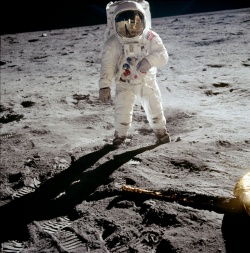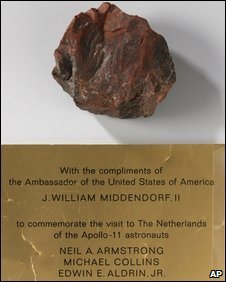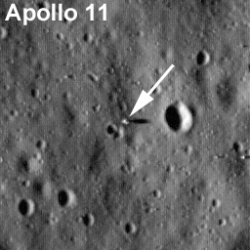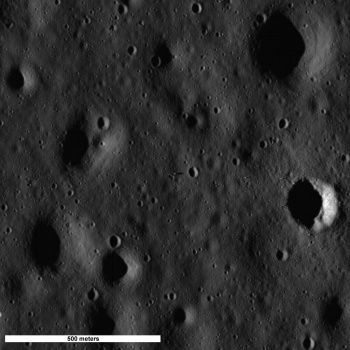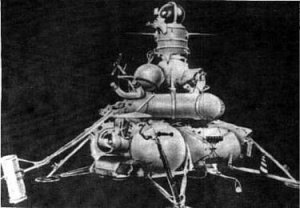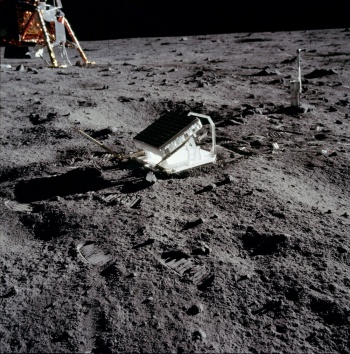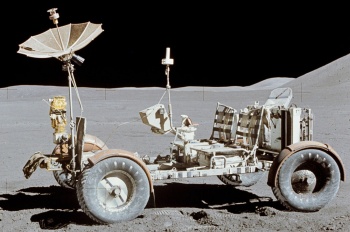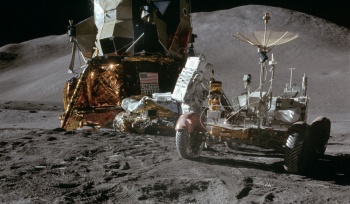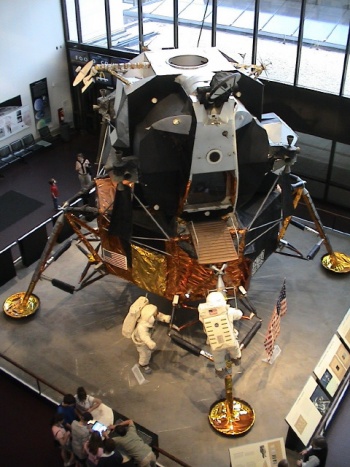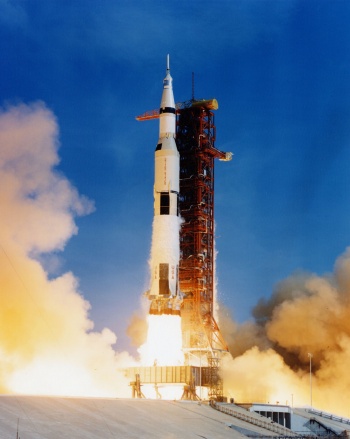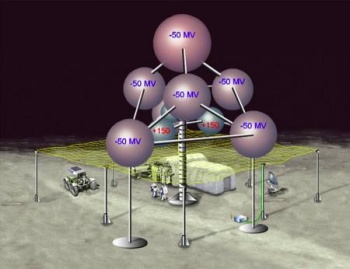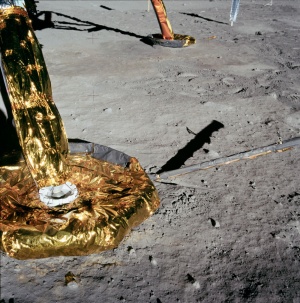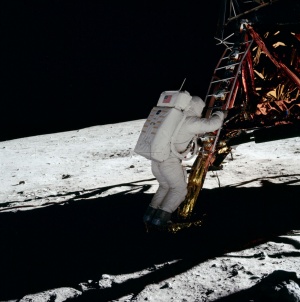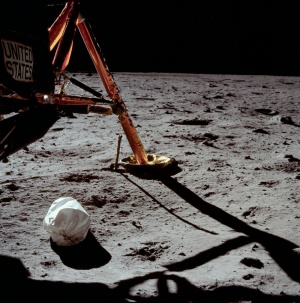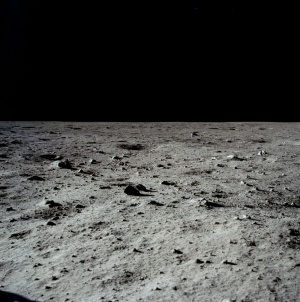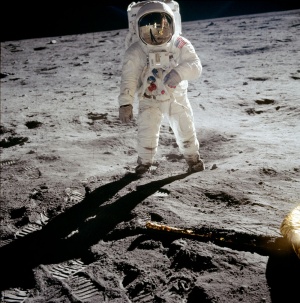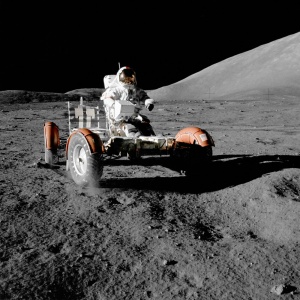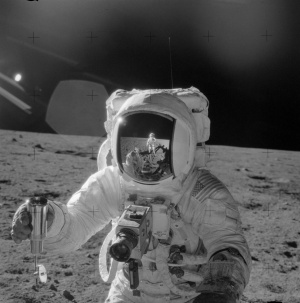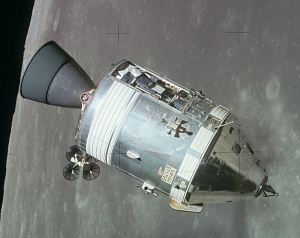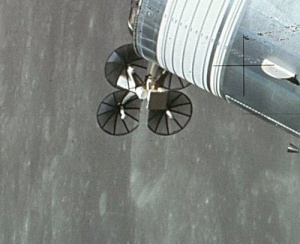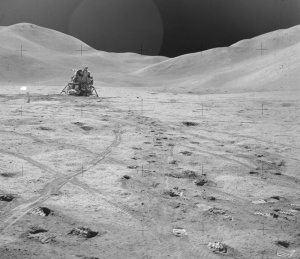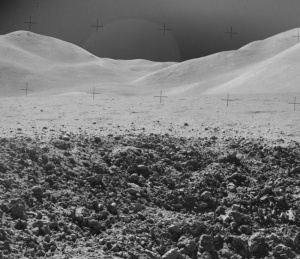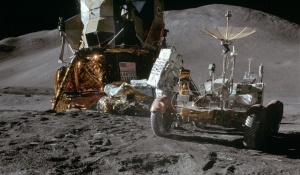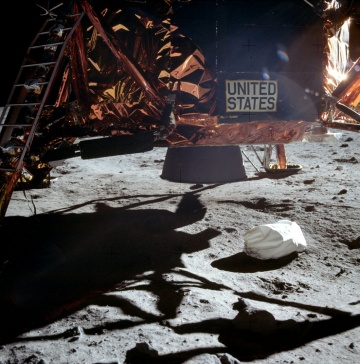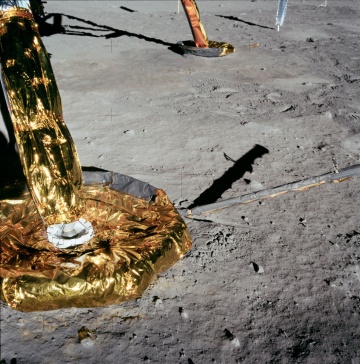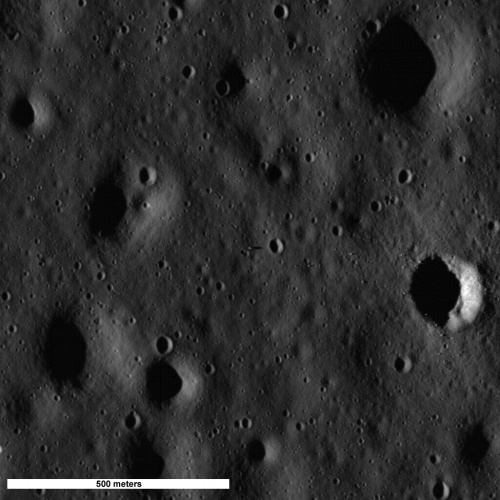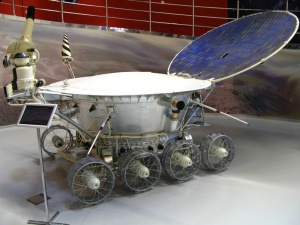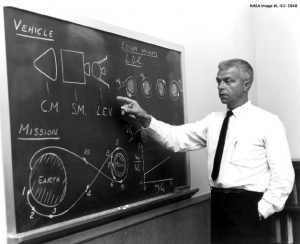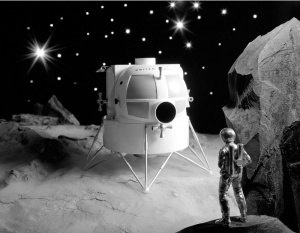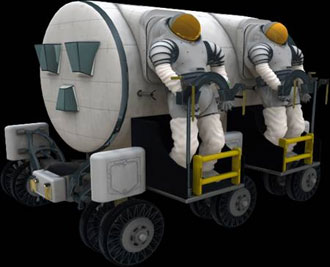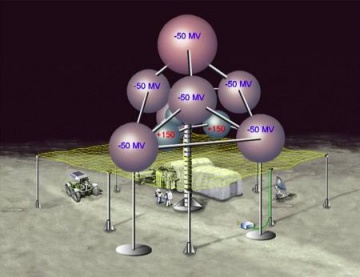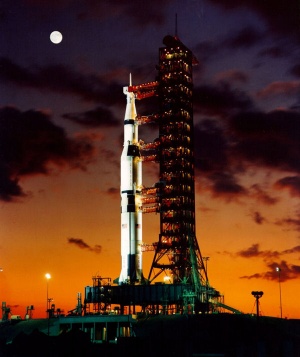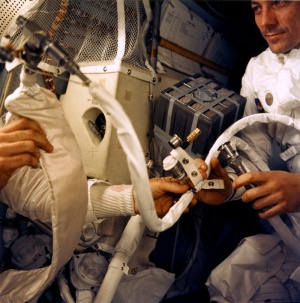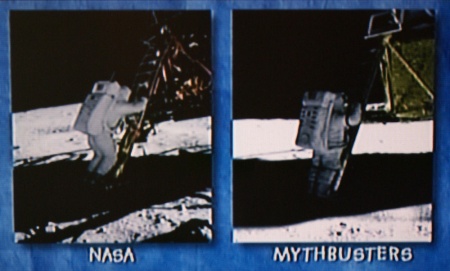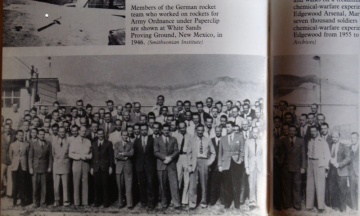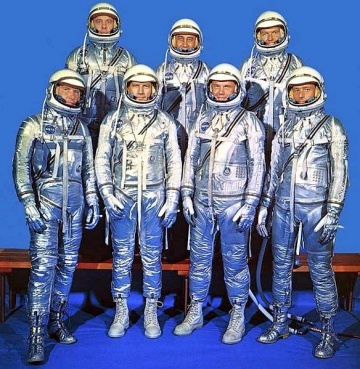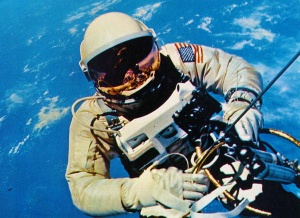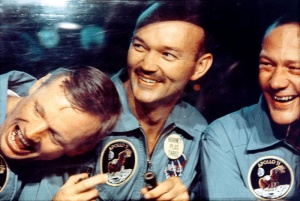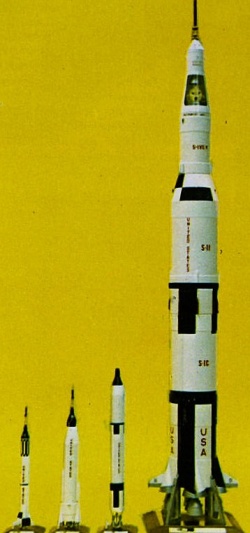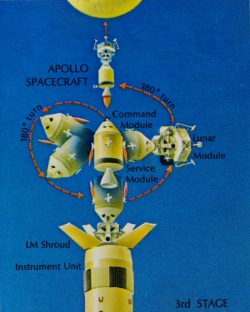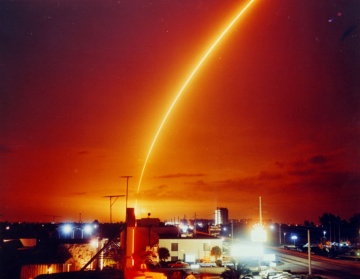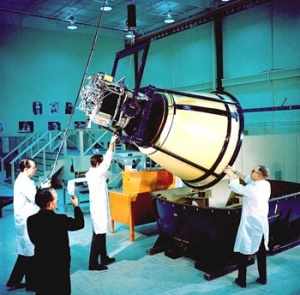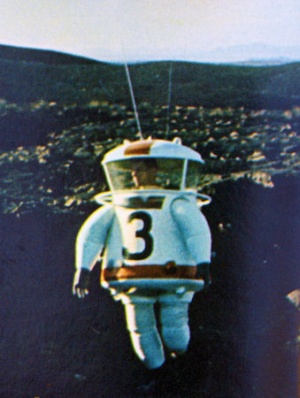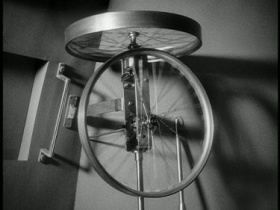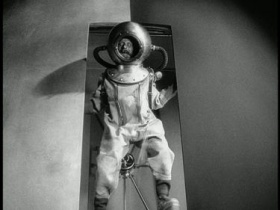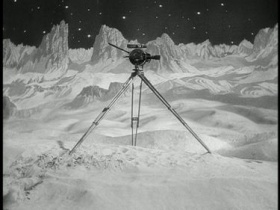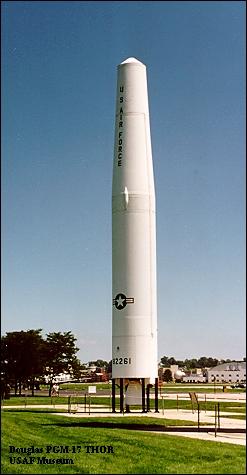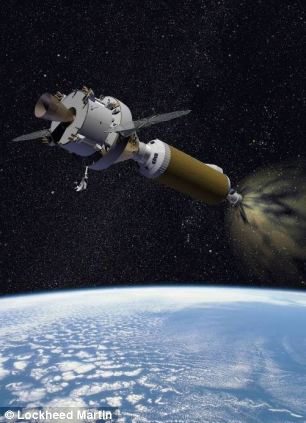Document:Wagging the Moondoggie
| A comprehensive rebuttal of the claim that man has ever set foot on the Moon |
Subjects: Moon landings
Example of: Official narrative rebuttal
Source: The Centre for an Informed America (Link)
Image right: Iconic NASA picture, allegedly of Apollo 11 Astronaut Buzz Aldrin on the surface of the Moon
Wikispooks Comment
A Dave McGowan tour-de-force written in his own entertainingly scathing and irreverant style (mind the language!).
The original study was published in fourteen separate parts between October 2009 and May 2011. Writing it was a sort of respite from his work on the 'Laurel Canyon' Rock scene of 1960's Los Angeles, to which it made a number of references, mainly by way of explanation and apology to his readers who clearly saw it as an odd diversion. This is a consolidated and abridged version of the originals with most of those references removed and with many additional sub-headings added for ease of reference and navigation (See table of contents below). Other than that it is a faithful reproduction of Dave McGowan's Apollo critique.
Author's Note
I am very well aware that there are many, many people out there – even many of the people who have seen through other tall tales told by our government – who think that Moon hoax theorists are complete kooks. And a whole lot of coordinated effort has gone into casting them as such. That makes wading into the Moon hoax debate a potentially dangerous affair.
Remember when Luther (played by Don Knotts) gets taken to court and sued for slander in The Ghost and Mr. Chicken? And don’t try to pretend like you’ve never seen it, because we both know that you have. So anyway, he goes to court and a character witness is called and the guy delivers credible testimony favoring Luther and it is clear that the courtroom is impressed and everything is looking good for our nebbish hero, Luther. Remember what happens next though? On cross-examination, the witness reveals that he is the president of a UFO club that holds their meetings on Mars!
The courtroom, of course, erupts with laughter and all of that formerly credible testimony immediately flies right out the window.
I have already received e-mails warning that I will suffer a similar fate (from people who heard me discussing the topic on Meria Heller’s radio show). Not to worry though – I have somewhat of an advantage over others who have attempted to travel this path: I don’t really care. My mission is to ferret out the truth, wherever it may lie; if at various points along the way, some folks are offended and others question my sanity, that’s not really something that I lose a lot of sleep over.
Anyway, a whole lot of people are extremely reluctant to give up their belief in the success of the Apollo missions. A lot of people, in fact, pretty much shut down at the mere mention of the Moon landings being faked, refusing to even consider the possibility (Facebook, by the way, is definitely not the best place to promote the notion that the landings were faked, in case anyone was wondering). And yet there are some among the True Believers who will allow that, though they firmly believe that we did indeed land on the Moon, they would have understood if it had been a hoax. Given the climate of the times, with Cold War tensions simmering and anxious Americans looking for some sign that their country was still dominant and not technologically inferior to the Soviets, it could be excused if NASA had duped the world.
Such sentiments made me realize that the Moon landing lie is somewhat unique among the big lies told to the American people in that it was, in the grand scheme of things, a relatively benign lie, and one that could be easily spun. Admitting that the landings were faked would not have nearly the same impact as, say, admitting to mass murdering 3,000 Americans and destroying billions of dollars worth of real estate and then using that crime as a pretext to wage two illegal wars and strip away civil, legal and privacy rights.
And yet, despite the fact that it was a relatively benign lie, there is a tremendous reluctance among the American people to let go of the notion that we sent men to the Moon. There are a couple of reasons for that, one of them being that there is a romanticized notion that those were great years – years when one was proud to be an American. And in this day and age, people need that kind of romanticized nostalgia to cling to.
But that is not the main reason that people cling so tenaciously, often even angrily, to what is essentially the adult version of Santa Claus, the Easter Bunny and the Tooth Fairy. What primarily motivates them is fear. But it is not the lie itself that scares people; it is what that lie says about the world around us and how it really functions. For if NASA was able to pull off such an outrageous hoax before the entire world, and then keep that lie in place for four decades, what does that say about the control of the information we receive? What does that say about the media, and the scientific community, and the educational community, and all the other institutions we depend on to tell us the truth? What does that say about the very nature of the world we live in?
That is what scares the hell out of people and prevents them from even considering the possibility that they could have been so thoroughly duped. It’s not being lied to about the Moon landings that people have a problem with, it is the realization that comes with that revelation: if they could lie about that, they could lie about anything.
It has been my experience that the vast majority of the people who truly believe in the Moon landings know virtually nothing about the alleged missions. And when confronted with some of the more implausible aspects of those alleged missions, the most frequently offered argument is the one that every ‘conspiracy theorist’ has heard at least a thousand times: “That can’t possibly be true because there is no way that a lie that big could have been covered up all this time … too many people would have known about it … yadda, yadda, yadda.”
But what if your own eyes and your innate (though suppressed) ability to think critically and independently tell you that what all the institutions of the State insist is true is actually a lie? What do you do then? Do you trust in your own cognitive abilities, or do you blindly follow authority and pretend as though everything can be explained away? If your worldview will not allow you to believe what you can see with your own eyes, then the problem, it would appear, is with your worldview. So do you change that worldview, or do you live in denial?
The Moon landing lie is unique among the big lies in another way as well: it is a lie that seemingly cannot be maintained indefinitely. Washington need never come clean on, say, the Kennedy assassinations. After all, they’ve been lying about the Lincoln assassination for nearly a century-and-a-half now and getting away with it. But the Moon landing hoax, I would think, has to have some kind of expiration date.
How many decades can pass, after all, without anyone coming even close to a reenactment before people start to catch on? Four obviously haven’t been enough, but how about five, or six, or seven? How about when we hit the 100-year anniversary?
If the first trans-Atlantic flight had not been followed up with another one for over forty years, would anyone have found that unusual? If during the early days of the automobile, when folks were happily cruising along in their Model T’s at a top speed of 40 MPH, someone had suddenly developed a car that could be driven safely at 500 MPH, and then after a few years that car disappeared and for many decades thereafter, despite tremendous advances in automotive technology, no one ever again came close to building a car that could perform like that, would that seem at all odd?
There are indications that this lie does indeed have a shelf life. According to a July 17, 2009 post on CNN.com, “It’s been 37 years since the last Apollo moon mission, and tens of millions of younger Americans have no memories of watching the moon landings live. A 2005-2006 poll by Mary Lynne Dittmar, a space consultant based in Houston, Texas, found that more than a quarter of Americans 18 to 25 expressed some doubt that humans set foot on the moon.”
The goal of any dissident writer is to crack open the doors of perception enough to let a little light in – so that hopefully the seeds of a political reawakening will be planted. There are many doors that can be pried open to achieve that goal, but this one seems particularly vulnerable. Join me then as we take a little trip to the Moon. Or at least pretend to. ★ Start a Discussion about this document
Wagging the Moondoggie
Contents
Part I
1 October 2009
“If NASA had really wanted to fake the moon landings – we’re talking purely hypothetical here – the timing was certainly right. The advent of television, having reached worldwide critical mass only years prior to the moon landing, would prove instrumental to the fraud’s success.” Wired Magazine
Adolph Hitler knew a little bit about the fine art of lying. In Mein Kampf, he wrote that, "If you're going to tell a lie, make sure it's a really fucking big lie."
Truth be told, I’m not exactly conversant in the German language so that may not be an exact translation, but it certainly captures the gist of what the future Fuhrer was trying to say. He went on to explain that this was so because everyone in their everyday lives tells little lies, and so they fully expect others to do so as well. But most people do not expect anyone to tell a real whopper … you know, the kind of brazen, outlandish lie that is just too absurd to actually be a lie. The kind of lie that is so over-the-top that no one would dare utter it if it was in fact a lie.
That is the type of lie, according to Hitler, that will fool the great masses of people, even when the lie is so transparently thin that it couldn't possibly stand up to any kind of critical analysis by anyone actually exercising their brain rather than just blindly accepting the legitimacy of the information they are fed. Take, for example, the rather fanciful notion that the United States landed men on the Moon in the late 1960's and early 1970's. That's the kind of lie we're talking about here: the kind that seems to defy logic and reason and yet has become ingrained in the national psyche to such an extent that it passes for historical fact.
And anyone who would dare question that ‘historical fact,’ needless to say, must surely be stark raving mad.
Before proceeding any further, I should probably mention here that, until relatively recently, if I had heard anyone putting forth the obviously drug-addled notion that the Moon landings were faked, I would have been among the first to offer said person a ride down to the grip store. While conducting research into various other topics, however, it has become increasingly apparent that there are almost always a few morsels of truth in any 'conspiracy theory,' no matter how outlandish that theory may initially appear to be, and so despite my initial skepticism, I was compelled to take a closer look at the Apollo program.
The first thing that I discovered was that the Soviet Union, right up until the time that we allegedly landed the first Apollo spacecraft on the Moon, was solidly kicking our ass in the space race. It wasn’t even close. The world wouldn’t see another mismatch of this magnitude until decades later when Kelly Clarkson and Justin Guarini came along. The Soviets launched the first orbiting satellite, sent the first animal into space, sent the first man into space, performed the first space walk, sent the first three-man crew into space, was the first nation to have two spacecraft in orbit simultaneously, performed the first unmanned docking maneuver in space, and landed the first unmanned probe on the Moon.
Everything the U.S. did, prior to actually sending a manned spacecraft to the Moon, had already been done by the Soviets, who clearly were staying at least a step or two ahead of our top-notch team of imported Nazi scientists. The smart money was clearly on the Soviets to make it to the Moon first, if anyone was to do so. Their astronauts had logged five times as many hours in space as had ours. And they had a considerable amount of time, money, scientific talent and, perhaps most of all, national pride riding on that goal.
And yet, amazingly enough, despite the incredibly long odds, the underdog Americans made it first. And not only did we make it first, but after a full forty years, the Soviets apparently still haven't quite figured out how we did it. The question that is clearly begged here is a simple one: Why is it that the nation that was leading the world in the field of space travel not only didn’t make it to the Moon back in the 1960s, but still to this day have never made it there? Could it be that they were just really poor losers? I am imagining that perhaps the conversation over in Moscow’s equivalent of NASA went something like this:
Boris: Comrade Ivan, there is terrible news today: the Yankee imperialists have beaten us to the Moon. What should we do?
Ivan: Let's just shit-can our entire space program.
Boris: But comrade, we are so close to success! And we have so much invested in the effort!
Ivan: Fuck it! If we can't be first, we aren't going at all.
Boris: But I beg of you comrade! The moon has so much to teach us, and the Americans will surely not share with us the knowledge they have gained.
Ivan: Nyet!
In truth, the entire space program has largely been, from its inception, little more than an elaborate cover for the research, development and deployment of space-based weaponry and surveillance systems. The media never talk about such things, of course, but government documents make clear that the goals being pursued through space research are largely military in nature. For this reason alone, it is inconceivable that the Soviets would not have followed the Americans onto the Moon for the sake of their own national defense.
It is not just the Soviets, of course, who have never made it to the Moon. The Chinese haven’t either. Nor has any other industrialized nation, despite the rather obvious fact that every such nation on the planet now possesses technology that is light-years beyond what was available to NASA scientists in the 1960s.
Some readers will recall that (and younger readers might want to cover their eyes here, because the information to follow is quite shocking), in the 1960s, a full complement of home electronics consisted of a fuzzy, 13-channel, black-and-white television set with a rotary tuning dial, rabbit ears and no remote. Such cutting-edge technology as the pocket calculator was still five years away from hitting the consumer market.
It is perfectly obvious, of course, that it was not consumer electronics that allegedly sent men to the Moon. The point here though is that advances in aerospace technology mirror advances in consumer technology, and just as there has been revolutionary change in entertainment and communications technology, so too has aerospace technology advanced by light-years in the last four decades. Technologically speaking, the NASA scientists working on the Apollo project were working in the Dark Ages. So if they could pull it off back then, then just about anyone should be able to do it now.
It would be particularly easy, needless to say, for America to do it again, since we’ve already done all the research and development and testing. Why then, I wonder, have we not returned to the Moon since the last Apollo flight? Following the alleged landings, there was considerable talk of establishing a space station on the Moon, and of possibly even colonizing Earth's satellite. Yet all such talk was quickly dropped and soon forgotten and for nearly four decades now not a single human has been to the Moon.
Again, the question that immediately comes to mind is: Why? Why has no nation ever duplicated, or even attempted to duplicate, this miraculous feat? Why has no other nation even sent a manned spacecraft to orbit the Moon? Why has no other nation ever attempted to send a manned spacecraft anywhere beyond low-Earth orbit?
Is it because we already learned everything there was to learn about the Moon? If so, then could it reasonably be argued that it would be possible to make six random landings on the surface of the Earth and come away with a complete and thorough understanding of this heavenly body? Are we to believe that the international scientific community has no open questions that could be answered by a, ahem, ‘return’ trip to the Moon? And is there no military advantage to be gained by sending men to the Moon? Has man’s keen interest in exploring celestial bodies, evident throughout recorded history, suddenly gone into remission?
Maybe, you say, it’s just too damned expensive. But the 1960s were not a particularly prosperous time in U.S. history and we were engaged in an expensive Cold War throughout the decade as well as an even more expensive ‘hot’ war in Southeast Asia, and yet we still managed to finance no less than seven manned missions to the Moon, using a new, disposable, multi-sectioned spacecraft each time. And yet in the four decades since then, we are apparently supposed to believe that no other nation has been able to afford to do it even once.
While we’re on the subject of the passage of time, exactly how much time do you suppose will have to pass before people in significant numbers begin to question the Moon landings? NASA has recently announced that we will not be returning, as previously advertised, by the year 2020. That means that we will pass the fifty-year anniversary of the first alleged landing without a sequel. Will that be enough elapsed time that people will begin to wonder? What about after a full century has passed by? Will our history books still talk about the Moon landings? And if so, what will people make of such stories? When they watch old preserved films from the 1960s, how will they reconcile the laughably primitive technology of the era with the notion that NASA sent men to the Moon?
Consider this peculiar fact: in order to reach the surface of the Moon from the surface of the Earth, the Apollo astronauts would have had to travel a minimum of 234,000 miles*. Since the last Apollo flight allegedly returned from the Moon in 1972, the furthest that any astronaut from any country has traveled from the surface of the Earth is about 400 miles. And very few have even gone that far. The primary components of the current U.S. space program – the space shuttles, the space station, and the Hubble Telescope – operate at an orbiting altitude of about 200 miles.
- (*NASA gives the distance from the center of Earth to the center of the Moon as 239,000 miles. Since the Earth has a radius of about 4,000 miles and the Moon’s radius is roughly 1,000 miles, that leaves a surface-to-surface distance of 234,000 miles. The total distance traveled during the alleged missions, including Earth and Moon orbits, ranged from 622,268 miles for Apollo 13 to 1,484,934 miles for Apollo 17. All on a single tank of gas.)
250 miles max distance travelled from Earth in nearly 50 years
To briefly recap then, in the twenty-first century, utilizing the most cutting-edge modern technology, the best manned spaceship the U.S. can build will only reach an altitude of 200 miles. But in the 1960s, we built a half-dozen of them that flew almost 1,200 times further into space. And then flew back. And they were able to do that despite the fact that the Saturn V rockets that powered the Apollo flights weighed in at a paltry 3,000 tons, about .004% of the size that the principal designer of those very same Saturn rockets had previously said would be required to actually get to the Moon and back (primarily due to the unfathomably large load of fuel that would be required).
To put that into more Earthly terms, U.S. astronauts today travel no further into space than the distance between the San Fernando Valley and Fresno. The Apollo astronauts, on the other hand, traveled a distance equivalent to circumnavigating the planet around the equator nine-and-a-half times! And they did it with roughly the same amount of fuel that it now takes to make that 200 mile journey, which is why I want NASA to build my next car for me. I figure I’ll only have to fill up the tank once and it should last me for the rest of my life.
“But wait,” you say, “NASA has solid evidence of the validity of the Moon landings. They have, for example, all of that film footage shot on the moon and beamed live directly into our television sets.”
Since we’re on the subject, I have to mention that transmitting live footage back from the Moon was another rather innovative use of 1960s technology. More than two decades later, we would have trouble broadcasting live footage from the deserts of the Middle East, but in 1969, we could beam that shit back from the Moon with nary a technical glitch!
'Lost' NASA tapes and spacecraft blueprints
As it turns out, however, NASA doesn’t actually have all of that Moonwalking footage any more. Truth be told, they don’t have any of it. According to the agency, all the tapes were lost back in the late 1970s. All 700 cartons of them. As Reuters reported on August 15, 2006:
“The U.S. government has misplaced the original recording of the first moon landing, including astronaut Neil Armstrong’s famous ‘one small step for man, one giant leap for mankind’ … Armstrong’s famous moonwalk, seen by millions of viewers on July 20, 1969, is among transmissions that NASA has failed to turn up in a year of searching, spokesman Grey Hautaluoma said. ‘We haven’t seen them for quite a while. We’ve been looking for over a year, and they haven’t turned up,’ Hautaluoma said … In all, some 700 boxes of transmissions from the Apollo lunar missions are missing.”
Given that these tapes allegedly documented an unprecedented and unduplicated historical event, one that is said to be the greatest technological achievement of the twentieth century, how in the world would it be possible to, uhmm, ‘lose’ 700 cartons of them? Would not an irreplaceable national treasure such as that be very carefully inventoried and locked away in a secure film vault? And would not copies have been made, and would not those copies also be securely tucked away somewhere? Come to think of it, would not multiple copies have been made for study by the scientific and academic communities?
Had NASA claimed that a few tapes, or even a few cartons of tapes, had been misplaced, then maybe we could give them the benefit of the doubt. Perhaps some careless NASA employee, for example, absent-mindedly taped a Super Bowl game over one of them. Or maybe some home porn. But does it really seem at all credible to claim that the entire collection of tapes has gone missing – all 700 cartons of them, the entire film record of the alleged Moon landings? In what alternative reality would that happen ‘accidentally’?
Some of you are probably thinking that everyone has already seen the footage anyway, when it was allegedly broadcast live back in the late 1960s and early 1970s, or on NASA’s website, or on YouTube, or on numerous television documentaries. But you would be mistaken. The truth is that the original footage has never been aired, anytime or anywhere – and now, since the tapes seem to have conveniently gone missing, it quite obviously never will be.
How the Moon-walking video was made
The fact that the tapes are missing (and according to NASA, have been for over three decades), amazingly enough, was not even the most compelling information that the Reuters article had to offer. Also to be found was an explanation of how the alleged Moonwalk tapes that we all know and love were created: “Because NASA’s equipment was not compatible with TV technology of the day, the original transmissions had to be displayed on a monitor and re-shot by a TV camera for broadcast.”
So what we saw then, and what we have seen in all the footage ever released by NASA since then, were not in fact live transmissions. To the contrary, it was footage shot off a television monitor, and a tiny black-and-white monitor at that. That monitor may have been running live footage, I suppose, but it seems far more likely that it was running taped footage. NASA of course has never explained why, even if it were true that the original broadcasts had to be ‘re-shot,’ they never subsequently released any of the actual ‘live’ footage. But I guess that’s a moot point now, what with the tapes having gone missing.
With NASA’s admission of how the original broadcasts were created, it is certainly not hard to imagine how fake Moon landing footage could have been produced. As I have already noted, the 1960s were a decidedly low-tech era, and NASA appears to have taken a very low-tech approach. As Moon landing skeptics have duly noted, if the broadcast tapes are played back at roughly twice their normal running speed, the astronauts appear to move about in ways entirely consistent with the way ordinary humans move about right here on planet Earth. Here then is the formula for creating Moonwalk footage: take original footage of guys in ridiculous costumes moving around awkwardly right here on our home planet, broadcast it over a tiny, low-resolution television monitor at about half speed, and then re-film it with a camera focused on that screen. The end result will be broadcast-ready tapes that, in addition to having that all-important grainy, ghosty, rather surreal ‘broadcast from the Moon’ look, also appear to show the astronauts moving about in entirely unnatural ways.
But not, it should be noted, too unnatural. And doesn’t that seem a little odd as well? If we’re being honest here (and for my testosterone-producing readers, this one is directed at you), the average male specimen, whether astronaut or plumber, never really grows up and stops being a little boy. And what guy, given the once-in-a-lifetime opportunity to spend some time in a reduced gravity environment, isn’t going to want to see how high he can jump? Or how far he can jump? Hitting a golf ball? Who the hell wants to see that? How about tossing a football for a 200-yard touchdown pass? Or how about the boys dazzling the viewing audience with some otherworldly acrobatics?
And yes, Neil and the guys did exhibit some playfulness at times while allegedly walking on the Moon, but doesn’t it seem a bit odd that they failed to do anything that couldn’t be faked simply by changing the tape speed? When I attended college, I knew a guy on the volleyball team who had a 32” vertical leap right here on Earth. So when I see guys jumping maybe 12”, if that, in a 1/6 gravity environment with no air resistance, I’m not really all that impressed.
Am I the only one, by the way, who finds it odd that people would move in slow motion on the Moon? Why would a reduced gravitational pull cause everything to move much more slowly? Given the fact that they were much lighter on their feet and not subject to air and wind resistance, shouldn’t the astronauts have been able to move quicker on the Moon than here on Earth? Was slow motion the only thing NASA could come up with to give the video footage an otherworldly feel?
Needless to say, if what has been proposed here is indeed how the ‘Moon landing’ footage in the public domain was created, then the highly incriminating original footage – which would have looked like any other footage shot here on Earth, except for the silly costumes and props – would have had to have been destroyed. Perhaps it’s not surprising then that NASA now takes the position that the original footage has been missing since “sometime in the late 1970s.”
'Lost' Bio-medical, telemetry and voice data
Unfortunately, it isn’t just the video footage that is missing. Also allegedly beamed back from the Moon was voice data, biomedical monitoring data, and telemetry data to monitor the location and mechanical functioning of the spaceship. All of that data, the entire alleged record of the Moon landings, was on the 13,000+ reels that are said to be ‘missing.’ Also missing, according to NASA and its various subcontractors, are the original plans/blueprints for the lunar modules. And for the lunar rovers. And for the entire multi-sectioned Saturn V rockets.
There is, therefore, no way for the modern scientific community to determine whether all of that fancy 1960s technology was even close to being functional or whether it was all for show. Nor is there any way to review the physical record, so to speak, of the alleged flights. We cannot, for example, check the fuel consumption throughout the flights to determine what kind of magic trick NASA used to get the boys there and back with less than 1% of the required fuel. And we will never, it would appear, see the original, first-generation video footage.
You would think that someone at NASA would have thought to preserve such things. No wonder we haven’t given them the money to go back to the Moon; they’d probably just lose it.
Part II
1 October 2009 “Well,” you now say, “what about all those cool Moon rocks? How did they get those? The Moon is, you know, the only source of Moon rocks, so doesn’t that prove that we were there?”
No, as a matter of fact, it does not prove that we were there, and as odd as it may sound, the Moon is not the only source of Moon rocks. As it turns out, authentic Moon rocks are available right here on Earth, in the form of lunar meteorites. Because the Moon lacks a protective atmosphere, you see, it gets smacked around quite a bit, which is why it is heavily cratered. And when things smash into it to form those craters, lots of bits and pieces of the Moon fly off into space. Some of them end up right here on Earth.
By far the best place to find them is in Antarctica, where they are most plentiful and, due to the terrain, relatively easy to find and well preserved. And that is why it is curious that Antarctica just happens to be where a team of Apollo scientists led by Wernher von Braun ventured off to in the summer of 1967, two years before Apollo 11 blasted off. You would think that, what with the demanding task of perfecting the hugely complex Saturn V rockets, von Braun and his cronies at NASA would have had their hands full, but apparently there was something even more important for them to do down in Antarctica. NASA has never offered much of an explanation for the curiously timed expedition.
Some skeptics have said that it is possible that Moon rocks could have been gathered from the Moon with robotic probes. But while it isn’t being argued here that unmanned craft haven’t reached the Moon, it seems virtually inconceivable that any unmanned spacecraft could have landed on and then been brought back from the surface of the Moon in the 1960s or 1970s. There is no indication that it can even be done today. It’s been more than three decades since anyone has claimed to do it, and that claim, by the Soviets, is highly suspect.
What is known for sure is that even some of the ‘debunking’ websites have, albeit reluctantly, acknowledged that meteorite samples gathered from Antarctica are virtually indistinguishable from NASA’s collection of Moon rocks. Of course, as we very recently learned, that is not true of all of NASA’s Moon rocks. Some of them apparently bear no resemblance at all to lunar meteorites. Instead, they look an awful lot like petrified wood from the Arizona desert.
Such was the case with a ‘Moon rock’ that the Dutch national museum has been carefully safeguarding for many years now, before discovering, in August of 2009, that they were in reality the proud owners of the most over-insured piece of petrified wood on the planet. The ‘Moon rock’ had been a gift to the Dutch from the U.S. State Department, and its authenticity had reportedly been verified through a phone call to NASA. I’m guessing that NASA was probably running low on meteorite fragments and figured the Dutch wouldn’t know the difference anyway. Or maybe Washington was a little peeved over the fact that Dutch newspapers reportedly called NASA’s bluff at the time of the first alleged Moon landing.
This is not to suggest, of course, that all of the Moon rocks passed out by NASA and the State Department are obvious fakes. Most, presumably, are of lunar origin – but that doesn’t necessarily mean they were gathered by American astronauts walking on the surface of the Moon; they could just as easily have come to Earth as meteorites. It is also possible that they are of otherworldly origin but not from the Moon at all – such as meteorites from other sources that have been collected here on Earth. The only way to know for sure what NASA’s Moon rocks are, of course, would be to compare them to a ‘control rock’ that is known to be from the Moon.
The problem, alas, is that the only known source for ‘authenticated’ Moon rocks is NASA, the very same folks who are known to occasionally hand out chunks of petrified wood. The other problem, it turns out, is that most of the Moon rocks are, uhmm, missing. Does anyone see a pattern developing here?
Since the discovery of the fake Moon rock in the Dutch museum, ‘debunkers’ have claimed that the fact that no other Moon rocks have been declared fake proves that the Dutch case is an isolated one. “After that announcement,” goes the argument, “wouldn’t every other country in possession of a Moon rock have rushed to have them authenticated? And since no other country has made a similar announcement, doesn’t that prove that the Moon rocks are real?”
At first glance, that would appear to be a valid argument. The problem, however, is that the vast majority of those countries can’t test their ‘Moon rocks’ because, shockingly enough, no one knows where they are! As the Associated Press reported on September 13, 2009, “Nearly 270 rocks scooped up by U.S. astronauts were given to foreign countries by the Nixon administration … Of 135 rocks from the Apollo 17 mission given away to nations or their leaders, only about 25 have been located by CollectSpace.com, a Web site for space history buffs that has long attempted to compile a list … The outlook for tracking the estimated 134 Apollo 11 rocks is even bleaker. The locations of fewer than a dozen are known.”
It appears then that having a ‘control rock’ wouldn’t really be of much help after all, since nearly 90% of the alleged Moon rocks that we would want to test don’t seem to be around any more.
Subsequent images of 'lunar modules' on Moon surface
“But I have also heard,” you now say, “that photos have been taken of the equipment left behind by the Apollo astronauts on the surface of the Moon, like the descent stages of the lunar modules. How do you account for that?”
It is certainly true that there have been numerous claims over the years that various satellites or unmanned space probes or space telescopes were going to capture images that would definitively prove that man walked on the Moon, thus settling the controversy once and for all. And in recent years, the ‘debunkers’ have openly gloated whenever such an announcement has been made, boldly proclaiming that all the “hoax believers” will soon be exposed as the ignorant buffoons that they are.
Despite all the promises, however, no such images have ever been produced, a fact that the ‘debunkers’ seem to conveniently overlook while forever rushing to announce that the hoax theories are about to be discredited.
For at least two decades now, since the launch of the Hubble Space Telescope, we have been promised dazzling images of the lunar modules sitting on the surface of the Moon. The Hubble technology, needless to say, never managed to deliver. More recently, in 2002, the European Southern Observatory’s Very Large Telescope (whose inventor apparently coined the name while watching Sesame Street) was also supposed to deliver the promised images. And seven years later, the fabled images have yet to materialize.
In March of 2005, Space.com boldly announced:
"A European spacecraft now orbiting the Moon could turn out to be a time machine of sorts as it photographs old landing sites of Soviet robotic probes and the areas where American Apollo crews set down and explored. New imagery of old Apollo touchdown spots, from the European Space Agency’s (ESA) SMART-1 probe, might put to rest conspiratorial thoughts that U.S. astronauts didn’t go the distance and scuff up the lunar landscape. NASA carried out six piloted landings on the Moon in the time period 1969 through 1972. Fringe theorists have said … that NASA never really went to the Moon."
I’m guessing that most “fringe theorists” will continue to harbor “conspiratorial thoughts” for as long as pompous websites like Space.com continue making arrogant proclamations such as that and then not following them up with so much as a single image in well over four years.
Who knew, by the way, that the European Space Agency had the technology and the budget to send a spacecraft off to orbit the Moon? Who knew that the Europeans even had a space agency? I wonder, given that they obviously have the technology to send spacecraft to the Moon, why they haven’t sent any manned missions there? I would think that it should be fairly easy to send some guys to at least orbit the Moon … right? I mean, all they have to do is add a couple seats to the spacecraft design that they already have and they should be ready to go.
Here is another thing that I sometimes wonder about: why it is that in the 1960s we possessed the advanced technology required to actually land men on the Moon, but in the 21st century we don’t even have the technology required to get an unmanned craft close enough to the Moon to take usable photographs? Or could it be that there’s just nothing there to photograph?
Just this year, NASA itself boldly announced that it’s
“Lunar Reconnaissance Orbiter, or LRO, has returned its first imagery of the Apollo moon landing sites. The pictures show the Apollo missions’ lunar module descent stages sitting on the moon’s surface, as long shadows from a low sun angle make the modules’ locations evident … ‘The LROC team anxiously awaited each image,’ said LROC principal investigator Mark Robinson of Arizona State University. ‘We were very interested in getting our first peek at the lunar module descent stages just for the thrill – and to see how well the cameras had come into focus. Indeed, the images are fantastic and so is the focus.’”
Sounds promising, doesn’t it? The images, however, hardly live up to the billing. They are, in fact, completely worthless. All they depict are tiny white dots on the lunar surface that could be just about anything and that would barely be visible at all without those handy “long shadows from a low sun angle.” And the weird thing about those shadows is that, in the very same NASA article, it says that “because the sun was so low to the horizon when the images were made, even subtle variations in topography create long shadows.” And yet while it is perfectly obvious that there are more than just “subtle variations” in the lunar topography in the images, the alleged lunar modules are the only things casting the long shadows.
Even if we give NASA every benefit of the doubt and assume that the images have not been amateurishly Photoshopped and that the indiscernible white dots are indeed something of man-made origin, the most likely culprit would be those Soviet robotic probes mentioned by Space.com, which presumably did land on the Moon. A number of those probes, which were part of the Apollo-era Luna Program, were very similar in size and shape to the lunar modules – certainly enough so that images of much higher resolution would be required to make a definitive judgment.
Actually, after studying the image on the right, of one of the alleged Luna probes, I’m going to have to say that the Soviets were lying their asses off almost as much as NASA was. There is no way I’m going to buy into the notion that the Soviets sent a freeform abstract sculpture, which appears to have been constructed by Fred Sanford and Granny Clampett, on a 234,000 mile journey from the Earth to the Moon. Careful study of the central area of the photo, however, does reveal why the spacecraft were known as ‘probes.’ I wonder if they were capable of performing docking maneuvers?
According to NASA, Japan and India have also sent unmanned orbiting spacecraft to the Moon in recent years, as has China. As with the ESA’s and NASA’s orbiters, they too have failed to return any images of Earthly artifacts left behind on the surface of the Moon. If the hoax ‘debunking’ websites are to be believed, by the way, the reason that no one has returned to the Moon in thirty-seven years is because we pretty much already tapped that celestial body for all the information it had to offer. There’s really, you see, nothing much left to see there.
A ‘debunking’ article posted by ABCNews.com, for example, quoted Val Germann, the president of the Central Missouri Astronomical Association, as saying, “There’s no reason to go back … Quite frankly, the moon is a giant parking lot, there’s just not much there.” I wonder why it is then that just about everyone seems to want to send unmanned probes there, or to train enormously powerful telescopes on the Moon’s surface? What could they possibly learn about the “parking lot” from those distances that our astronauts didn’t already discover by actually being there?
The 'laser-ranging experiment'
Some True Believers also claim that what was dubbed the Lunar Laser Ranging experiment also proves that we really went to the Moon. As the story goes, the astronauts on Apollo 11, Apollo 14, and Apollo 15 all allegedly left small laser targets sitting on the lunar terrain (one of them can be seen in the official NASA photo reproduced right), so that scientists back home could then bounce lasers off the targets to precisely gauge the distance from the Earth to the Moon.
According to the ‘debunkers,’ the fact that observatories to this day bounce lasers off the alleged targets proves that the Apollo missions succeeded. It is perfectly obvious though that the targets, if there, could have been placed robotically - most likely by the Soviets. It is also possible that there are no laser targets on the Moon. In December 1966, National Geographic reported that scientists at MIT had been achieving essentially the same result for four years by bouncing a laser off the surface of the Moon. The New York Times added that the Soviets had been doing the same thing since at least 1963.
The lunar module designs
There was much about the Apollo flights that was truly miraculous, but arguably the greatest technological achievement was the design of the lunar modules. Has anyone, by the way, ever really taken a good look at one of those contraptions? I mean a detailed, up-close look? I’m guessing that the vast majority of people have not, but luckily we can quickly remedy that situation because I happen to have some really good, high-resolution images that come directly from the good people at NASA.
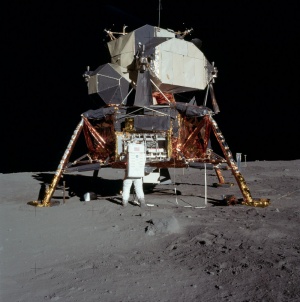 |
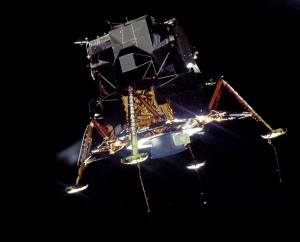
|
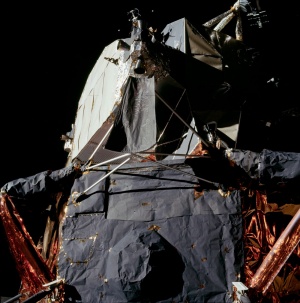 |
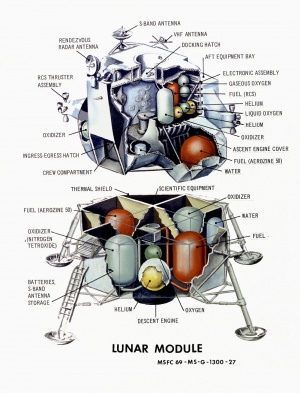
|
While what is depicted in the images may initially appear, to the untrained eye, to be some kind of mock-up that someone cobbled together in their backyard to make fun of NASA, I can assure you that it is actually an extremely high-tech manned spacecraft capable of landing on the surface of the Moon. And incredibly enough, it was also capable of blasting off from the Moon and flying 69 miles back up into lunar orbit! Though not immediately apparent, it is actually a two-stage craft, the lower half (the part that looks like a tubular aluminum framework covered with Mylar and old Christmas wrapping paper) being the descent stage, and the upper half (the part that looks as though it was cobbled together from old air conditioning ductwork and is primarily held together, as can be seen in the close-up, with zippers and gold tape) being the ascent stage.
The upper half, of course, is the more sophisticated portion, being capable of lifting off and flying with enough power to break free of the Moon’s gravity and reach lunar orbit. It also, of course, possessed sophisticated enough navigational capabilities for it to locate, literally out in the middle of fucking nowhere, the command module that it had to dock with in order to get the astronauts safely back to Earth. It also had to catch that command module, which was orbiting the Moon at a leisurely 4,000 miles per hour.
But we’ll get to all that a little later. I think we can all agree for now that such a sleek, stylish, well-designed craft would have no problem flying with that kind of power, precision and stability.
There is one thing that appears to be a problem though: how did they get everything on board the modules that they were going to need to successfully complete their missions? According to NASA, the modules were (excluding the landing pads) only about twelve feet in diameter. That is obviously not a whole lot of space to work with, so let’s try to think of everything that we would need if we were astronauts venturing off on a little journey to the Moon.
First of all, of course, we have to account for the space taken up by the various components of the ship itself. There is the framework and the, uhh, let’s call it the ‘fuselage’ of the craft. And we will need a lot of very sophisticated navigation and guidance and communications equipment, all of which took up a whole lot more space back in the ‘60s than it would today. And then, needless to say, there is the power supply – or rather multiple power supplies. For the descent stage, there is the reverse-thrust rocket that allegedly allowed the craft to make a soft landing on the Moon. And then for the ascent stage, there is a powerful rocket to propel the random bundle of sheet metal into lunar orbit. There are also additional rockets to allegedly stabilize the vessel in flight (the random clusters of what look like bicycle horns).
Next up is the massive amount of fuel that will be required to power all of those rockets, for both the ascent and descent stages of the mission. The ascent stage in particular is going to be a bit of a fuel hog, as ascending 69 miles and breaking free of the Moon’s gravity is a formidable challenge, to say the least. Though it may only have 1/6 the gravitational pull of Earth, keep in mind that it is still a force strong enough to create the tides here on Earth, 234,000 miles away.
I’m not a rocket scientist, by the way, so I am sure that there are quite a few components that I am leaving off of my lunar module – but that’s okay, because our spaceship is already feeling really cramped just with the stuff listed so far. And we’re just getting started.
Next we have to include everything required to keep ourselves alive and well. We aren’t going to be there very long, of course, and space is obviously limited, but we will still require some basic amenities. We will, after all, have to sleep somewhere in the ship, won’t we? Or will we just unfold cots on the lunar surface? We will also require a sanitation/septic system of some kind. Or did those missions bring about another ‘first’ that NASA has been reluctant to brag about? Was Neil Armstrong, unbeknownst to the American people, the first man to take a dump on lunar soil? Or was it Buzz Aldrin? Which astronaut has the distinction of being the first to soil the lunar landscape?
Anyway, getting back to our packing list, in addition to a sanitation system, it is imperative that we bring along an adequate supply of food, water and oxygen – and not just enough to last for the planned duration of our visit, but enough to supply a small safety cushion should anything go wrong. Because from what I have heard, running out of food, water or oxygen while on the Moon can really fuck up an otherwise perfectly good trip. The oxygen is especially important, so we’re going to need a really good, reliable system to deliver that oxygen, and to, you know, recharge the oxygen tanks in our spacesuits so we can walk around on the Moon and jump like 8” or 9” high like the Apollo guys did. And a back-up oxygen system probably wouldn’t be a bad idea.
We are also going to need to install a top-of-the-line heating and cooling system. Probably several of them, actually. Because the ‘weather’ on the Moon, so to speak, can be a bit unpleasant. According to the experts over at NASA, daytime highs average a balmy +260° F, but it cools off quite a bit at night, dropping to an average of -280° F. If you’re looking for anything between those two extremes, you won’t really find it on the Moon. It’s pretty much one or the other. If you’re in the sun, you’re going to be boiled alive, and if you’re out of the sun, you’re going to be flash frozen.
I’m not at all sure how the air conditioning system is going to work, come to think of it, since air conditioning requires a steady supply of – and please stop me if I am stating the obvious here – air. And the Moon doesn’t really have a lot of that.
It would help, of course, if our spacecraft was heavily insulated in some manner, but that doesn’t appear to be the case, so we’ll need a really, really good heating and cooling system, and plenty of freon or whatever it is that we’ll need to keep it running. So now we have to add all of the following to our already crowded spacecraft: ourselves; a minimal amount of room to sleep and otherwise take care of the basic necessities of life; some type of plumbing and sewage system; a really good heating and cooling system, and a considerable supply of food, water and oxygen. And we’re still not done packing for our trip.
Now we have to add all of the equipment that will be required to maintain the ship and complete our planned missions. First of all, we are definitely going to need to pack an exhaustive supply of spare parts and a wide variety of tools. That is an absolute must. From what I have heard, there are a few stores on the Moon that do stock spaceship parts, but they tend to close on certain days of the week. And orders from the mainland can take a frustratingly long time to arrive, so it’s always best to be prepared for any emergency. There are a lot of things that can go wrong with our spaceship and the only thing harder than finding a good mechanic here on Earth is finding one on the Moon.
The Moon-buggy
And then, of course, we’ll have to bring all the fancy testing equipment that we will use to pretend to conduct experiments. Some of it is quite bulky, so we’ll need to set aside some storage space for all of that. And we’re going to need some additional storage space to bring back all those petrified wood samples, but we should have room for that after we jettison most of the fake testing equipment.
Our spaceship is now so ridiculously overloaded that we may have had to add a roof-rack and we still aren’t quite done yet. We still have a couple more items to pack, and we probably should have gotten them on sooner because they are going to require a lot of space. Since this is one of the later Apollo flights, you see, we also have to pack a dune buggy, otherwise known as a lunar rover. And the rovers, according to NASA, are a full ten feet long, just two feet less than the diameter of our craft. But not to worry – according to NASA, the rovers (pictured below) folded up to the size of a large suitcase. When released, they would just sort of magically unfold and snap into place, ready to roam the lunar terrain.
To be perfectly honest, I’m not really sure why we have to pack the damn rover. There is no real compelling reason to take it to the Moon … except for the fact that they make for good TV, and that seems to be of paramount importance. And as can be seen below, it should easily fit into our spaceship.
One last thing we’re going to need is a whole lot of batteries. Lots and lots of batteries. That’s going to be the only way to power the ship while we’re on the Moon, and we’ll definitely need to run the communications systems, and the oxygen supply system, and the heating and cooling system, and the cabin lights, and the television cameras and transmitters, and all the testing equipment, and our spacesuits, and that damn rover. And we won’t be able to recharge any of the various batteries, so we’re going to need a lot of back-ups. Especially of the really big batteries that run the ship. We may need a separate ship just to carry all the batteries we’re going to need.
By the way, I can’t possibly be the only one who is disappointed that we never followed up on that breakthrough folding-vehicle technology. If we had folding Moon buggies back in the early 1970s, then how far behind could folding automobiles have been had we chosen to stay the course? Had NASA’s pioneering vision been followed up, we could all be folding up our cars and tucking them away under our office desks. But as with all the Apollo technology, it existed only in that specific period of time and has now, sadly, been lost to the ages.
The lunar module display at the NASA Museum
NASA has done something very odd, by the way, with the lunar module that it has on display for museum visitors to marvel at: it has staffed it with miniature astronauts wearing miniature space suits (the module may also be scaled slightly larger than the ‘real’ modules that allegedly landed on the Moon). I wonder why they would do that? I’m pretty sure that Buzz and Neil were of normal stature, so the only reason that I can think of that they would use miniature astronauts would be to portray the modules as larger than what they actually were. And in better condition too. Did they pick up the ones they sent to the Moon at a used car lot?
Before moving on, I need to emphasize here just how sophisticated the lunar modules actually were. These remarkable spacecraft – and I understandably get a little choked up here talking about this, because I am just so damn proud of our team of Nazi scientists – managed to make six perfect take-offs from the surface of the Moon! And understand here people that they did that, amazingly enough, with completely untested technology!
You can’t duplicate the conditions on the Moon here at home, you see, or even provide a rough approximation. And since no one had ever been to the Moon, they didn’t know exactly what to replicate anyway, so this part of the mission was pretty much of a crapshoot. Conditions on the Moon are, to say the least, a bit different than here on Earth. The gravitational pull is only about 1/6 of what it is here. And then there is that whole ‘lack of atmosphere’ thing. And the decidedly unearthly temperatures. And then, of course, there are the high levels of space radiation.
I’m quite sure that we had the best minds available working on the Apollo project, but none of them could have accurately predicted and compensated for how all those unearthly conditions would combine to affect the flight potential of the lunar modules. So the ability of the modules to actually blast off from the Moon and fly was, at best, a theoretical concept.
It is also important to remember that, unlike the initial blast-off from Earth (seen right), which involved the collective efforts of thousands of people and the use of all types of peripheral equipment, the astronauts taking off from the Moon had only themselves and a strange vessel that looked like it had been salvaged from the set of Lost in Space. What would you be thinking, by the way, if you suddenly found yourself on the surface of the Moon with what looked like a cheap movie prop as your only way home? Would you feel comfortable hanging around for a few days doing experiments, confident that, when the time came, the untested contraption behind you would actually get you back home from the Moon? Or would the words “bad career choice” be running through your head?
But as it turns out, America kicked ass back then and those lunar modules performed like champions every single time! They didn’t even need any modifications! Despite the completely foreign environment, they worked perfectly the very first time and every time thereafter!
On Earth, it took many long years of trial and error, many failed test flights, many unfortunate accidents, and many, many trips back to the drawing board before we could safely and reliably launch men into low-Earth orbit. But on the Moon? We nailed that shit the very first time.
Today, of course, we can’t even launch a space shuttle from right here on planet Earth without occasionally blowing one up, even though we have lowered our sights considerably. After all, sending spacecraft into low-Earth orbit is considerably easier than sending spacecraft all the way to the friggin’ Moon and back. It would appear then that we can draw the following conclusion: although technology has advanced immeasurably since the first Apollo Moon landing and we have significantly downgraded our goals in space, we can’t come close to matching the kick-ass safety record we had in the Apollo days.
The thing is that, back in the frontier days, we didn’t need all that fancy technology and book-learnin’ to send Buzz and the boys to the Moon and back. Back then, we had that American can-do spirit and we just cowboyed up and MacGyvered those spaceships to the Moon. All we needed was an old Volkswagen engine, some duct tape and a roll of bailing wire. Throw a roll of butt-wipe and a little Tang on board and you were good to go.
And how about the speed with which we cranked out those Apollo spacecraft? Once we figured out how to make them, we were stamping them out like Coke cans. We fired off seven of them in just under three-and-a-half years, or about one every six months. Given the extreme complexity of those vessels, and the fact that every component had to perform flawlessly under largely unknown conditions, that is a pretty impressive production schedule. America, I think it is safe to say, totally rocked back then!
Part III
1 October 2009
Why fake the moonlanding?
If the Moon landings were faked, then one question that naturally arises is: why would any government go to such extreme lengths to mount such an elaborate hoax?
The most obvious answer (and the one most frequently cited by skeptics) is to reclaim a sense of national pride that had been stripped away by America's having played follow-the-leader with the Soviets for an entire decade. While this undoubtedly played a large role, there are other factors as well – factors that haven’t been as fully explored. But before we look at those, we must first deal with the question of whether it would have even been possible to pull off such an enormous hoax.
Could so many people have really been duped into believing such an outrageous lie, if that in fact was what it was? To answer that question, we have to keep in mind that we are talking about the summer of 1969 here. Those old enough to have been there will recall that they – along with the vast majority of politically active people in the country – spent that particular period of time primarily engaged in tripping on some really good acid (most likely from the lab of Mr. Owsley).
How hard then would it really have been to fool most of you? I probably could have stuck a fish bowl on my head, wrapped myself in aluminum foil, and then filmed myself high-stepping across my backyard and most of you would have believed that I was Moonwalking. Some of you couldn't entirely rule out the possibility that everyone was walking on the Moon.
In truth, not everyone was fooled by the alleged Moon landings. Though it is rarely discussed these days, a significant number of people gave NASA’s television productions a thumbs-down. As Wired magazine has reported, “when Knight Newspapers polled 1,721 US residents one year after the first moon landing, it found that more than 30 percent of respondents were suspicious of NASA’s trips to the moon.” Given that overall trust in government was considerably higher in those pre-Watergate days, the fact that nearly a third of Americans doubted what they were ‘witnessing’ through their television sets is rather remarkable.
When Fox ran a special on the Moon landings some years back and reported that 1-in-5 Americans had doubts about the Apollo missions, various ‘debunking’ websites cried foul and claimed that the actual percentage was much lower. BadAstronomy.com, for example, claims that the actual figure is about 6%, and that roughly that many people will agree “with almost any question that is asked of them.” Hence, there are only a relative handful of kooks who don’t believe that we’ve ever been to the Moon.
All of those websites fail to mention, of course, that among the people who experienced the events as they were occurring, nearly 1-in-3 had doubts, a number considerably higher than the number that Fox used. And, needless to say, the ‘debunkers’ also failed to mention that 1-in-4 young Americans, a number also higher than the figure Fox used, have doubts about the Moon landings.
Returning then to the question of why such a ruse would be perpetrated, we must transport ourselves back to the year 1969. Richard Nixon has just been inaugurated as our brand new president, and his ascension to the throne is in part due to his promises to the American people that he will disengage from the increasingly unpopular war in Vietnam. But Tricky Dick has a bit of a problem on his hands in that he has absolutely no intention of ending the war. In fact, he would really, really like to escalate the conflict as much as possible. But to do so, he needs to set up a diversion – some means of stoking the patriotic fervor of the American people so that they will blindly rally behind him.
In short, he needs to wag the dog.
This has, of course, traditionally been done by embarking on some short-term, low-risk military endeavor. The problem for Big Dick, however, is that a military mission is exactly what he is trying to divert attention away from. What, then, is a beleaguered president to do? Why, send Neil and Buzz to the Moon, of course! Instead of wagging the dog, it's time to try something new: wagging the Moondoggie!
Nixon's actions from the very moment he takes office belie his campaign pledges to the American people (not unlike that Barry Obama guy, who also led the American people to believe that he opposed an unpopular war). In May of 1969, with Nixon just a few months into his term, the press begins publicizing the illegal B-52 carpetbombing of Cambodia engineered by that irrepressible war criminal, Henry Kissinger. By June, Nixon is scrambling to announce what is dubbed the 'Vietnamization' of the war, which comes with a concomitant withdrawal of U.S. troops.
In truth, however, only 25,000 of the 540,000 U.S. troops then deployed will be brought home. This ruse is, therefore, transparently thin and it will buy the new president little time. To make matters worse, on July 14th, Francis Reitemeyer is granted Conscientious Objector status on the basis of a petition his attorney has filed which explicitly details the training and instruction he has just received in assassination and torture techniques in conjunction with his assignment to the CIA’s Phoenix Program. With these documents entering the public domain, the full horrors of the war are beginning to emerge.
Just in time to save the day, however, Apollo 11 blasts off on July 16th on its allegedly historic mission, and – with the entire nation enthralled – four days later the Eagle purportedly makes its landing on the pristine lunar surface. Vietnam is temporarily forgotten as America swells with patriotic pride for having beaten the Evil Empire to the Moon. There is little time to worry about the brutality of war when Neil is taking that “one giant leap for mankind.”
The honeymoon is short-lived, however, for just four months later, in November of 1969, Seymour Hersch publishes a story about the massacre of 504 civilians in the village of My Lai, bringing home to America the full savagery of the war in Southeast Asia. It's time then for another Moon launch, and Apollo 12 dutifully lifts off on November 14th, making another picture-perfect lunar landing before returning on November 24th. The country is once again entranced by the exploits of America's new breed of hero, and suddenly every kid in the country wants to grow up to be an astronaut.
All is well again until March of 1970, at which time a U.S.-backed coup deposes Prince Sihanouk in Cambodia and Lon Nol is handpicked by the CIA to replace him. Cambodia then immediately jumps in the fray by committing troops to the U.S. war effort. The war is further escalated the next month when Nixon authorizes an invasion of Cambodia by U.S. and ARVN ground forces, another move engineered by Henry Kissinger. Nixon has been in office just over a year and the war, far from winding down, has now expanded into Cambodia both in the air and on the ground.
Apollo 11 near-disaster
Meanwhile, it's time for yet another Moon launch. But this one is not going to be just any Moon launch. This one, you see, is going to introduce the element of danger. With the first two having gone off without a hitch, the American people – known for having notoriously short attention spans – are already adopting a 'been there, done that' attitude. The problem, in a nutshell, is that it looks just a little too damn easy. In order to regain the attention of the American people, it has to be impressed upon them that our brave astronauts are placing themselves in grave danger.
And so it is that on April 11th, 1970, Apollo 13 blasts off with Tom Hanks and a couple of somewhat lesser known actors on board, but unlike the first two missions, this Apollo spacecraft fails to reach the Moon and instead drifts about for the next six days with the crew in mortal danger of being forever lost in space! Now that gets our attention! So much so that when three Vietnam vets hold a multi-city press conference in New York, San Francisco and Rome on April 14th, attempting to publicize the ongoing Phoenix Program in which they have participated and have firsthand knowledge, nobody can really be bothered with paying much attention. It's hard to be too concerned about the fate of Vietnamese villagers, you see, when Tom and the boys are clearly in trouble.
Awaiting news of the fate of the Apollo 13 crew, we all have our eyes glued to our TVs as though we are watching postmortem coverage of Michael Jackson. When our heroes somehow make it back alive, defying seemingly impossible odds, we are all so goddamned proud of them that we decide to award Tom another Oscar. And all is well again for the remainder of the year.
I really have to repeat here, by the way, that in the late 1960s and early 1970s, America really did rock! I mean, how about that Apollo safety record? Seven manned Moon launches with seven perfect take-offs! Tom and the boys obviously never did make it to the Moon, but the other six crews sure as hell did, and all six set those lunar modules down like the consummate professionals that they were, and all six used that untested technology to successfully blast off from the Moon and attain lunar orbit, and then all six successfully docked with the orbiting command modules. And all seven of those command modules, even Apollo 13’s, returned intact and with their crews happy and healthy.
That was just an awesome time to be an American and especially to be an American astronaut … well, except for the three guys (Virgil “Gus” Grissom, Ed White and Roger Chaffee) who were burned alive during a test procedure in the command module of what was to be the Apollo 1 rocket. But they were troublemakers anyway who probably wouldn’t have wanted to go along with the Moon landing fable. And then there was that Thomas Baron guy who was a safety inspector for NASA and who delivered highly critical testimony and a 1,500-page report to Congress, only to then be killed a week later. That report seems to have been sucked into the same Black Hole that swallowed up all the other Apollo evidence.
Anyway, returning now to our timeline, the dawn of 1971 brings the trial of Lt. William Calley on charges that he personally ordered and oversaw the mass murder of the inhabitants of the village of My Lai. And on January 31st, Apollo 14 is launched and once again makes a flawless lunar landing. On February 9th, the Apollo team returns, just a few weeks before Calley is convicted of murder (he served an absurdly short sentence under ‘house arrest’ and none of his superiors were ever held accountable).
A few months after that, the New York Times begins publication of the infamous Pentagon Papers, revealing American policy in Vietnam to be a complex web of lies. Publication is quickly stopped by the Justice Department but resumes once again as June turns to July. This is quickly followed, on July 26th, by the launch of Apollo 15. Four days later, yet another flawless lunar landing clearly demonstrates that America is the most bad-ass nation on Earth. But Moonwalking has become a bit of a bore for the American people, so a new element is introduced and from now on our beloved astronauts will roam the lunar surface in dune buggies. The lunar modules haven’t gotten any bigger, but now they can transport vehicles to the Moon. Cool!
Back on Earth, the astronauts return on August 7th and the rest of the year passes uneventfully. On March 30, 1972, North Vietnamese troops mount a massive offensive across the DMZ into Quang Tri Province, revealing as lies the pompous statements by numerous Washington hacks that victory is close at hand. Nixon and Co. respond to the offensive with deep penetration bombing of North Vietnam and, for good measure, the illegal mining of North Vietnam's ports. They also respond by launching, on April 16th, another rocket (and another dune buggy) to the Moon. On April 27th, the crew of Apollo 16 once again return to a hero's welcome.
By the end of the year, a ceasefire is finally looming on the horizon. Beginning in October, Kissinger and David Bruce (a member of the infamous Mellon family) are secretly negotiating peace terms with Le Duc Tho of North Vietnam. In December, however, those talks break down – but not before Apollo 17 is launched on December 7th in a most spectacular way: it is the first night launch of a Saturn V rocket. With the latest Apollo mission still a few days away from returning, the talks cease and Dick and Henry unleash a final ruthless carpetbombing campaign against North Vietnam, snuffing out countless thousands of civilian lives. Meanwhile, America warmly greets its returning astronauts.
Just five weeks later, the talks having resumed, a peace agreement is announced. Within a few days a ceasefire is in effect, thereby officially ending America's involvement in Southeast Asia. Though the CIA will remain to continue directing the war by proxy, America's men and women in uniform come home. And the Apollo program – despite several additional missions having been planned and discussed, and despite the additional funding that should have been available with the war drawing to a close – will never be heard from again.
In addition to restoring national pride and providing a diversion from the savage colonial war being waged in Southeast Asia, the Apollo program undoubtedly served another function as well: covert funding of that war effort. Needless to say, faking Moon landings is less expensive than actually making Moon landings, and a whole lot of money was funneled NASA’s way during the Vietnam years to accomplish the latter. It stands to reason that a considerable amount of that money could well have been diverted into covert operations being conducted in Vietnam, Cambodia and Laos. In addition, a portion of the Apollo funding likely financed the early stages of the militarization of space.
The Van Allen radiation belts
There is no shortage of Moon hoax ‘debunking’ sites out there on the wild and wooly World Wide Web. The majority of them are not particularly well written or argued and yet they tend to be rather smug and self-congratulatory. Most of them tend to stick to ‘debunking’ the same facts and they use the same arguments to do so.
One thing they like to talk a lot about is the Van Allen radiation belts. The Moon hoax sites talk a lot about them as well. The hoaxers will tell you that man cannot pass through the belts without a considerable amount of radiation protection – protection that could not have been provided in the 1960s through any known technology. And the ‘debunkers’ claim that the Apollo astronauts would have passed through the belts quickly enough that, given the levels of radiation, no harm would have come to them. The hoaxers, say the ‘debunkers,’ are just being girlie men.
As it turns out, both sides are wrong: the ‘debunkers,’ shockingly enough, are completely full of shit, and the hoaxers have actually understated the problem by focusing exclusively on the belts. We know this because NASA itself – whom the ‘debunkers’ like to treat as a virtually unimpeachable source on all things Apollo, except, apparently, when the agency posts an article that implicitly acknowledges that we haven’t actually been to the Moon – has told us that it is so. They have told us that in order to leave low-Earth orbit on any future space flights, our astronauts would need to be protected throughout the entirety of the flight, as well as – and once again, this comes directly from NASA – while working on the surface of the Moon.
On June 24, 2005, NASA made this rather remarkable admission:
“NASA's Vision for Space Exploration calls for a return to the Moon as preparation for even longer journeys to Mars and beyond. But there's a potential showstopper: radiation. Space beyond low-Earth orbit is awash with intense radiation from the Sun and from deep galactic sources such as supernovas … Finding a good shield is important.” (http://science.nasa.gov/headlines/y2005/24jun_electrostatics.htm)
You’re damn right finding a good shield is important!! Back in the 1960s, of course, we didn’t let a little thing like space radiation get in the way of us beating the Ruskies to the Moon. But now, I guess, being that we are more cultured and sophisticated, we want to do it the right way so we have to come up with some way of shielding our spaceships. And our temporary Moon bases. And figuring out how to do that, according to NASA, could be a real “showstopper.”
As NASA notes, “the most common way to deal with radiation is simply to physically block it, as the thick concrete around a nuclear reactor does. But making spaceships from concrete is not an option.” Lead, which is considerably denser than concrete, is actually the preferred material to use for radiation shielding, but lead also isn’t very popular with spaceship designers. In fact, word on the street is that one of the main reasons the Soviets never made it to the Moon was because their scientists calculated that four feet of lead shielding would be required to protect their astronauts, and those same scientists apparently felt that spaceships wouldn’t fly all that well when clad in four feet of lead.
Now NASA is thinking outside the box and contemplating using ‘force fields’ to repel the radiation, a seemingly ridiculous idea that, whether workable in the future or not, certainly wasn’t available to NASA in the 1960s. Below is NASA’s own artist rendering of a proposed ‘force field’ radiation shield that would allow astronauts to work safely on the Moon. As you may have noticed in the earlier photos of the lunar modules, our guys didn’t bring anything like that with them on their, uhmm, earlier missions to the Moon. And you may have also noticed that the modules did not have any type of physical shielding.
How then did they do it? My guess is that the answer lies in that gold foil wrap. While it may look like an amateurish attempt to make the modules appear more ‘high-tech,’ I have a hunch that what we are looking at is another example of the lost technology of the 1960s – this time in the form of a highly-advanced superpolymer that provided maximum radiation shielding while adding virtually no weight. So all we have to do is track down a few leftover rolls of that stuff and we should be well on our way to sending guys back to the Moon.
According to Charles Buhler, a NASA scientist currently working on the force field concept, “Using electric fields to repel radiation was one of the first ideas back in the 1950s, when scientists started to look at the problem of protecting astronauts from radiation. They quickly dropped the idea though because it seemed like the high voltages needed and the awkward designs that they thought would be necessary … would make such an electric shield impractical.”
What a real journalist would have asked here, of course, is:
“After dropping the electric shield concept, exactly what did they decide to use to get our astronauts safely to the Moon and back on the Apollo missions? And why can’t we do the same thing now, rather than reinventing the wheel? Don’t you guys have some of that gold foil in a closet somewhere?”
No one in the American media, of course, bothered to ask such painfully obvious questions.
The 2005 report from NASA ends as follows: “But, who knows, perhaps one day astronauts on the Moon … will work safely.” Yes, and while we’re dreaming the impossible dream, let’s add a few more things to our wish list as well, like perhaps one day we’ll be able to listen to music on 8-track tape players, and talk to people on rotary dial telephones, and carry portable transistor radios, and use cameras that shoot pictures on special film that develops right before our eyes. Only time will tell, I suppose.
The Van Allen belts, by the way, trap most Earth-bound radiation, thus making it safe for us mortals down here on the surface of planet Earth, as well as for astronauts in low-Earth orbit (the belts extend from 1,000 to 25,000 miles above the surface of the Earth). The danger is in sending men through and beyond the belts, which, apart from the Apollo missions, has never been attempted … well, actually there was that one time, but I think we all remember how badly that turned out. In case anyone has forgotten, the astronauts returned to a world dominated by extremely poor acting, apes speaking with British accents, and a shirtless Charleton Heston. And I don’t think anyone wants to see that happen again.
The 2005 report was not the first time that NASA had openly discussed the high levels of radiation that exist beyond the Van Allen belts. In February 2001, the space agency posted a ‘debunking’ article that argued that the rocks allegedly brought back from the Moon were so distinctive in nature that they proved definitively that man had gone to the Moon. The problem though with maintaining a lie of the magnitude of the Moon landing lie is that there is always the danger that in defending one part of the lie, another part will be exposed. Such was the case with NASA’s ill-conceived The Great Moon Hoax post, in which it was acknowledged that what are referred to as “cosmic rays” have a tendency to “constantly bombard the Moon and they leave their fingerprints on Moon rocks.” [Ed Note: NASA have since removed this post from their webs site. It is available from The Way-Back Machne here ]
NASA scientist David McKay explained that “There are isotopes in Moon rocks, isotopes we don’t normally find on Earth, that were created by nuclear reactions with the highest-energy cosmic rays.” The article went on to explain how
“Earth is spared from such radiation by our protective atmosphere and magnetosphere. Even if scientists wanted to make something like a Moon rock by, say, bombarding an Earth rock with high energy atomic nuclei, they couldn’t. Earth’s most powerful particle accelerators can’t energize particles to match the most potent cosmic rays, which are themselves accelerated in supernova blastwaves and in the violent cores of galaxies.”
So one of the reasons that we know the Moon rocks are real, you see, is because they were blasted with ridiculously high levels of radiation while sitting on the surface of the Moon. And our astronauts, one would assume, would have been blasted with the very same ridiculously high levels of radiation, but since this was NASA’s attempt at a ‘debunking’ article, they apparently would prefer that you don’t spend too much time analyzing what they have to say.
How exactly are we to reconcile NASA’s current position on space radiation with the same agency’s simultaneous claim that we have already sent men to the Moon? There are a few different possibilities that come to mind, the first of which is that, in the late 1960s and early 1970s, we simply threw caution to the wind and sent our boys off to the Moon with no protection whatsoever from space radiation. If that were true, however, then the question that would naturally be raised is: why not just do it again? After all, all of our Moonwalkers made it home safe and sound and most all have lived long, healthy, cancer-free lives. So why all the fuss over space radiation?
NASA could, I suppose, take the position that space radiation is a recent problem. Perhaps in the ‘60s and early ‘70s, space was relatively free of radiation, allowing unshielded Apollo rockets to cruise about without a care in the world while crew members primarily busied themselves with such important tasks as trying to capture all the stems and seeds that were floating around the command module as a result of cleaning their stash of low-grade ‘60s marijuana. It was just a different solar system back in those days. As aging hippies like to say, if you remember the solar system of the sixties, you weren’t really flying around in it.
If it proves not to be the case that this space radiation “showstopper” is a new development, then I suppose that the only explanation that we are left with is that we did indeed have the technology to shield our astronauts from radiation back in the 1960s, but at some time during the last four decades, that technology was simply lost. What probably happened was that an overzealous night custodian simply threw the data away. The conversation around the NASA water cooler the next day probably went something like this:
"Holy shit! Has anyone seen that folder that I left on my desk last night? It contained the only copy of the secret formula that I devised for building a weightless space radiation shield. It could be forty years or more before someone else can duplicate it! My ass is so fired!”
Part IV
1 October 2009
"Once on the Moon, on the lunar surface in the dress, in the life support system, you couldn't see the camera. They couldn't bend their head that far down to see the scale ... They had no viewfinder - they had to aim by moving their body."
Jan Lundberg, chief designer of the Hasselblad cameras allegedly used by the Apollo astronauts"They had to effectively guess where they were pointing the camera."
HJP Arnold, the Kodak executive who supplied the Ektachrome film for the missions
Photography tutorials and experiments
The issue that most of the Moon hoax and ‘debunking’ sites spend the most time on, by far, is the photographic anomalies. And that, I suppose, is to be expected, since with the original videotapes, telemetry tapes and blueprints all having conveniently disappeared, and with most of the Moon rocks missing and their legitimacy being unverifiable, there isn’t much else in the way of physical evidence to examine.
Skeptics have identified a number of problems with NASA’s official photographs of the alleged Moon landings, including; flags appearing to wave despite the lack of atmosphere; non-parallel shadows, suggesting multiple light sources; objects in the shadows that are clearly visible when they shouldn’t be, again indicating multiple light sources; the complete lack of stars in the lunar sky; identical backgrounds in photos that NASA has claimed were shot at different locations; and inconsistencies with the crosshair reference marks.
We will look at each of these in some detail – well, actually we will look at most of them in some detail. Because as it turns out – and I know that this will come as a huge disappointment to all the ‘debunkers’ – I don’t really give a shit whether the flag is waving or not. Many of the ‘debunking’ websites devote an inordinate amount of time to the issue, as though it were the primary plank on which the ‘conspiracy theories’ rested. They do this because the videos and photos are ambiguous and open to interpretation, and the ‘debunkers’ realize that people are going to see in them what they want to see.
The truth though is that it does not matter in the least whether the flag is waving. That is just one tiny drop of potential evidence in an overflowing bucket.
Some of the other problems with the images are considerably less ambiguous. But before we even get to those, we must first discuss the fact that the very existence of the photographs is a technical impossibility. Simply stated, it would not have been possible to capture any of the images allegedly shot on the Moon in the manner that NASA says they were captured.
Back in the day, you see (and younger readers may again want to cover their eyes), cameras weren’t all that smart, so everything had to be done manually. The photographer had to manually focus each shot by peering through the viewfinder and rotating the lens until the scene came into focus. The proper aperture and shutter speeds had to be manually selected for each shot as well, to insure a proper exposure. That required peering through the viewfinder as well, to meter the shot. Finally, each shot had to be properly composed and framed, which obviously also required looking through the viewfinder.
The problem for the astronauts is that the cameras were mounted to their chests, which made it impossible to see through the viewfinder to meter, frame and focus the shots. Everything, therefore, was pretty much of a guess. Focusing would have been entirely guesswork, as would the framing of each shot. An experienced photographer can accurately estimate the exposure settings, but the astronauts lacked such experience and they were also handicapped by the fact that they were viewing the scenes through heavily tinted visors, which meant that what they were seeing was not what the camera was seeing.
To add to their troubles, they were wearing space helmets that seriously restricted their field of vision, along with enormously bulky, pressurized gloves that severely limited their manual dexterity. The odds then of getting even one of the three elements (exposure, focus and framing) correct under those conditions on any given shot would have been exceedingly low. And yet, amazingly enough, on the overwhelming majority of the photos, they got all three right!
A rather self-important gent by the name of Jay Windley, one of the most prominent of the NASA-approved ‘debunkers,’ attempts to spin all this away on his website, www.clavius.org. According to Windley, “The exposures were worked out ahead of time based on experimentation. The ASA/ISO rating of the film was known, and NASA photographers precomputed the necessary exposures … In many cases the camera settings for planned photos were given in the astronauts’ cuff checklists.”
No shit, Jay? Did they send an advance team to the Moon to do that “experimentation”? Because the lighting conditions on the Moon are pretty unique, as you well know, and nobody had ever been there before, so I’m not really seeing how NASA’s photographers were able to work the exposures out “ahead of time.” And what “planned photos” are you referring to? How did they know what they were going to photograph before they even knew what was there? They knew they were going to take photos of each other, I suppose, and of the flag and lander, but they would have had no clue how those things were going to be lit, and it’s the lighting, not the subject, that primarily determines the exposure settings.
Windley of course knows that, since he claims on his site that he is “an experienced photographer [who] has worked professionally in that area from time to time.” He must also know then that his comments about the unimportance of properly focusing a shot are intentionally misleading. He starts off on the right track, more or less, advising readers that an increased depth of field “means that when the lens is set to focus at a certain distance, objects somewhat nearer and farther from this ideal distance are also sharply focused. The narrower the aperture, the greater the depth of field.”
It is certainly true that the smaller the aperture, the greater the depth of field will be. And the greater the depth of field, the more of the background and foreground will be in focus, assuming that the subject is in proper focus. Windley, like the rest of the ‘debunkers,’ would like us to believe that all of the photos shot on the lunar surface were shot with a very small aperture setting (which supposedly explains the lack of stars in the lunar sky, but we’ll get to that soon enough), which would maximize the depth of field. And the greater the depth of field, according to Windley, “the sloppier the photographer can be about his focus settings.”
That last statement, for those who may have missed it, is the part that isn’t actually true. An increased depth of field most certainly does not mean that you can use the ‘close enough’ technique to focus your camera. Depth of field has nothing to do with whether your subject is sharply focused or not. If your subject is sharply focused, then depth of field determines how many of the other objects in the background and foreground of your photo will be in focus as well. If your subject is not sharply focused, however, then your photo is going to suck regardless of the amount of depth of field.
As for framing the shots, Windley claims that mostly wide-angle lenses were used, which meant that, “It was sufficient to point the camera in the general direction of the subject and you would be likely to frame it well enough.” So apparently all the fuss about framing, exposure and focus is much ado about nothing. All you need do is write the exposure settings down on your sleeve, ballpark the focus, and point your camera in “the general direction of the subject” and you’ll get great shots nearly every time!
Windley then adds (and this is my favorite part of his photography tutorial) that on the later missions:
“a 500mm telephoto lens was also taken, and the cameras were modified with sighting rings to help aim them. Normally the camera would be mounted on the space suit chest bracket, but for telephoto use the astronaut would have to remove it and hold it at eye level in order to sight down the rings.”
As any photographer knows, getting a decent shot with a 500mm lens without the use of a tripod is a pretty tall order, even for a seasoned professional. Getting a decent hand-held shot with a 500mm lens while wearing bulky, pressurized gloves would be just about impossible. And the notion that you could come anywhere close to properly framing or focusing an image captured with a 500mm lens without looking through the viewfinder is laughably absurd.
The ‘debunkers’ will also tell you that it is not true that all the Moon landing images were keepers, and that NASA only released the best of the photos. The ‘debunkers,’ however, don’t know what they are talking about. The reality is that NASA has released all of the alleged photos taken during the Apollo missions, including indecipherable ones that are labeled “inadvertent shutter release” (which, I have to admit, is a nice touch). With the exception of what are most likely deliberate mistakes, the clear majority of the shots are pretty well composed, exposed and focused.
For those who don’t find that at all unusual, here is an experiment that you can try at home: grab the nearest 35MM SLR camera and strap it around your neck. It is probably an automatic camera so you will have to set it for manual focus and manual exposure. Now you will need to put on the thickest pair of winter gloves that you can find, as well as a motorcycle helmet with a visor. Once you have done all that, here is your assignment: walk around your neighborhood with the camera pressed firmly to your chest and snap a bunch of photos. You will need to fiddle with the focus and exposure settings, of course, which is going to be a real bitch since you won’t be able to see or feel what you are doing. Also, needless to say, you’ll just have to guess on the framing of all the shots.
You should probably use a digital camera, by the way, so that you don’t waste a lot of film, because you’re not going to have a lot of keepers. Of course, part of the fun of this challenge is changing the film with the gloves and helmet on, and you’ll miss out on that by going digital. Anyway, after you fill up your memory card, head back home and download all your newly captured images. While looking through your collection of unimpressive photos, marvel at the incredible awesomeness of our Apollo astronauts, who not only risked life and limb to expand man’s frontiers, but who were also amazingly talented photographers. I’m more than a little surprised that none of them went on to lucrative careers as professional shutterbugs.
Even if our fine astronauts could have captured all of those images, the film would have never survived the journey in such pristine condition. Even very brief exposure to the relatively low levels of radiation used in airport security terminals can damage photographic film, so how would the film have fared after prolonged, continuous exposure to far higher levels of radiation? And what of the 540° F temperature fluctuations? That must have been some amazingly resilient film stock – and yet another example of the lost technology of the 1960s.
Even though the images are clearly not what NASA claims they are, we are going to play along and pretend as though Neil and Buzz and all of the rest of the guys could have actually taken them. The question then is: where did they take them?
Hoax theorists, ‘debunkers’ and NASA are all in agreement on at least one thing: conditions on the surface of the Moon are decidedly different than conditions here on the surface of planet Earth. For one thing, the Moon has no atmosphere. Also, there is only one source of light, which is, of course, the sun (NASA has verified that no other light source was available to the astronauts).
Due to the lack of atmosphere on the Moon, light is not scattered and travels only in a straight line from the sun and is reflected back in the same direction. What that means is that anything that falls in the shadows will be in virtually complete darkness. It also means that all shadows will be cast in the same direction. And it means that the sky is always black, and, with no atmosphere filtering the view, that sky will be filled at all times with a dazzling display of stars unlike anything ever before seen by man.
No stars
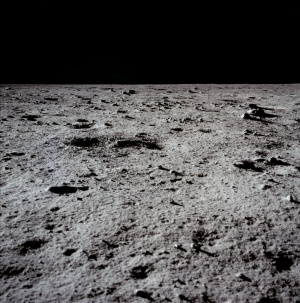 |
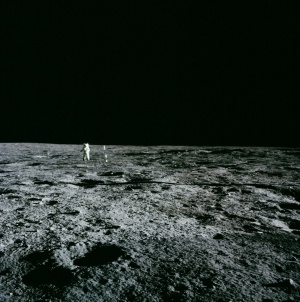
|
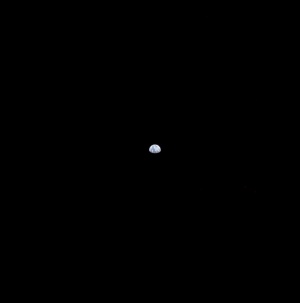 |
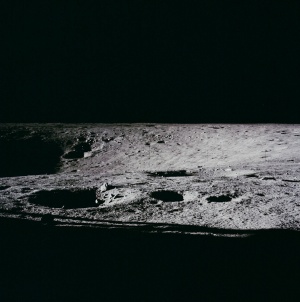
|
As other skeptics have noted, none of the photos supposedly brought home from the Moon show a single star in the sky. ‘Debunkers’ have claimed that this is because the exposure settings on the cameras didn’t allow for the stars to be captured on film. In order to properly expose for the objects being photographed, ‘debunkers’ claim, shutter speeds had to be too fast and apertures too small to capture the stars. And that applies, according to the ‘debunkers,’ to every single photo taken on the Moon. Even all the ones that, according to those same ‘debunkers,’ were improperly exposed!
NASA’s own website has boldly stated that, “Astronauts striding across the bright lunar soil in their sunlit spacesuits were literally dazzling. Setting a camera with the proper exposure for a glaring spacesuit would naturally render background stars too faint to see.”
The problem with this claim, which should be obvious to any photographer, is that a variety of different exposure settings would have been required to shoot all the photos allegedly taken on the Moon (Windley acknowledged as much when he claimed that NASA “precomputed the necessary exposures”). All of the scenes below, for example, which are obviously not very well lit, would have required long exposures – exposures that would have definitely captured the brilliantly shining stars, since they would have been the brightest objects in the camera’s field of view.
One thing that I love about the ‘debunking’ websites, by the way, is how frequently they contradict themselves while working their way through their ‘debunking’ checklists. The ever-pompous Phil Plait, proprietor of the appropriately named BadAstronomy.com website, is a prime example. Fairly early on in his ‘debunking’ rant, he writes as follows: “I’ll say this here now, and return to it many times: the Moon is not the Earth. Conditions there are weird, and our common sense is likely to fail us.”
Plait does indeed return to it often, whenever it advances his argument to do so, but he just as frequently tosses his own cardinal rule aside when that is what serves his purposes – like, for example, just four paragraphs later, when he advises readers to “go outside here on Earth on the darkest night imaginable and take a picture with the exact same camera settings the astronauts used, you won’t see any stars! It’s that simple.”
Ever the coy one, Phil doesn’t tell us what those “camera settings” are, but he clearly implies that the same settings were used in every photo, which clearly is not the case. Phil also conveniently forgets that the view from the Moon is not filtered through an atmosphere, so the stars have many times the luminosity as here on Earth. Phil’s little experiment, therefore, is entirely invalid, since he forgot to take into account that conditions on the Moon “are weird.” And as with all the ‘debunkers,’ he also forgot to explain why it is that no one thought to expose a photo or two to specifically capture the brilliant display of stars.
Legend holds that a dozen astronauts walked upon the surface of the Moon for varying amounts of time. The Apollo 17 astronauts alone were purportedly there for three days. For the duration of their visits, each of the twelve would have been treated to what was by far the most dazzling display of stars ever seen by the human eye. What they would have seen was many times more stars burning many times brighter than can be seen anywhere here on planet Earth.
Collectively, the dirty dozen took thousands of photos throughout their alleged journeys. And yet, amazingly enough, not one of them thought it might be a good idea to snap even a single photograph of such a wondrous sight. Of course, endless photos of the lunar modules and the monotonous lunar surface are exciting too, but just one or two photos of that dazzling lunar sky might have been nice as well. It’s as if someone went to Niagara Falls and the only photos they brought back were of the car they drove sitting in a nondescript parking lot.
Anomalous shadows
Now let’s turn our attention to the subject of shadows. As skeptics have noted, some of NASA’s photos seem to depict nonparallel shadows, indicating more than one light source. ‘Debunkers’ have claimed that all such discrepancies can be explained by “perspective” and topographical variations on the surface of the Moon. And truth be told, many of the images that I have seen on websites on both sides of the aisle are ambiguous enough that such explanations can be plausibly argued. But there are, as it turns out, images in NASA’s collection that aren’t quite so easy to debunk.
There are, in fact, images that demonstrate unequivocally that more than one light source was used. Take, for example, the image below of one of the landing pods of the Apollo 11 lunar module, allegedly parked on the surface of the Moon.
The primary light source, meant to simulate the sun, is obviously positioned to the right of the scene, as is clearly demonstrated by the shadows of all of the objects in the background. But there is just as obviously a secondary light source coming from the direction of the photographer. We know this because we can see in the foreground that the shadows coming off the small ‘Moon rocks’ point away from us. We know it also because we can see the light being reflected off of the gold foil wrap onto the ground in front of the pod. But we know it most of all because we can actually see the light reflected in the foil wrap on the leg of the pod!
The shadows in the foreground and in the background are at nearly right angles, a phenomenon that cannot, by any stretch of the imagination, be explained away as a perceptual problem – especially when we can clearly see the reflection of the secondary light! One other question concerning this particular photo: how do you suppose you would go about capturing such a low-angle shot with a chest-mounted camera? Was the astronaut/photographer standing in a foxhole?
The other issue involving shadows concerns the fact that, in the majority of the photos allegedly taken on the Moon, objects lying in the shadows are clearly visible even though, due to the Moon’s lack of atmosphere and the fact that sunlight therefore does not scatter, those shadowed areas should be completely black. The Moon, you see, is kind of a black and white world. If something is in the direct path of the unfiltered sunlight, it should be well lit (on one side); if it’s not, it should be as black as NASA’s starless lunar sky.
The ‘debunkers,’ of course, have an explanation for this. Let’s turn once again to BadAstronomy.com for that explanation, since that seems to be the website that all the other ‘debunking’ websites consistently reference and link to, the one that all the major media outlets endorse, and the one that even NASA apparently refers skeptics to. According to the site, “The lunar dust has a peculiar property: it tends to reflect light back in the direction from where it came.” Plait them goes on to provide the following explanation of the lighted shadows phenomenon:
“Let’s say the sun is off to the right in a picture. It is illuminating the right side of the lander, and the left is in shadow. However, the sunlight falling beyond the lander on the left is being reflected back toward the Sun. That light hits the surface and reflects to the right and up, directly onto the shadowed part of the lander.”
In the previously cited example, Plait managed to make it through four entire paragraphs before contradicting himself. Here he has easily shattered that record by, incredibly enough, contradicting himself in back-to-back sentences! And this, keep in kind, seems to be the best ‘debunker’ that NASA has to offer (it is unclear whether Plait is a paid shill or simply a useful idiot; it other words, it is unclear whether he actually believes the stuff he writes or whether he is knowingly lying his ass off, but the latter seems far more likely).
Plait is right on the money when he says that the light falling beyond the LM on the left would be reflected “back toward the sun.” Unfortunately, he then immediately contradicts himself by claiming that that same light would be reflected “to the right,” onto the module. The only way that that could happen, as Plait surely knows, is if the light were to shine through the lander and reflect off the shaded portion of the soil. But that makes no sense, of course, just as Phil’s explanation makes no sense.
Light does not disperse on the Moon, as Plait himself notes elsewhere on his website. And the surface of the Moon (or at least what passes for the surface of the Moon in NASA's photos) is not a very reflective surface, as can be clearly discerned in the photographs. Actually, it would be more accurate to say that the Moon is a very selectively reflective surface, with the light choosing to reflect only on the astronauts and on flags and other patriotoc symbols.
Not too surprisingly, Plait once again invites readers to reproduce the effect right here at home, completely ignoring the fact that, as he himself has acknowledged, light behaves in entirely different ways here on Earth than it does on the Moon. Plait also claims that, “A nifty demonstration of the shadow filling was done by Ian Goddard and can be found here. His demos are great and really drive the point home.” In truth, Goddard’s “nifty demonstrations” are entirely dependent upon the effects of atmosphere causing the light to disperse, and thus they have no validity whatsoever.
I forgot to mention in the earlier discussion, by the way, that Plait also appealed to readers to conduct an Earth-bound experiment to ‘debunk’ the diverging shadows conundrum. According to Phil, “You can experience this for yourself; go outside on a clear day when the Sun is low in the sky and compare the direction of the shadows of near and far objects. You’ll see that they appear to diverge. Here is a major claim of the HBs that you can disprove all by yourself!”
Here is another experiment that Plait might want to try himself: go outside during the daytime on any day of your choosing and look up at the sky. If it is absolutely jet black, then feel free to continue advising your readers to conduct Moon simulations here at home. If it is blue, however (or gray, or white, or pretty much any color other than black), then stop pretending as though conditions on the Moon can be replicated here on Earth when we all know better (or we all should).
And when you’re done with that experiment? Give the camera-to-the-chest challenge a try and let everyone know how well that works out for you. And try to get some of those low-angle shots that NASA likes.
The truth is that even though a limited amount of light would reflect into the shadows, there is still way too much detail visible in the shadows in virtually all of NASA’s photos – if the arguments that NASA and Plait put forth earlier are at all accurate. As readers will recall, the earlier claim was that the lunar surface and the astronauts’ spacesuits were so dazzlingly bright in the unfiltered sunlight that very fast shutter speeds and very small apertures were required to avoid overexposing the shots.
The problem for NASA and its attack dogs is that you can’t have it both ways. If the camera is stopped down to avoid overexposing extremely bright highlights, it cannot simultaneously capture full detail in the shadows. And if the aperture and shutter speeds are set to capture detail in the shadows, the camera would necessarily also capture the brilliant stars, which would be far brighter than anything lying in the lunar shadows. Other planets would be pretty hard to miss in the lunar sky as well, though none can be seen in any of NASA’s photos.
Do you remember, by the way, what Windley told us earlier about the relationship between the aperture setting and depth of field? The basic rule is that the smaller the aperture setting, the greater the depth of field will be. With a wide aperture, conversely, the photo will have little depth of field. That is why portrait photographers tend to shoot with the lens wide open, to deliberately isolate the subject from foreground and background elements. Landscape photographers, on the other hand, stop the lens down to keep the entire scene in focus.
With that bit of basic photographic knowledge in hand, it is fairly easy to determine whether NASA’s photographs were, in fact, taken with a very small aperture setting. And a good place to start, I suppose, is with the very first photo allegedly taken by a man standing on lunar soil. Below is what is alleged to be Armstrong’s very first attempt at lunar photography, just after climbing down from the module.
First off, I think we can all agree that, under the circumstances, it’s a pretty damn good first effort. There are problems right off the bat, of course, with the fact that the shadows are obviously lit with a diffused secondary light source, or else we wouldn’t be able to see the top (foreground side) of the bag, or the United States sign, or the shadowed side of the landing strut, but what we’re really looking for here is depth of field, which this photo has very little of. The photographer has focused on the United States sign (and he did it blindly!), but little else is sharply focused. Hence we know, from the very first shot, that the ‘debunkers’ are lying about the exposure settings.
Moving on to Armstrong’s second alleged photo, seen below, we again find that there is very little depth of field. Both the foreground and the background are quite blurry, indicating that it clearly was not taken with a small aperture setting. And yet there is nary a star to be seen.
Before moving on, there is one more of Armstrong’s photos that I feel obligated to present here. It is, after all, his masterpiece, as well as being probably the most iconic of all the Apollo photos. I am talking, of course, about the so-called “Man on the Moon” shot of cohort Buzz Aldrin, seen below (which is probably not actually Aldrin; my guess is that the same two actors did all the Moonwalking in the videos and photos from the alleged missions).
We must first, of course, compliment Neil on the awesome composition. It hardly looks staged at all. But there are problems here. Once again, I’m just not seeing the depth of field that Windley promised us. It’s also pretty hard not to notice that Buzz’s spacesuit isn’t pressurized. Furthermore, the surface of the 'Moon' is quite unevenly lit, indicating that the light source used was much closer than the sun. And then there is the noticeable lack of any shadowing on Buzz’s spacesuit. He’s casting a shadow on the ground, but there is no corresponding shadowing of his body. Even here on Earth, that is only possible with a secondary light source.
There are some photos in NASA’s collection that were taken without a secondary light source, so we do know what fake Moon landing pictures should look like. The action shot below of the lunar rover, for example, was taken without a secondary light to fill in the shadows. The shadows still aren’t quite as dark as they would be on the Moon, but the difference between a fake Moon shot taken with a fill light and a fake Moon shot taken without a fill light couldn’t be more obvious.
NASA liked the “Man on the Moon” image so much, by the way, that they essentially restaged it for the Apollo 12 mission. As can be seen on this image, a secondary light was used for that shot as well. Without the fill light, there is simply no way that a portion of the astronaut’s spacesuit would not be shadowed, as it is in the rover photo.
Cross-hairs anomalies
Moving on then to the next issue, we have the mystery of the disappearing crosshairs. The problem, according to skeptics, is that the crosshair reference marks, which were etched into the camera’s lenses and therefore should always appear on top of any objects in the photos, sometimes disappear behind those objects.
Plait actually gets this one correct in explaining the phenomenon as a problem of overexposure and contrast. When some of the brighter objects in the photos are overexposed, the fine crosshairs tend to get washed out. That is in fact a reasonable explanation for the effect (by the way, I mentioned before that I was not a rocket scientist; I am, however, a photographer).
The claim that the crosshairs should be visible presupposes that NASA added objects to the photos, creating composites. I seriously doubt though that that would have happened. The scenes appear to have been very carefully staged before the photos were taken, so there would have been no need for cutting and pasting. And if NASA had planned on adding additional elements to the photos, I doubt that they would have complicated that process by using cameras with crosshairs; it would have been much easier to create the composites first and then overlay the grid marks on top of them.
However ... the same can certainly not be said of the images that purport to show various parts of the ship flying through space. Take the image below, for example, which is supposed to be a two-dimensional rendering of a three-dimensional scene of the command and service modules in lunar orbit. If it were an actual three-dimensional scene, the spaceship would be 69 miles above the lunar surface – which would, I would think, make it difficult for a portion of that lunar terrain to obscure part of the ship’s S-band antennae assembly.
The shot, as can be seen in the detail image, is clearly a composite. And not even a very good one. So it is entirely possible that some of the photos allegedly shot on the Moon are composites as well. I obviously haven’t studied every one of them. I’m just saying that the ones that I have seen that have disappearing crosshairs do not appear to be composites.
Foreground-background anomalies
The next problem with the NASA photos is that some of them seem to have identical backgrounds but different foregrounds. As Phil Plait explains, “In one [photo], they show the lunar lander with a mountain in the background. They then show another picture of the same mountain, but no lander in the foreground at all. The astronauts could not have taken either picture before landing, of course, and after it lifts off the lander leaves the bottom section behind. Therefore, there would have been something in the second image no matter what, and the foreground could not be empty.”
Plait begins his debunking by stating, rather hilariously: “As always, repeat after me: the Moon is not the Earth.” Plait goes on to claim that distances are very difficult to judge on the Moon and that the two photographs were actually taken from much different angles, and yet the background remains virtually unchanged because, despite appearances, it is a really, really long ways away. Either that, or one of the astronauts was really David Copperfield.
The two photographs appear below. I’ll leave it to readers to decide whether, as Plait claims, the ‘mountains’ are in fact many, many times further away from the lander than the lander is from the photographer. And I’ll do so while noting that Phil provides neither the photographs nor a link to them, but instead asks readers to accept what he says on faith. I wonder why he would do that if he were so sure of his conclusions? I also wonder why, in the final photo, the lander appears to be parked much closer to the 'mountains' than Plait would have us believe.
Part V
1 October 2009
No crater; No dust
Stars are not the only thing missing in the Moon photos. Also conspicuously absent is any indication that the lunar modules actually landed in the locations in which they were photographed. Specifically, there is no crater visible under any of the modules, despite the fact that NASA’s own artist renderings clearly showed the presence of a substantial crater. Also, not a speck of dust appears to have been displaced by the 10,000 lb reverse-thrust engine that powered the alleged descent.
NASA’s artist renderings also depict a considerable quantity of smoke and flames shooting out from the bottom of the modules, though nothing of the sort is visible in the purported video footage of the first landing of a lunar module, allegedly shot from inside the module as it set down on lunar soil. In addition, despite the ridiculously close proximity of the immensely powerful rocket engine, no noise from that engine can be heard on the video.
As can be seen in the photo above, the area directly under what is supposed to be the nozzle of the descent stage engine is completely undisturbed. Not only is there no crater, there is no sign of scorching and none of the small ‘Moon rocks’ and not a speck of ‘lunar soil’ has been displaced! And if you refer back to the earlier close-up of the module’s landing pod, you will see that not so much as a single grain of ‘lunar soil’ settled onto the lunar modules while they were setting down.
Your initial response to this may well be, “Well, duh! ... why shouldn't the surface of the Moon be undisturbed?”
Glad you asked. The answer is that the lunar modules were not placed upon the Moon by the hand of God. They had to actually land there. And in order for them to land there in one piece, they had to make use of powerful reverse-thrust rockets. If they hadn’t, they would have made landings roughly comparable to a piano falling off the balcony of a high-rise apartment building.
“But,” you say, “isn't the gravitational pull of the Moon considerably less than that of the Earth?” Of course it is, but that does not render objects weightless. A vehicle with a curb weight of 33,000 pounds here on Earth (what the lunar modules weighed, according to NASA) still weighs close to three tons on the Moon, so it’s not going to make a very soft landing without assistance. And the assistance options were necessarily limited.
NASA could not have used parachutes, such as were used with the returning command modules, because parachutes don’t really work without air, so that would have been a dead giveaway that the landings were faked. They also couldn’t use a helicopter-type rotor, because those also don’t work in an environment devoid of atmosphere. What they allegedly used then to provide the necessary ‘brakes’ was a powerful, reverse-thrust rocket engine.
That is why, in the artist renderings of the landings (the landings obviously couldn’t be filmed, because no one was supposed to be there yet), an enormous blast of flame and hot gas is seen shooting out of the bottom of the module. This massive reverse force would have served to counteract the effects of the Moon's gravitational pull, allowing the module to gently set down in the lunar dust, unharmed and intact. And needless to say, that is kind of important when that very same vehicle is your only ride home.
The ‘debunkers,’ by the way, like to pretend as if the hoax theorists made those artist renderings up themselves, as if to say, “Hey, look over here! I just made up this drawing of what I think the landings should look like and NASA’s landings looked nothing like my drawing!” The reality though is that NASA’s own artists provided those images, based on the way that NASA claimed the modules would perform. What the ‘debunkers’ are telling you, in other words, is that NASA didn’t really understand how their own technology was supposed to work.
Given the manner in which the modules allegedly landed, the problem here is that – unless the landing surface was paved with, say, concrete – an inordinate amount of material should have been displaced by the force of the rocket blast as the module was setting down. As Plait likes to say, you can easily verify this yourself. All you have to do is get hold of a rocket with 10,000 pounds of thrust (there probably are some surviving members of the von Braun clan that can hook you up), and head out to the nearest desert location.
Once you find a suitable spot to conduct this experiment, hold the rocket aloft (you might want to wear gloves and an asbestos suit for this part, but it’s up to you) and fire that son-of-a-bitch up, directing the blast towards the desert floor (it might also be a good idea to grab on to a stationary object with your free hand and hold on real tight). Let it rip for whatever you think would be a reasonable amount of time to complete a landing procedure, and then shut it off.
| Landing the Eagle. Final approach |
If you've done this correctly, the result will be a fairly large crater and a blinding dust storm. That dust will, of course, eventually settle, leaving a heavy coating of dust on you and your rocket. You may also notice that the blast has lent the desert floor a distinctive scorched look. If you run the experiment for too long, you may even find that the intense heat has fused the cratered sand into something resembling a large bowl of glass.
The point here, of course, is that nothing of the sort is evident in the pictures allegedly brought back from the Moon. The lunar surface is, as noted, completely undisturbed and the modules are as clean as if they had just rolled off the assembly line. It appears as though they did not land at all, but were rather set in place with a crane or other such device. And of course we all know that there were very few crane operators on the Moon in the late ‘60s and early ‘70s.
How then did the modules get there? Could it be that the lunar surface was so compact that even the considerable force of the rocket could not dislodge it? That might be a credible explanation were it not for the fact that the astronauts themselves, who with the Moon's reduced gravitational pull weighed in at about 30 pounds apiece (maybe 60 pounds each with the additional alleged weight of their packs), made readily identifiable footprints from the moment their feet hit the ground. It appeared, in fact, as though the lunar soil had roughly the same consistency as baby powder. And yet, amazingly enough, not a single grain of this soil seems to have been displaced by the landing of the modules.
The ‘debunkers,’ naturally enough, have an explanation for this. According to them, it’s all about throttle control. As Plait explains, “Sure, the rocket on the lander was capable of 10,000 pounds of thrust, but they had a throttle. They fired the rocket hard to deorbit and slow enough to land on the Moon, but they didn’t need to thrust that hard as they approached the lunar surface; they throttled down to about 3000 pounds of thrust.”
Plait also notes that originally on his site he had said “that the engines also cut off early, before the moment of touchdown, to prevent dust from getting blown around and disturbing the Astronauts’ view of the surface. This was an incorrect assertion.” The funny thing is though that he voiced that “incorrect assertion” just as forcefully and as arrogantly as he voices all the other assertions on his page – which makes sense, I guess, since everything else on his page is incorrect as well.
Phil has obviously never landed a lunar module. Or given much thought to how you would go about doing so. Actually, that’s probably not true. Phil is most likely just a shameless liar. Not a particularly good one, mind you, but you have to remember that he is working with a handicap – he has to weave all of his ‘debunking’ arguments around NASA’s lies.
Let’s try to inject a little sanity into this discussion, shall we? First of all, no one with an ounce of common sense is going to cut the engine and let their three-ton spaceship simply drop onto the lunar surface. Nor are they going to cruise on in while progressively easing up on the throttle, effortlessly setting the module down, as Plait claims, like “a car pulls into a parking spot,” as if they had been landing lunar modules since the day they were born. Because the reality is that the six astronauts who allegedly landed the six lunar modules hadn’t done it before and they only had one chance to get it right.
And do you know why, Phil? Because that module was their only ride home, and if they damaged it in any way, they weren’t going home. Ever. They weren’t going to do anything except die within days in the most desolate place imaginable. And that is why it is perfectly obvious that, if they had really gone to the Moon, they would not under any circumstances have landed the modules in either of the ways that Plait has suggested.
Has anyone ever seen a helicopter land? That is essentially how you would land a lunar module as well. The basic technique is to line yourself up with your landing site while hovering a fairly short distance above the ground (with the module, I presume, you would hold your position by utilizing those clusters of horns). Then, when you’re stabilized and lined up just where you want to be, you very slowly ease off the throttle so as to very gently set it down. And if you’ve never done it before, you’re definitely going to want to take your time.
And that is why there quite obviously should be blast craters under those lunar modules. That is why NASA itself indicated that there would be blast craters under the lunar modules. And that is also why it is fundamentally impossible for the modules to be as impeccably clean and dust-free as they are in all of NASA’s photos. And no amount of spinning from the ‘debunkers’ will ever explain that away.
As previously mentioned, there was much about the Apollo project to stand in awe of. Every individual phase of the missions was, in and of itself, a breathtaking technological achievement. Just blasting men into Earth orbit is a daunting task – so much so that in the nearly half-century that has passed since the first two nations did it (the US and the USSR), only one other (China) has managed to join that elite club. And China has only done it a few times. In the entire history of space exploration, just over 500 men and women have ever orbited the Earth.
And achieving Earth orbit was just the beginning. Then there was the 234,000-mile journey through the unknown to get to the Moon – on a single tank of gas in an unshielded spaceship. Then there was the main ship giving birth to the lunar module, and that untested lunar module then flying down and making a perfect landing on the surface of the Moon. Then there was that same untested lunar module blasting off from the surface of the Moon without the assistance of any ground grew and ascending 69 miles to attain lunar orbit. Then there was the ever-reliable lunar module finding, catching and docking with another ship while in lunar orbit, utilizing yet more untested technology. Then there was the command module shedding the lunar module and then commencing that 234,000-mile journey back home.
Moon surface radiation and the space suits
But as remarkable as it was to get the astronauts safely to and from the Moon, their survival while on the Moon was equally remarkable. To say that the Moon is an environment incompatible with the survival of humans would be a considerable understatement – which brings us to our next topic of discussion: those amazing NASA Moonwalking suits.
Those suits were able to provide the astronauts with everything they needed to stay alive in the Moon’s harsh environment. Remember NASA’s elaborate rendering of what a Moon work station protected from space radiation would look like? Neil and Buzz didn’t need any of that fancy stuff because they were wearing the magic suits. And those extreme temperatures of +260° F to -280° F? Not a problem when you’re wearing the magic suit. Not only could they provide the cooling needed to combat the searing temperatures in the sun, but they could also provide the heat to counteract those frigid shadows.
As can be seen in NASA’s photos, the egress side of the lunar modules (the side with the ladder and hatch) was usually in the shade (though almost always well lit). What that means is that, after traipsing around in the sun for a spell, the astronauts would have had to step into the shadows to reenter the spacecraft. And when they did so, those spacesuits were apparently smart enough to react instantly and switch over from turbo-charged air conditioning to blast-furnace heating in the blink of an eye. Awesome!
In addition to providing radiation protection that today’s technology is unable to match, and a climate control system that is beyond anything available in the twenty-first century, the magic suits also provided the astronauts with breathable air, which definitely came in handy. What the suits did, in essence, was provide the astronauts with their own little portable, climate-controlled, radiation-protected atmosphere.
Of course, to actually do that (if we’re pretending that it could be done at all), the suits would have had to have been pressurized. And it is perfectly obvious from all the photos that the suits were not, in fact, pressurized, because if they were, the astronauts would have looked like the Michelin Man bouncing around on the surface of the Moon.
The magic suits had to perform one other function as well: they had to serve as head-to-toe body armor. Because the Moon, according to NASA, has a serious problem with drive-by shootings from outer space. Seriously. I’m not making that up. I read it on NASA’s own website.
In the very same NASA post that discusses Moon rocks being constantly bombarded with absurdly high levels of radiation, another curious admission can be found: "meteoroids constantly bombard the Moon." Our old friend from NASA, David McKay, explains that “Apollo moon rocks are peppered with tiny craters from meteoroid impacts.” NASA then explains that that “could only happen to rocks from a planet with little or no atmosphere … like the Moon.”
“Meteoroids,” NASA continues, “are nearly-microscopic specks of space dust that fly through space at speeds often exceeding 50,000 mph – ten times faster than a speeding bullet. They pack a considerable punch … The tiny space bullets can plow directly into Moon rocks, forming miniature and unmistakable craters.”
According to NASA, every square inch of every exposed surface of every rock allegedly gathered from the surface of the Moon shows this pattern. By extension then, we know that every square inch of the lunar surface is peppered with meteoroid craters. There really is no safe place to hang out. There you are minding your own business lining up your golf shot, and the next thing you know a meteoroid is ripping through your spacesuit at 50,000 mph. That has to sting a little bit.
Actually, what it would do is kill you. Almost instantaneously. Not the projectile itself, which probably wouldn’t be lethal after passing through the spacesuit, but ripping or puncturing your magic suit while on the Moon is certainly something that you would want to avoid. You know that old saw about how “nature abhors a vacuum”? How that applies here is that any penetration in your suit would result in all the air being immediately sucked out. And then your blood would begin to boil. And that can be rather unpleasant.
I guess the Apollo crews really, uhmm, dodged a bullet on that one. Not one of the astronauts was hit, nor any of the lunar modules, nor any of the lunar rovers, nor any of the equipment that was used. I have to say here, by the way, that those Apollo guys were studs of the highest magnitude. Did they know what they were signing up for? What did NASA’s ads say?
“Astronauts wanted. No experience necessary. Duties will include taking a trip to the Moon. Return trip cannot be guaranteed. Applicant must be able to withstand levels of radiation higher than anything that can be generated here on Earth. Applicant must also be able to work comfortably in heat in excess of +250° F, as well as in cooler conditions approaching -300° F. A continuous supply of breathable air may or may not be provided by employer. Snacks and water will necessarily be limited to what fits in employee-provided lunchbox. Rest room facilities will not be available. The ability to dodge 50,000 MPH space bullets is not required, but would be helpful. This is a great money-making opportunity! Paychecks can be picked up upon return to Earth.”
The Apollo guys didn’t have to worry about any of that, of course, because they were wearing the magic suits. Apparently those suits were yet another example of NASA digging deep into the well of lost 1960s technology.
A huge shout-out, by the way, is in order here for the guys at NASA for posting that article about the Moon rocks being bombarded with radiation and meteorites. It makes it so much easier for me when NASA has already done so much of the work of debunking the Moon landings.
'Return to the Moon' announcement
When President George W. Jetson announced on January 14, 2004 that America was going to be returning to the Moon, we were quickly advised by NASA types and various television talking heads that such a goal would require about fifteen years to achieve. No one in the media thought to ask why it would take fifteen years to do with twenty-first century technology what it took only eight years to accomplish with 1960s technology. Not one voice was raised to ask how with the twin advantages of improved technology and prior experience it would still take twice as long this time around.
It’s not, after all, as if we have to reinvent the wheel here. Not only have we done this before, but we have done it safely and reliably. How could NASA possibly improve upon the record of the Apollo missions? What could they come up with that could outperform those vintage Saturn V rockets that made it to the Moon damn near every time, and made it home safe every time? And how do you improve upon a lunar module that not only performed flawlessly every time, but that was also the very model of lightweight, compact efficiency?
When you have a system that performs flawlessly on six incredibly technologically complex missions, and that delivers your astronauts home safely even on the one occasion that the system runs amok, why in the world would you toss it in the trash and start from scratch the next time around?
According to a Fox News report published the day after Bush’s announcement, “The effort to return to the Moon will require building new spacecraft and sending out robotic craft to provide materials to be used later by human explorers, say experts.” I wonder why they would need to do that? We didn’t have to do shit like that last time. Why does NASA keep insisting on reinventing the wheel here? Why do they seem to have forgotten that we are old hands at this sort of thing?
Other people have forgotten as well. Following Bush’s attempt to wag the Moondoggie, Republican Senator Sam Brownback sternly warned, “You’ve got the Chinese saying they’re interested – we don’t want them to beat us to the moon!” This may seem like a rather bizarre concern, until you realize that not only is China working on developing a Moon rocket, they are also rumored to be close to completing work on a time machine, which will allow them to transport their Moon rocket back to the mid-1960s and thus beat America to the Moon.
On a more serious note, I’m guessing that since China has managed, in the 50+ years of the space race, to put three whole spaceships into low-Earth orbit, there won’t likely be any Chinese flags waving on the Moon anytime soon.
Anyway, doesn't it seem just a little strange that experts would now suggest that if we get to work right away, we might be able to land men on the Moon by the year 2020? Isn't that like saying that with a lot of hard work and a little luck, we might be able to develop a video game as technologically advanced as Pong by the year 2025? Or that by 2030, the scientific community might produce a battery-operated calculator small enough to fit into your pocket?
And do you think that, if we do ‘go back,’ the voice actors will be given a better script? Will we be given something to replace Armstrong’s cheesy “One small step” line and Aldrin’s poetic “magnificent desolation” line? Have I mentioned, by the way, that Donald Bowman, who worked at the Houston Space Center, has said that Armstrong was indeed handed a script before embarking on the alleged mission? That obviously does not prove that the Moon landings were faked, merely that Washington was very concerned with how the alleged missions were presented.
NASA and 'conspiracy theories'
A NASA statement released in July of this year contained a rather curious assertion: “Conspiracy theories are always difficult to refute because of the impossibility of proving a negative.” It is not, of course, NASA that is being asked to prove a negative, but rather those pesky ‘conspiracy theorists.’ NASA is merely being asked to prove a positive, which should be a relatively easy task. All they have to do is produce some actual evidence, beginning with all those reels of tape containing the telemetry data, the biomedical data, all voice communications, and all the original videotape. They could also release the plans and specifications for all that fancy space hardware. And maybe offer some kind of reasonable explanation for why so many of the official photographs are demonstrably fraudulent.
| "Last Humans on the Moon" - They say. |
Alternatively, they could just send some guys back there, to prove that it can be done. It’s been thirty-seven years and counting since the last guests on the Moon checked out. NASA allegedly filmed that final lift-off from the Moon, by the way. In case you haven’t seen the historic film footage, you can view it opposite. It’s a very short clip and it’s actually quite funny, so be sure to check it out.
I can’t be 100% certain of this, of course, but I have a very strong hunch that NASA picked up the footage off the cutting-room floor after Ed Wood had finished editing Plan 9 From Outer Space. Actually, I probably shouldn’t joke about the clip because I do feel kind of bad for the guy that they had to leave behind to operate the camera. I wonder how he’s doing these days?
Actually, NASA claims that the camera was mounted on the abandoned lunar rover (even in space, Americans are arrogant litterbugs), and that the pan and zoom functions were operated remotely by the ground crew back on Earth. You couldn’t control your television from across the living room in those days, but NASA could pan and zoom a camera from 234,000 miles away. Awesome! And there apparently either wasn’t any delay in the signal or NASA had the foresight to hire a remote camera operator who was able to see a few seconds into the future.
You really have to hand it to the NASA boys – those guys think of everything.
George W. Jetson’s visionary proposal envisioned the Moon as a steppingstone for manned travel to Mars. How that works though is a bit of a mystery to me. The distance between the Earth and Mars varies depending upon where the planets are in their respective orbits, but the minimum distance astronauts would have to travel to reach Mars from Earth is 36,000,000 miles. And the minimum distance astronauts would have to travel to reach Mars from the Moon is, uhmm, also 36,000,000 miles. So I guess what I’m wondering is: what exactly would be gained by making a pit stop on the Moon?
Are there gas stations there to fill up the tank? Some nice hotels maybe where the astronauts could get some R&R? A couple of hot space hookers? How would making a technologically complex landing on the Moon, followed by a lift-off that would require an excessive amount of additional fuel, help get our boys to Mars?
Let’s take a big bite out of the reality sandwich here, shall we? The human animal is quite simply not equipped for space travel beyond low-Earth orbit. There is virtually no chance that we are going to send men to the Moon anytime soon. Despite what NASA would like you to believe, the combination of lethal space radiation, lethal temperatures, a complete lack of breathable air, and a lower gravitational attraction that produces serious health problems, including rapid tissue and bone degeneration, is simply not compatible with human existence. Neither is getting pelted with “space bullets.”Neither is a lack of food and water.
And as for Mars? A roundtrip ticket there would earn you about 75,000,000 frequent flyer miles. I wouldn’t count on that happening anytime soon.
Astronaut Steve Lindsey, after being chosen to command the final planned mission of the space shuttle, had this to say: “Everybody at NASA feels the same way. We’re in favor of taking the next step and getting out of low-Earth orbit.” So while technology in every other realm of human existence continues to take giant strides forward, everyone at NASA appears to want to take a big step backwards. To 1969.
Before bidding adieu, I have one final note to add: a certain Dr. Thomas Gold was an early skeptic of the feasibility of landing on the Moon. He made headlines prior to the alleged flight of Apollo 11 when he predicted that any attempt at a Moon landing would be disastrous. NASA, of course, purportedly proved the good doctor wrong.
Longtime readers will remember that Dr. Gold was America’s most prominent proponent of the abiotic theory of oil and gas production, and that he went and dropped dead just before the ‘Peak Oil’ propaganda started to heat up. Dr. Gold was recently proven to be correct on the origins of so-called ‘fossil fuels.’ The article, curiously enough, refers to the research as “revolutionary” – which it is, I suppose, if you ignore the fact that the Soviets and Ukrainians did the same research and drew the same conclusions some fifty years ago.
We all know that that can’t be true, however, because it would be impossible to keep a secret of that magnitude from the entire Western world … right?
Part VI
13 October 2009
“It took pilots 50 years to progress from scarf-and-goggles barnstorming to setting down footprints on the Sea of Tranquility; it will have taken another half-century for us to return to the moon.”
David Nolan writing in Popular Mechanics, March 2007 (according to the latest from NASA, we won’t be returning even after another half-century has passed)
The 'Spectacular LCROSS Lunar Impacts'
It was to be such a big event that NASA decided to throw an all-night party at its Ames Research Center to celebrate. There were guest speakers, Moon-themed movies, and a big screen set up for the main event – what NASA billed as the “Spectacular LCROSS Lunar Impacts.”
According to a media advisory, “NASA’s Lunar CRater Observation and Sensing Satellite (LCROSS) mission will come to a dramatic conclusion at approximately 4:30 a.m. PDT (7:30 a.m. EDT) on Friday, October 9, 2009, with the impact of the LCROSS Centaur upper stage rocket and four minutes later, the impact of the LCROSS Shepherding Spacecraft into Cabeus crater near the moon’s south pole. To mark the event, NASA Ames Research Center is hosting ‘LCROSS Impact Night.’ News media are invited to cover the three-part event that is open to the public and free of charge.”
The news media, the scientific community and amateur astronomers were all suitably excited. Clear back in June, when the mission was launched, Scientific American explained to readers how “Scientists expect the blast to be so powerful that a huge plume of debris will be ejected.” The second impact, the magazine further explained, would produce “a spectacular explosion that should be visible in amateur astronomer’s telescopes.”
The plan was that the first impact would send up a huge cloud of lunar dust and debris, and the larger spacecraft would then follow the same course, directly through the cloud, before necessarily crashing into the surface of the Moon. It would only have four minutes to gather data and transmit it back to Earth. As the LA Times explained the day before the big event, “if all goes according to plan, the spacecraft will fly through the cloud of debris that will rise above the lunar surface and linger there briefly. As it passes through the cloud, the satellite’s nine instruments will analyze the dust and debris for evidence of water, before crashing itself.”
So in addition to providing a spectacular show, the mission was also going to feed the American public’s need for instant gratification by providing relatively quick results. In that short four-minute span of time, we would gather all the data needed to determine within days if there is water frozen in deep craters on the Moon. The Times noted that:
“Scientists preparing for the collision could hardly contain their excitement over what might turn up in that short time.” The crowd at Ames was expected to number in the thousands, possibly even as many as 10,000, all there to see “a dust cloud rising as much as six miles above the lunar surface, providing a rare show for amateur astronomers with telescopes 10 inches or longer.”
I would have guessed that very few, if any, amateur astronomers have telescopes 10 inches or longer, but I could be wrong. Or maybe I’m thinking of something else.
In addition to the gathering at the Ames complex, countless other viewing parties were organized around the country and around the world to view NASA’s live footage. Amateurs were dutifully lined up at their telescopes awaiting the show. And, as the Times noted, “observatories around the world will be watching, along with the Hubble Space Telescope and the Lunar Reconnaissance Orbiter.” Steve Hixson, vice-president of Advanced Concepts at Northrop Grumman, the manufacturer of the spacecraft, assured reporters that the craft was “looking great. I don’t think we could miss the Moon now if we tried.”
I would hope not. How hard, after all, could it possibly be? A full forty years ago we were able to set a manned spacecraft gently down on the Moon – and then fire the engine back up and fly home! Now, with four decades of additional experience and vastly improved technology, all we had to do was send an unmanned spacecraft on a one-way mission to crash into the Moon. How could NASA possibly screw that up?
The media kept referring to the LCROSS mission as the “bombing” of the Moon. Given that NASA is essentially an arm of the US Department of Defense, this should have been a cakewalk. The last time I checked, no one knew more about dropping bombs and firing missiles than the U.S. military. No other country on Earth has come anywhere close to dropping as many bombs on as many parts of the world as Uncle Sam has. The Moon may well be the only landmass within reach of the United States that we haven’t bombed before.
With the United States having long led the world in both lunar exploration and blowing shit up, this mission couldn’t have really been any easier, so it came as no surprise that everyone seemed to be brimming with confidence. President BlackBush, Nobel Peace Prize in hand, was reportedly heard to say:
“How do you like me now, motherfxxxxxs?! I’m going to bomb the motherfxxxxxg Moon! You all thought that punk-ass bitch that preceded me was arrogant? Watch how I roll!”
As it turned out, the front-page space that all the major media outlets had undoubtedly set aside for the dazzling images wasn’t needed after all. With all eyes on the Moon, what all those viewing parties and all those amateur astronomers and all those giant telescopes saw was … absolutely nothing. The first impact, which was supposed to be captured on live video beamed back from the second spacecraft, never materialized. As the LA Times politely put it, “the plume failed to show on screen.” There is an explanation, of course: “Some scientists suspect the camera settings on the second spacecraft were incorrect, preventing it from spotting the plume.”
Yes, that must be it. You would think though that, what with the importance of the second craft being able to see the plume so that it could then fly through it, they would have gotten that detail right. But apparently they just don’t have the quality control over at NASA that they had back in 1969. As for why none of the amateur or professional telescopes aimed at the Moon captured the first plume, or the allegedly even larger second plume, NASA is going to have to get back to you on that one. But probably not right away.
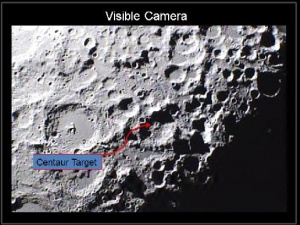 |
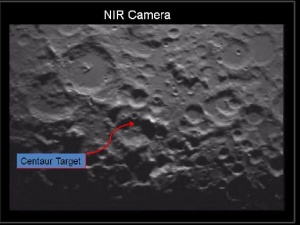 |

|
The LA Times was quick to reassure readers that “scientists might still pluck success from the mission’s anticlimactic ending … At a news conference more than two hours after the crash, mission scientists confirmed that the Centaur rocket made a crater when it hit, and that crater was about the expected size of more than 60 feet across.” There is no way to confirm that claim, of course, since the ship allegedly impacted inside a two-mile deep, pitch-black crater that hasn’t seen daylight for millions of years – which is exactly why it was targeted.
And how pointless, by the way, was this mission? The goal was supposedly to discover if there are large deposits of frozen water on the Moon that could be mined to provide water, breathable oxygen and rocket fuel for future lunar exploration and colonization. The water, if it exists, is at the bottom of deep, permanently dark craters where the temperature is said to hover at around -400° F. At those temperatures, the scientific community tells us, the water would be frozen as hard as rock.
Even if we assume that NASA could overcome all the problems with getting astronauts to the Moon and guaranteeing their survival while there, how exactly would they recover that water? Toss bombs in the craters and then try to run around and gather all the chunks of ice before they melt in the +280° F heat of the sun? Drive down into the craters in one of those folding dune buggies with floodlights, a couple of battery-powered jackhammers, some warm clothes and a shitload of batteries? Or are we going to build a giant, mechanized water-extraction facility of some kind with parts brought up one-at-a-time from Earth? How long do you suppose that will take?
It’s anyone’s guess what the real purpose of this mission was, but whatever goals were being pursued, it doesn’t seem to have gone so well. All that can be said for sure is that NASA appears to be but a shadow of its former self. Once upon a time, we were able to blast men off into space and then turn on our televisions and watch them, just four days later, stroll around on the Moon! Nowadays we send off an empty spaceship, wait patiently for nearly four months, and then watch as NASA fails to successfully crash that empty ship into the Moon.
Since the news media fell asleep at the wheel and failed to bring you the spectacular images that had been promised, I dropped by NASA’s website to pick up a few and bring them to you. The following three photos were labeled as “LCROSS Impact Images.” Following that is a link to NASA’s thrilling live video footage. Enjoy the show. It’s quite dazzling.
NASA video of the LCROSS impact
Did anyone notice, by the way, all the other ‘lunar modules’ that are recognizable in the larger image captured by NASA's LRO? As will be recalled, they are recognizable by the long shadows they cast. There are, most notably, probably nearly a dozen of them clustered around the crater to the right of the image. I wonder how the boys at NASA figured out which one was the ‘real’ lunar module?
Part VII
21 November 2009
“The LEM (Lunar Excursion Module) was coated in Mylar. To many engineers, the final vehicle was an insult to every notion of what a spacecraft should look like … It was one of the weirdest and most improbable flying machines ever conceived.”
Moon Machines: The Lunar Module, Science Channel, 2008
Moon Landing Documentaries
While idly flipping through the channels the other day, I noticed that the Science Channel was planning to air a couple of Moon landing documentaries. Luckily, I was a bit bored that day so I decided to tune in, though I was not really expecting much beyond the standard claims that have been made in numerous other documentary films focusing on the alleged Apollo missions.
I was pleasantly surprised, however, to find that the two hours that I spent watching the Science Channel spin the Moon landings was time well spent, seeing as how I picked up quite a few facts that I had not previously come across in other source material. The most important thing that I learned was a lesson, of sorts: never attempt to mock the Apollo missions – for the simple reason that all such efforts will be in vain, since no claim made in jest, no matter how absurd, can ever top the lunacy of actual claims made by NASA and its subsidiaries.
The better of the two televised documentaries was Moon Machines: The Lunar Module, which turned out to be part of a series which, as luck would have it, is readily available on Netflix (with all six hours conveniently packaged on a single DVD). Netflix seemed to think that I might also enjoy Nova’s two-hour To the Moon and the Discovery Channel’s multi-part When We Left Earth, so I added those to my queue as well. Having now absorbed everything that Moon Machines, To the Moon, When We Left Earth and First on the Moon: The Untold Story have to offer, I realize that my debunking of the alleged Moon landings wasn’t really as thorough as it could have been, so another chapter is on order. Or maybe two. Or possibly three. Perhaps even four.
Moon Machines: The Lunar Module began by having a talking-head named Josh Stoff explain to viewers that when JFK delivered his historic speech on May 25 of 1961 – the one in which he boldly proclaimed that Americans would walk on the Moon by the close of the decade – “The United States had a total of fifteen minutes of space flight experience … and now we were committed to go to the Moon … We knew nothing about the Moon.”
Indeed, if Kennedy had delivered that speech just three weeks earlier, Stoff’s statement would have to be modified to: “The United States had no space flight experience at all, and now we were committed to going to the Moon!” On May 5, 1961, Alan Shepard had become the first American in space when he took a 15-minute ride in a Mercury capsule that basically went up and then came right back down. That mission was a hastily assembled “Hey, look! We can do it too!” response to the USSR having put the first man in space on April 12, 1961.
Soviets were streets ahead
Shepard’s accomplishment didn’t even come close to what the Soviets had achieved. Yuri Gagarin had ridden the Vostok 1 into low-Earth orbit, completing a single orbit in 1 hour and 48 minutes. In comparison, Shepard had essentially taken a short ride aboard an oversized bottle-rocket. It would take another four months, until September 13, 1961, for the United States to get its first unmanned spacecraft to complete an Earth orbit. It would not be until near the end of February 1962, nearly a year after Gagarin’s flight, that NASA would claim to have gotten an American (John Glenn) into orbit.
On the day of Gagarin’s historic flight, a clearly uncomfortable President Kennedy fielded questions from a concerned press corps. Asked if we intended to beat the Russians to the Moon, Kennedy testily replied that:
“we first have to make a judgment, based on the best information we can get, whether we can be ahead of the Russians to the Moon.”
Asked a follow-up question about the Saturn rockets already under development by the von Braun team, an obviously annoyed Kennedy replied that
“Saturn is still going to put us well behind.”
Konrad Dannenberg, a rocket propulsion engineer who worked alongside von Braun for some 33 years, first in Nazi Germany and then in Huntsville, Alabama, readily agreed that “They [the Soviets] were really in all areas way ahead of us.” So despite the frequent claims of ‘debunkers’ that it was actually a close race, or that the Soviets weren’t really leading at all, everyone from the President to the scientists who actually designed and built the machines that allegedly took us to the Moon agreed at the time that the Soviets were far ahead of the U.S. in virtually all aspects of the space race.
The ‘debunkers’ are right about one thing though: the list of Soviet firsts that I included in an earlier post in this series is not entirely accurate. Truth be told, I appear to have sold the Soviets short by leaving out a number of the early accomplishments of their space program, including a couple of firsts that the United States was unable to match for decades. Here then is a more complete list of Russian firsts in the years leading up to and during the alleged Apollo missions:
- May 15, 1957 – The Soviet Union tests the R-7 Semyorka, the world’s first intercontinental ballistic missile.
- October 4, 1957 – The Soviets launch Sputnik 1, Earth’s first manmade satellite.
- November 3, 1957 – A dog named Laika becomes the first animal to enter Earth orbit aboard Sputnik 2. Unfortunately for Laika though, she isn’t booked for a return flight.
- January 2, 1959 – Luna 1 becomes the first manmade object to leave Earth’s orbit.
- September 13, 1959 – After an intentional crash landing, Luna 2 becomes the first manmade object on the Moon.
- October 6, 1959 – Luna 3 provides mankind with its first look at the far side of the Moon.
- August 20, 1960 – Belka and Strelka, aboard Sputnik 5, are the first animals to safely return from Earth orbit.
- October 14, 1960 – Marsnik 1, the first probe sent from Earth to Mars, blasts off.
- February 12, 1961 – Venera 1, the first probe sent from Earth to Venus, blasts off.
- April 12, 1961 – Yuri Gagarin, riding aboard the Vostok 1, becomes the first man in Earth orbit.
- May 19, 1961 – Venera 1 performs the first ever fly-by of another planet (Venus).
- August 6, 1961 – Gherman Titov, aboard the Vostok 2, becomes the first man to spend over a day in space and the first to sleep in Earth orbit.
- August 11 & 12, 1962 – Vostok 3 and Vostok 4 are launched, the first simultaneous manned space flights (though they do not rendezvous).
- October 12, 1964 – Voskhod 1, carrying the world’s first multi-man crew, is launched.
- March 18, 1965 – Aleksei Leonov, riding aboard the Voskhod 2, performs the first space-walk.
- February 3, 1966 – Luna 9 becomes the first probe to make a controlled, ‘soft’ landing on the Moon.
- March 1, 1966 – Venera 3, launched November 16, 1965, becomes the first probe to impact another planet (Venus).
- April 3, 1966 – Luna 10 becomes the first manmade lunar satellite.
- October 30, 1967 – Cosmos 186 and Cosmos 188 become the first unmanned spacecraft to rendezvous and dock in Earth orbit. The United States will not duplicate this maneuver for nearly four decades.
- January 16, 1969 – Soyuz 4 and Soyuz 5 become the first manned spacecraft to dock in Earth orbit and the first to exchange crews.
- November 17, 1970 – Lunokhod 1, the first robotic rover to land on and explore an extraterrestrial body, lands on the Moon. Twenty-seven years later, the United States lands it’s very first robotic rover on Mars.
- December 15, 1970 – Venera 7 becomes the first probe to make a soft landing on another planet (Venus).
- April 19, 1971 – Salyut 1 becomes the world’s first orbiting space station.
- August 22, 1972 – Mars 2 becomes the first probe to reach the surface of Mars.
I feel much better now that we have set the record straight on all of that. And I’m sure that the ‘debunkers,’ who in the past have described much shorter lists of Soviet firsts as ‘padded,’ will feel much better as well.
The Soviets achieved the first fly-by of the Moon, launched the first craft to impact the Moon, were the first to make a soft landing on the Moon, put the first object into lunar orbit, and remain, to this day, the only nation to land and operate a robotic vehicle on the Moon. It should now make perfect sense to everyone then why the Soviets, who were ahead of us in virtually all aspects of space exploration, in some cases by decades, never landed a man on the Moon. Or even sent a man to orbit the Moon. Come to think of it, they never even sent a dog to the Moon.
It would be difficult to argue that the Russians didn’t have adequate funding for their space program, or that they didn’t have some of the finest scientific minds on the planet working for that space program, or that they didn’t have the will and desire to succeed. What they were lacking, I’m thinking, is access to Hollywood production facilities. Returning then to our prior topic of discussion …
On April 14, 1961, two days after Gagarin’s historic flight, a panicked Kennedy reportedly inquired of NASA what goal in space we might be able to attain before the Soviets. According to legend, Kennedy was told that America’s best hope to beat the Russians was with a manned Moon landing. The reasoning was that the Soviets were so far ahead of us that they would surely trounce us in achieving any milestones attainable in Earth orbit (space-walks, prolonged flight, rendezvous and docking maneuvers, etc.), so our best bet was to shoot for a far-off goal.
The problem, however, was that none of the technology required to attain such a goal existed at that time. We did not have the rocket technology to power such a mission, nor the navigation system to guide such a journey, nor the digital computer technology to control that navigation system, nor the spacesuit technology to protect our astronauts, nor the technology to rendezvous or dock in space, nor the technology to create a dune buggy capable of operating on the Moon, nor the technology to design and create a lunar landing vehicle. NASA had been in existence for less than three years, having been created in 1958 as a direct response to the USSR’s launch of Sputnik.
Nevertheless, just eight summers later, we allegedly did indeed land men on the Moon. In just eight short years, starting essentially from scratch, we designed, built, tested, refined and perfected every piece of technology required to put men on the Moon, and we did it so well in that brief period of time that by July of 1969, every cog in the wheel performed nearly flawlessly. And yet now, with a half-century of space exploration now under our belts, and with all the necessary technology long perfected, NASA advises us that it would take twice as long to put a man on the Moon. But I may have already pointed that out.
Following Kennedy’s bold declaration, nobody really had any clue how to get astronauts to the Moon and back. One school of thought held that what was needed was a humongous rocket ship that would fly all the way there, land, and then fly all the way back. The main drawback to this proposal was that it was completely preposterous. The biggest problem was that it would require somehow landing a 300-foot tall cylinder in a perfectly upright position. But that wasn’t the only problem. Getting in and out of a capsule mounted atop a tall rocket ship can be a bit of a problem as well. And re-launching that rocket without a launch pad and ground crew can be a real bitch.
Another idea called for the launch of two large rocket ships, one primarily carrying fuel and the other carrying our fearless astronauts. The idea was that the two vehicles would rendezvous and dock in Earth orbit, the manned ship would refuel from the other ship, and our boys would then leave for the Moon. Why this was deemed necessary is anyone’s guess, given that the ‘debunkers’ generally claim that you don’t really need much fuel once you leave Earth orbit since you just kind of fall through the vacuum of space until you get to the Moon.
Amidst all the preposterous ideas on how to get our guys to the Moon ahead of the Russkies, one lone voice in the wilderness, an “obscure engineer” by the name of John Houbolt, had been promoting a radically different plan: build a second lightweight spacecraft, to be carried aboard the larger mother ship, that would be capable of shuttling down to the Moon and back while the larger ship remained in lunar orbit!
As Moon Machine’s narrator solemnly intoned, “There was only one massive drawback: to get back to Earth would require the lunar shuttle to rendezvous with the mother ship in lunar orbit.” As Stoff added, “What scared everybody about it was you had to rendezvous and dock around the Moon. You’re a quarter of a million miles from Earth! And he’s proposing this in 1961, when we had no space flight experience and just rendezvousing in Earth orbit concerned everybody.”
Needless to say, everyone scoffed at Houbolt’s radical suggestion. The very vocal opposition at NASA was led by Mr. von Braun, who categorically and heatedly dismissed the notion of completing a lunar orbit rendezvous (the idea, by the way, appears to have been cribbed from an early Soviet study). But Houbolt was allegedly a tenacious sort who wasn’t about to give up easily, even going so far as to write directly to Bob Seamans at the top of the NASA food chain on November 15, 1961. Houbolt was, of course, immediately taken seriously by the NASA brass, who promptly decreed that his ideas should get a serious hearing.
A major turning point was supposedly reached when a meeting was convened in June of 1962. During that historic meeting, we are informed by the narrator of Moon Machines, “von Braun took everybody by surprise.” Wernher’s own team gave a detailed presentation to the assembled scientists, after which von Braun thanked and profusely complimented them – before telling them that he was going to recommend that NASA not go with his own team’s concept. Instead, he was going to recommend the so-called LRO, or lunar orbit rendezvous, option!
As yet another authoritative talking-head named Bill Causey explained, “It was such a surprise to everybody that even his own staff people, several days later, had a private meeting with him and they said, ‘Why in the world did you say that?’” Why indeed? My guess is that someone finally passed Wernher the memo explaining that he needed to get over the silly notion that the plan was to actually go to the Moon. What was needed, instead, was a plan that could be feasibly sold to the American people.
Curiously, Mr. Houbolt, who we are led to believe was single-handedly responsible for selling NASA on the lunar module concept, and without whom we would have probably never allegedly sent men to the Moon at all, has been all but forgotten. That seems a rather strange way for history to treat the man whose brilliant mind allegedly opened the door for man to walk on the Moon.
The man whose name is most commonly referenced when discussing the lunar module, by the way, is a gent by the name of Thomas Kelly, who served as the project manager for the design, construction and testing of the LEM. Kelly happened to be a member of the Quill and Dagger Society, Cornell University’s answer to Yale University’s notorious Skull and Bones. I just thought maybe I should mention that.
In July of 1962, NASA announced that it was fully committed to the lunar shuttle concept and began shopping around for a contractor to build it. As fate would have it, a small aircraft company on Long Island, the Grumman Corporation, had already been working on the design of an independent lunar shuttle vehicle, cleverly anticipating the market demand. Grumman thus was able to submit a much more detailed proposal than other competitors, sealing the deal with NASA.
In November of 1962, Grumman was awarded the contract to build what Moon Machines described as “the most complicated and sophisticated spacecraft ever conceived.” Soon after, we are also informed that the LEM was “what many regarded as the first true spaceship.” In other words, America’s “first true spaceship” was also America’s “most complicated and sophisticated spacecraft.” To this day, no other spacecraft has been built that is capable of landing men on a planetary body. To this day, no other spacecraft has been built that is capable of taking off from and flying home from a planetary body. To this day, no other spacecraft has been built that is capable of performing rendezvous and docking maneuvers in lunar orbit. To this day, no spacecraft has been built that can protect astronauts from the hazards of flying through space outside of the Van Allen belts.
When you think about it, of course, it makes perfect sense that America’s first true spacecraft, coming as it did during the infancy of the Space Age, would also stand to this day as "the most complicated and sophisticated spacecraft ever conceived." After all, didn’t Henry Ford build the most complicated and sophisticated automobile ever conceived? And didn’t Orville and Wilbur build the most complicated and sophisticated aircraft ever conceived? And didn’t Alexander Graham Bell invent the IPhone?
From the outset, Grumman envisioned a two-stage vehicle, with as much of the weight as possible carried in the lower half, or descent stage, of the spacecraft. Eliminating excess weight was of paramount importance. Early designs included no ladder, for example, as a ladder was considered unnecessary weight. In 1/6 gravity, it was assumed, the astronauts would be able to climb in and out of the capsule using just a rope. Of course, the modules never came anywhere close to being in a reduced gravity environment, which is probably why a ladder was added to the landing vehicle.
According to the Science Channel, the only constant in Grumman’s drive to design the modules was change. So much so that, “Finally, in the spring of 1965, NASA, worried design changes would never stop, imposed a freeze.” NASA had apparently decided that two-and-a-half years, working with the knowledge and technology of the early 1960s, was plenty of time to design the “most complicated and sophisticated spacecraft ever conceived.” Whatever the Grumman team had come up with to that point would have to be good enough to get our flyboys from the mother ship to the Moon and back.
It was now time to go to work actually building what was described as “an entirely independent spacecraft, with its own motors, fuel, life support system and navigation equipment. To some at the time, it seemed excessive.” To many others at the time, it just seemed ridiculous.
I happened to stumble across, by the way, an image depicting a 1963-era LEM prototype parked on the surface of the Moon. As has been the case throughout this series, the image comes directly from NASA’s web pages, where it was proudly presented as the “Image of the Day.” It shouldn’t be too hard to figure out what it is that I love about this image – even if it does prove me to be a liar, given that I previously claimed that none of NASA’s Moon photos depict any stars in the lunar sky.
Clean room conditions required
According to the folks at the Science Channel, the lunar module “was built in one of the world’s first clean-rooms. In zero gravity, any floating foreign body would be a hazard.” A hazard, that is, to both the astronauts’ health and to the ship’s delicate on-board electronics. Workers were required to wear gowns, masks, hairnets and booties, technicians meticulously cleaned the interior with camel hair brushes and filter paper, and the modules were robotically lifted, inverted and shaken to rid the cabin of any debris.
Although the narrator forgot to mention it, I’m pretty sure that the astronauts were also instructed not to shed any hair or skin during the missions. On a more serious note, NASA did, in fact, reportedly consider requiring the astronauts to shave from head to toe. That never happened, of course, probably due to the fact that hairless and eyebrow-less astronauts wouldn’t have been as warmly embraced by the American public, and the Apollo missions were more about appearances than they were about science.
Left unexplored by the makers of Moon Machines was the obvious question of how those clean-room conditions could have been maintained once the lander set down on the Moon. The astronauts couldn’t shed their protective suits until they were back in the safety of the pressurized capsule, so how exactly did they keep from tracking copious amounts of that lunar dust back into the allegedly sterile LEM cabin? As is revealed in the Lunar Rover episode of the Moon Machines series, “The astronauts quickly learned that the dust adhered to everything it touched.”
Everything, that is, except the outside of the lunar module, which, as we have already seen, remained as clean as if it were sitting on the showroom floor. And the dust apparently also didn’t adhere to the astronauts’ boots or spacesuits, even if Apollo astronaut Charlie Duke did say, while describing what it was like to ride in the lunar rover, that “Moon dust was pouring down on us like rain, and so after a half of a Moon walk, our white suits turned gray.” None of that dust, of course, was introduced into the sterile interior of the cabin.
We know that with absolute certainty because we have already been told that in order for the lunar module to operate safely and correctly, the cabin had to be kept dust-free. One of the best-kept secrets of the Apollo program, it turns out, is that there was actually a third passenger along for the rides to the Moon and back: Neil Armstrong’s mother. Her primary responsibility was to make sure the boys properly wiped their feet before entering the capsule.
Astute readers, by the way, may have noticed that Duke’s comments about driving the rover directly contradict another of the fables sold by the ‘debunkers.’ According to Phil Plait, if you watch the video footage allegedly shot on the Moon, “you will see dust thrown up by the wheels of the rover. The dust goes up in a perfect parabolic arc and falls back down to the surface. Again, the Moon isn’t the Earth! If this were filmed on the Earth, which has air, the dust would have billowed up around the wheel and floated over the surface. This clearly does not happen in the video clips; the dust goes up and right back down. It’s actually a beautiful demonstration of ballistic flight in a vacuum.”
As would be expected, we find Jay Windley making essentially the same claim:
“dust will fall immediately to the lunar surface. The behavior of the dust in the video and film taken on the lunar surface is one of the most compelling reasons we have for believing it was shot in a vacuum. The dust is clearly dry, but it falls immediately to the surface and does not form clouds.”
Who then are we to believe? The guy who actually operated the rover, allegedly on the surface of the Moon, and said that the dust was raining down on he and his partner from all directions, or a couple of self-proclaimed ‘experts’ who directly contradict NASA’s man-on-the-scene?
There is a reason, I might add here, why NASA defers to these two clowns while not officially endorsing their ‘debunking’ arguments. It’s called plausible deniability. NASA knows that ‘debunking’ the fact that the Moon landings were hoaxed requires a lot of twisting of facts and the promotion of a lot of dubious science, and they choose not to be directly involved in such endeavors. That is also, no doubt, why the agency withdrew its sponsorship of a ‘debunking’ book that is said to be in the works.
Part VIII
22 November 2009
“Whenever I saw a model of the lunar module, it had these rigid sides and [it] really looked strong. Turns out that external portions of the lunar module are made up of Mylar and cellophane and it’s put together with Scotch tape and staples. We had to have pads on the floor ‘cause if you dropped a screwdriver, it would go right through the floor.” Jim Lovell, Astronaut (Gemini 7, Gemini 12, Apollo 8, Apollo 13)
More on need for dust-free Lunar module interior
A quick note before moving on: a little research has revealed that NASA now acknowledges that maintaining clean-room conditions on space exploration vehicles while performing EVAs on planetary bodies poses a bit of a problem. The agency’s solution is something known as a ‘suitport.’ The basic idea is to design a rear-entry spacesuit that will remain attached to the exterior of the vehicle when not in use. The astronaut will enter through the rear of the suit and then detach himself from the vehicle. Reentry will require reversing the procedure.
NASA has even generously provided an image of a proposed lunar rover with two integrated suitports, as seen above. The agency feels that such technology will be required for any ‘return’ trips to the Moon or for landing on and exploring other planets. As with the space radiation shield that will also be required for any ‘return’ trips to the Moon, NASA offers no explanation for why such technology was not required back in 1969.
Moving on then to the lunar module’s propulsion system, we are informed that “the LEM was equipped with two very different rockets. The first, the so-called descent engine, would take the LEM from the command module down toward the lunar surface. It was an entirely new and untried piece of technology.” Adds talking-head Stoff, “Up until this point in history, no one had ever built a rocket engine with a throttle. Either they were on or they were off.”
Since the LEMs never had to actually perform as advertised, it’s doubtful that they actually had a throttle. It’s doubtful that they even had engines. We’re going to play along though and pretend as though they did.
Lynn Radcliffe, who managed the facility at White Sands that was specially constructed to test and develop the LEM’s rocket engines, describes the technology required to land the lunar modules:
“This was an unbelievable maneuver when you stop and think about it. You’re sitting on a column of thrust, just hovering there, like a, a helicopter, and then as you let it go, the throttle, a little bit, you lower it just a few feet per second until you make contact. All of this is an amazing set of requirements to put on anyone trying to design a rocket.”
Radcliffe is absolutely right; I did stop to think about it and it is unbelievable. What’s interesting here though is that when I described the technique that would have been used to land the modules as being very similar to the landing of a helicopter, some of the ‘debunkers’ got their panties all in a wad over it. And yet here we have the guy who oversaw the development of the rocket engines describing the alleged landings in exactly the same manner, so I guess we can safely conclude that he really doesn’t know what he is talking about either.
And Gene Cowart, who served as Boeing’s chief engineer on the lunar rover project from 1969 through 1971, didn’t know what he was talking about either when he noted that the “LEM, when it comes down over the Moon, does not immediately just set down. It hovers over the Moon.” And Charlie Duke, the alleged pilot of the Apollo 16 lunar module, was no doubt mistaken as well when he recently told James May (James May on the Moon) that flying the lander “was like flying a helicopter.”
Amusingly enough, while the landing of the lunar module was being described on Moon Machines, vintage animation from the gang at NASA/Grumman was displayed on the screen. Below are a couple of screen-caps of that animation. As with the verbal descriptions, of course, I’m sure that this is just another case of the folks who actually designed and/or operated the technology being clueless about how it was supposed to work. As many readers are surely aware, the only people who really know how all that technology was supposed to work are modern-day heroes like Phil Pliet and Jay Windbag.
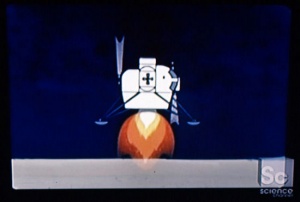 |
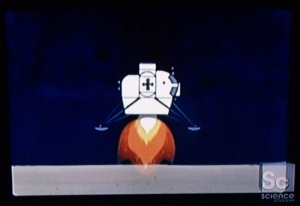
|
As it turns out, designing that throttle-equipped descent engine was child’s play compared with the task of perfecting the spacecraft’s second rocket engine. As our narrator solemnly intoned, “it was the module’s second rocket, the so-called ascent engine, that caused Grumman the most lost sleep. It didn’t need a throttle, but it did need to work with absolute reliability.”
As Lynn Radcliffe noted, “You’re totally dependent on the ascent engine to work to put you back in orbit. If for any reason the ascent engine failed to work, the astronauts are doomed.” Dick Dunne, Grumman’s Director of Public Relations during the time of the alleged Apollo missions, described the astronauts’ predicament in stark terms: “Two astronauts were going to climb into this thing and essentially they were going to press a button, and if it worked, it worked, and if it didn’t, there weren’t many things that they could do about it.”
To keep the operation of the engine as simple as possible, so-called hypergolic propellants were used – which is to say, a fuel and an oxidizer that explode on contact. That simplicity though came at a price: “the fuels were extremely toxic.” What most concerned Grumman’s engineers was “that the fuel was so corrosive that at the end of a test, each engine had to be rebuilt. It meant the final assembly of an engine could never be tested!”
“Unbelievably,” explains Radcliffe, “the first time these engines would ever have been fired, ever – no check-out at the factory – the first time would be when they were fired on their mission.” As Dunne noted, “I don’t think that anyone could, at that time, tell you 100% that it was gonna work.”
Seeing as how the engines were completely untested – both in terms of being able to operate within the environment of the Moon and in terms of the individual engines being factory tested to see if they worked at all – Dunne’s evaluation would seem to be a bit of an understatement. Luckily though, none of the landers actually made it to the Moon, so whether the engines worked or not is a bit of a moot point.
Another problem the Grumman team faced was how to adequately insulate the vehicle from the intense heat of the unshielded sun (there was, curiously enough, no mention throughout the hour about the necessity of shielding the craft from space radiation). As Stoff noted, “You have to insulate the spacecraft as well as possible because there’s huge fuel tanks in there and the fuel’s gonna boil [if not adequately protected].” Also, we are informed, the huge temperature variations on the Moon “could also cause the craft to buckle.” Unmentioned was that it could be a wee bit uncomfortable for the astronauts as well.
Since weight was an issue, heavy heat shields could not be used. Luckily though, “Dupont had developed this new material – it was aluminized Mylar. It was a gold color, and they found if you built it up to perhaps twenty-five layers, it’s an excellent insulator.” Dupont’s space-age material, as we all know, can be obtained pretty inexpensively these days. And it’s still a very lightweight material. I wonder why it is then that you rarely see spaceships wrapped in it anymore?
Meanwhile, down in Texas, astronauts had been training on a simulator that was supposed to teach them to land the lunar module. Unfortunately, the simulator was “unstable and dangerous” and never worked properly. No one ever actually landed the contraption – but on the plus side, there is lots of film stock of fiery simulator crashes. Stoff notes that, ..“At some point in the program, [NASA] eventually stopped using it because it was just, it was a lot safer to land on the Moon than it was to fly this machine down in Texas.”..
Of course it was. Why waste time with a simulator when the real thing was going to be so much easier? And NASA, no doubt, knew that that would be the case before we even faked going to the Moon. I’m pretty sure that Armstrong was pulled aside and told: “Don’t worry about almost being killed in that simulator. The real thing is going to be so much easier. You’ll see when you get up there. Just trust us on this one. And we’re fairly certain that there is at least a slim possibility that the ascent engine will work when it’s time for you and Buzz to come home. Unless, you know, you guys happen to get a dud. There’s really no way for anyone to know for sure until you get there and try to fire it up. Have a safe trip.”
In the summer of 1967, the first space-ready LEM was delivered to Cape Kennedy to be loaded aboard the Apollo 4 launch vehicle. Incredibly, it had taken less than five years to get “the most complicated and sophisticated spacecraft ever conceived” from the chalkboard to the launch pad! And in the mid-1960s no less! (By the way, I happened to stumble across this image of Apollo 4 sitting on the launch pad. It is, I have to say, a mighty impressive shot. Kudos to the non-astronaut photographer who snapped it.)
The lunar module never made it aboard that impressive looking rocket ship. Upon delivery, the module was found to have “hundreds of problems,” including bad wiring, faulty parts, an abundance of poor workmanship, and, most alarmingly, serious leaks throughout the fuel system. Grumman had neglected, it seemed, to perform any pre-flight checks. Worse yet, as Grumman’s team raced to correct the numerous problems, a pressure test caused a window to blow out, blasting jagged holes in the skin of the craft and sending debris flying throughout the formerly dust-free module.
The cause of the blowout was never determined. NASA and Grumman though decided to take the “Fuck it! What’s the worst that could happen?” approach and merely replaced the window and ignored the failed pressure test, making no design changes to the modules. After all, there was a timetable to adhere to.
In the end, as we all know, the lunar modules performed flawlessly. According to legend, Neil Armstrong, ever the cool one, set the first LEM down with barely fifteen seconds of fuel remaining in the tank. And when he and Buzz fired up that ascent engine for the very first time, it popped them off the surface of the Moon as if they were riding on a champaign cork. As it turned out though, the lunar module had not yet faced its toughest challenge.
In the spring of 1970, fittingly enough on April 13, Apollo 13’s command and service modules were allegedly rendered powerless by an explosion on the ship while cruising through space some 200,000 miles from home (though in official NASA footage, the windows of the module are filled with blue light, not the blackness of space). The oxygen tank explosion was allegedly powerful enough to do serious damage to the exterior of the craft, but apparently not powerful enough to alter the course of the ship. That was a lucky break for the guys.
The three-man crew allegedly retreated to the two-man LEM, which, as we know, had its own oxygen and fuel supplies. Not only did the LEM allegedly keep the brave trio alive, but its descent engine was allegedly used to ‘slingshot’ the crippled spacecraft around the Moon and set in on a course back to Earth!
Their ordeal wasn’t over though. While camped out in the LEM, the Apollo 13 astronauts were allegedly faced with another life-threatening situation: carbon dioxide was rapidly building in the ship’s confined airspace. Lithium hydroxide cartridges were supposed to remove the carbon dioxide, but there was a limited supply of said cartridges in the LEM. Luckily though, there were additional cartridges in the command module. But they were incompatible; the command module’s cartridges were square while those in the LEM were round.
What to do then? According to Moon Machines, the brain-trust down at mission control had a brilliant idea: “NASA suggested using duct tape and tubing from the spacesuits to jury-rig a connection … (dramatic pause) … It worked!”
I, needless to say, was just being a smart-ass when I said that all we needed back in the 1960s was a roll of duct tape and we could MacGyver those spaceships to the Moon and back. NASA, on the other hand, is dead serious when it says that it was indeed a roll of duct tape that got the Apollo 13 crew home safe and sound – with, needless to say, a huge assist from that spunky little lunar module, which not only powered the flight home but also kept three astronauts alive for nearly 100 hours when it was only designed to keep two men alive for 50 hours!
There seems to be some controversy, however, on exactly how the cartridges were MacGyvered. According to Lovell, who was on the Apollo 13 flight, “we did it with duct tape, with a piece of plastic, and a piece of cardboard, and an old sock.” The key ingredient here seems to be the duct tape. It would probably be fair to say that with a roll of duct tape and any other two random items, you could fix most problems that might arise on a spaceship.
Moving on then to the other Science Channel offering, a 2005 effort entitled First on the Moon: The Untold Story, we learn that Mission Control at the Johnson Space Center in Houston, Texas “was not as high-tech as it looked.” On television, it looked pretty damned impressive, for the era at least. As anyone alive at the time recalls, what the world saw was an enormous room filled with computer consoles, each staffed by a key member of the Apollo team diligently monitoring his computer screen for any signs of trouble.
But in reality, as Apollo 11 computer engineer Jack Garman clues us in, “the computer screens that we looked at in Mission Control weren’t computer screens at all. They were televisions. All the letters, or characters, [they] were all hand drawn. I don’t necessarily mean with a brush, but I mean they were painted on a slide.” But they sure looked pretty damned impressive.
Jack Garman, by the way, was not just some random, low-level computer hack recruited by the Science Channel to offer commentary. According to the official legend, Garman was the guy on the Apollo 11 crew who cleared the Eagle to land despite the fact that multiple alarms were going off. That would tend to indicate that he was a pretty important player at Mission Control.
Every one of those consoles on the floor of Mission Control was powered by a single mainframe computer – a single mainframe computer that had the computing power of a single laptop computer. Actually, make that a 2005-era laptop computer. And the spaceship itself, that multi-staged engineering marvel, carried a computer roughly equivalent to what powers a modern digital watch. Total memory capacity was about 72 kilobytes, or just about enough to hold one of the smaller images on this page.
As I was typing these very words, I realized that I was doing so on a genuine, vintage 2005 laptop computer. If I were inclined to wear digital watches, which I am not, I would now be holding in my hands all the computing power needed to get me and a couple friends to the Moon and back. If we utilized the power of my desktop computer as well, and went down to the Party Store to get a few rolls of Mylar, we could probably make it all the way to Mars and back. How cool is that?
Another curious fact that First on the Moon made note of was that, according to Harold Loden, Apollo 11 mission controller, “The skin on the crew cabin [of the lunar module] was very thin, and that was all done because of weight savings.” Another talking-head added that, “If you really took your finger and poked hard at it, you could poke right through the outer skin of the spacecraft. It was about the thickness of two layers of aluminum foil.” Project Manager Thomas Kelly concurred, noting that “the skin, the aluminum alloy skin of the crew compartment was about 12/1000s of an inch thick. That’s equivalent to about three layers of Reynold’s Wrap that you would use in the kitchen.”
It’s difficult to see then why that window would have blown out during the LEM pressure test. You would think that the guys at Grumman would have securely duct-taped it to the, uhmm, fuselage. And I’m also sure that, had the window not blown out and released the pressure, the rest of the ship would have passed the pressure test with flying colors.
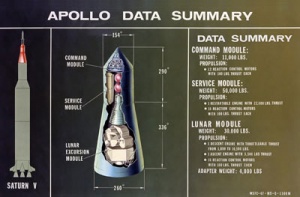 |
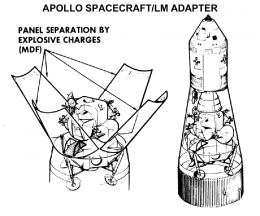
|
It would appear that what was deployed by the mother ship to shuttle our guys down to the Moon was essentially an oversized Jiffy-Pop container (with the brainpower of a digital watch). The show’s narrator was quick to point out that the astronauts had to be very careful while moving about in their bulky suits lest they puncture or otherwise damage the delicate skin of the craft. What wasn’t pointed out was that the vacuum of space had to be very careful as well – careful not to rip the pressurized craft to shreds the instant it was deployed!
One would logically assume, by the way, that the LEMs would have been kept safely tucked away within the mother ship until lunar orbit was achieved. But according to NASA, that’s not the case. The official legend holds that the lunar modules were deployed shortly after leaving Earth orbit, about three hours after blasting off, and that they then docked in a nose-to-nose configuration with the command and service modules while both spacecraft were flying through the vacuum of space at either 17,000 or 25,000 miles per hour, depending on the source.
In other words, for virtually the entire 234,000-mile journey from the Earth to the Moon, that flimsily constructed lunar module essentially served as the front bumper of the mother ship. Other than to allow for the creation of the “little engine that could” fable surrounding Apollo 13, which holds that the conjoined spaceships flipped over and the front bumper became the engine, it makes little sense why that would have been done. Not only would it have exposed the fragile lunar modules to the hazards of a lengthy space flight, it would also have required a docking maneuver in outer space (one that seems to go unmentioned in the majority of the Apollo literature).
Amazingly enough, not only were the lunar modules capable of making soft manned landings on the Moon, and of blasting off from the surface of the Moon, and of rendezvousing and docking with the mother ship while in lunar orbit, but they were also capable of docking with the mother ship while cruising from the Earth to the Moon! By my count, those spunky little modules had to dock no fewer than seventeen times during the various Apollo missions, and they performed perfectly every time (twice in Earth orbit on the Apollo 9 mission, and twice on each of the Apollo 10-17 missions, except for Apollo 13, which did not complete the second docking maneuver).
Let’s pause here for a brief moment to reflect on the alleged plight of the unlucky Apollo 13 crew. There were no seats in the LEM as it had been decided that they would just add unnecessary weight. And there is just barely room for two guys in the space allegedly being occupied by three. All three, had this have been a real life-and-death situation, would have been wearing bulky spacesuits, boots, gloves and helmets. Somehow, they had to coexist for four days. During that time, all that would have separated them from the extreme hazards of outer space was a double layer of aluminum foil. One micrometeorite or one misplaced elbow would result in immediate death for the trio.
As the narrator informs us during When We Left Earth, “If the flight suit fails or even tears a little, the difference in pressure will cause the astronaut’s blood to boil, killing him instantly.” The same would be true, of course, about the skin of the spacecraft: the smallest tear would mean instant death for all three. Of course, their suits would have allegedly provide a second line of defense, except that, as can be seen in one of the handful of Apollo 13 mission photos released by NASA, the astronauts weren’t bothering to wear their suits as they cheerfully went about the business of MacGyvering their spaceship.
As we already know, their cockiness was entirely justified since that aluminum foil capsule provided all the protection the astronauts needed to get home safely. No fewer than eight lunar modules allegedly made the hazardous voyage to the Moon, and all of them arrived in immaculate condition. The Apollo 13 lunar module was exposed throughout virtually the entire mission – all the way to the Moon and all the way back. In all, the eight LEMS allegedly logged some 2,000,000 miles of unprotected space flight and not one of them suffered so much as a scratch. That, my friends, is 1960s technology at its finest.
Part IX
29 November 2009
“During the flight of Gemini 7, the crew will remove their lightweight spacesuits and fly in their underwear.”
James V. Correale, Jr., the head of the Gemini Support Office“There’s no question in our minds; the only way to fire these things is without pressure suits … I’m convinced we could run the whole works without suits. All we need is a suit for reentry and emergency stored on board somewhere.”
Astronaut Frank Borman, in voice transmissions from the Gemini 7 capsule
Mythbusters - More on shadows
Before moving on to some of the other amazing technology allegedly developed for the Apollo missions, I must digress here to discuss a screamingly funny episode of a ridiculous little show known as Mythbusters that my DVR obligingly recorded for me the other day (it knows that I like that kind of thing). In this particular episode, the hosts took a look at the Apollo Moon landings – with some help behind the scenes from none other than Phil Plait and Jay Windley, who were thanked in the closing credits.
Have I mentioned, by the way, that Plait currently serves as president of the James Randi Educational Foundation, helmed by the very same James Randi who sat on the board of the False Memory Syndrome Foundation (alongside a truly vile collection of CIA-funded psychiatrists and people accused by their own children of being pedophiles), and who was once caught on tape soliciting sexual favors from young boys? Randi is, in other words, just the kind of guy who should be running an educational foundation, and just the kind of guy you would expect someone like Phil Plait to cozy up to.
Anyway, the two jokers who co-host the Mythbusters show took on five of what were purported to be the most common claims of ‘conspiracy theorists’: non-parallel shadows appearing in NASA’s Moon photos; objects in the shadows of those photos appearing to be lit with a secondary light source; the astronauts’ boot prints being too well defined to have been left in dry soil; the video footage appearing to have been faked by altering the playback speed; and, of course, the flag appearing to wave.
Though the ‘debunkers,’ as I’ve mentioned before, just can’t get enough of the waving flag, I am pretty sure that I have already stated that I don’t really care so much about it, so I am going to skip it once again. As for the boot prints, the Mythbusters gang ‘debunked’ the claims of skeptics by producing a distinct print in ‘simulated’ lunar soil that was provided to the show specifically for this little demonstration by the helpful folks at – where else? – NASA. Unfortunately, this demonstration taught us nothing about the Apollo missions, but it did conclusively prove that NASA has a synthetic material that will produce a boot print in a vacuum chamber.
In attempting to ‘debunk’ the claim that, in the alleged Moon photos, there are objects lying in the shadows that are far too well lit, the hosts cynically proclaimed their experiment to be a success despite the fact that the results clearly indicated that their demonstration had actually failed. And they had failed in spite of the fact that they had given themselves two huge, and entirely unmentioned, advantages: the reenactment was photographed here on Earth, where air causes light to scatter, and the image was deliberately overexposed.
This seems like a good time to note that HJP Arnold, who provided the Kodak film for the mission cameras and later created a photo library devoted to space photography, said that on the Moon, “where you have no atmosphere, shadow is very black and highlight is really violent highlight, so you have an enormous contrast problem.” I have to keep throwing those quotes in, you see, because if I say stuff like that, then for some unexplained reason a cabal of ‘debunkers’ will quickly form a circle and begin furiously jerking each other off (if you need a laugh, by the way, their stuff is funnier than mine, and they’re not even trying to be funny).
Anyway, the point here is that the Mythbusters gang had the advantage of scattered light. And as is clearly visible in the screen-cap below, they also deliberately overexposed the photo in an obvious attempt to further lighten the shadows. Even so, the astronaut in the Mythbusters’ image is significantly less illuminated than is NASA’s astronaut. NASA’s astronaut, though standing completely within the shadow of the lander, is nearly as bright as the sunlit background of the image. In the Mythbusters’ image, on the other hand, the astronaut is nowhere near as bright as the overexposed background.
Had the guys taken the shot in NASA’s vacuum chamber, which they had access to but chose not to use in their demonstration, their astronaut would have been even darker. To claim then that a ‘myth’ has been ‘busted’ when the results of their own biased demonstration clearly suggested otherwise says much about the integrity of this show and the ‘consultants’ behind the scenes. And since we’re on the subject of curiously illuminated shadows, take a look at the shot below and to the right, which was allegedly taken moments before the shot used by Mythbusters.
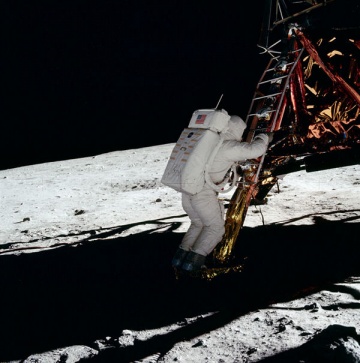 |
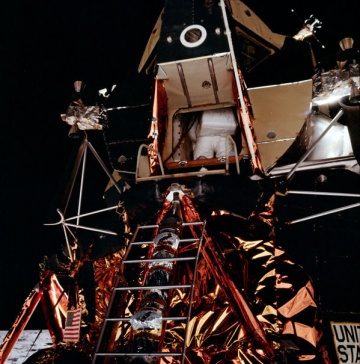
|
As can be seen in the shot to the left, the egress side of the LEM was supposed to be the shaded side. And yet, in the photo to the right, that entire side of the module is gloriously lit, and we are apparently supposed to believe that that is entirely the result of reflected light. Aldrin is even very well lit and he hasn’t even climbed out of the hatch yet!
Moving on, the guys also tried to ‘debunk’ the claim that NASA’s Moon photos shouldn’t depict non-parallel shadows. The hosts took a rather novel approach though: they used a single studio light source in close proximity to the subjects to reproduce an image that had been created by using a single studio light source in close proximity to the subjects. They then, of course, proclaimed that yet another ‘myth’ had been ‘busted.’ Nice work, guys.
1/6 gravity & Mythbusters hilarity
The most revealing segment of the show concerned the way that the astronauts moved in NASA’s video footage. The hosts picked out three brief clips showing the astronauts running, skipping and jumping. One of the two hosts then donned a spacesuit and was filmed recreating the movements. That tape was then played back at half-speed and compared to the original. The same would-be actor then performed the same movements while suspended from cables. In both cases, the new footage did not match the original.
It was perfectly obvious, however, that the awkward movements by Mythbusters’ fake astronaut were very different than the movements by NASA’s fake astronauts. A much easier, and far more relevant demonstration would have been to simply speed up the original footage. When this was done, albeit very briefly, it was perfectly obvious that the astronauts were moving in normal, earthly ways. But because the hosts couldn’t reproduce the footage using a hack who appeared to be doing a deliberately piss-poor job of reproducing the motions, the demonstration was deemed to be inconclusive.
The only way to resolve the issue, according to the hosts, was to do a demonstration in a 1/6 gravity environment. Luckily for the guys, they had access to a ‘vomit comet.’ While normally used to provide a zero-gravity environment for training purposes, by slightly adjusting its flight path the plane can also simulate the Moon’s gravity. But by filming this demonstration, the show unwittingly showed viewers how the Apollo crews would have really moved if they had been on the Moon.
As the spacesuited host informed viewers, “at 1/6 my weight, I felt pretty weightless. I felt like I could jump ten feet in the air.” And indeed it was perfectly obvious that, had he not been in a plane with very limited headroom, he could have effortlessly jumped ten feet in the air. Hilariously, the uninhibited support crew can be seen in the background easily performing dazzling acrobatic feats, such as the guy to the left of the frame effortlessly balancing on one hand, and the other guy in the background floating through the air in a ninja pose.
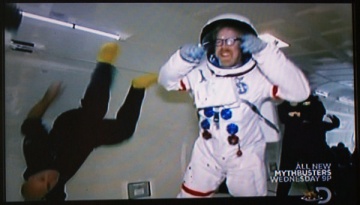 |
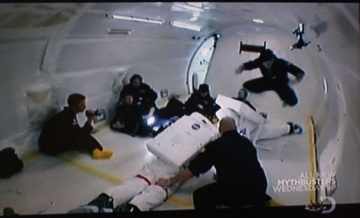
|
These are the types of movements that the Apollo boys would have been able to perform with ease had they actually been on the Moon. And yet we saw nothing of the sort in any of the alleged transmissions from the lunar surface. Nevertheless, the Mythbusters gang haughtily declared that they had successfully ‘busted’ yet another ‘myth.’ What they had actually done, thus far, was to perform three completely meaningless demonstrations (the flag, the boot print, and the non-parallel shadows simulation) and two more demonstrations that, despite the hosts’ contentions to the contrary, clearly confirmed claims made by ‘conspiracy theorists.’
In the show’s final segment, they presented what was billed as the “ultimate proof of man’s Moon missions” – which turned out to be nothing more significant than laser ranging targets.
Really, guys?! That’s the best you can do? After failing throughout the hour to ‘debunk’ a single ‘conspiracy’ claim, you’re now going to brazenly claim that the existence of man-made artifacts on the Moon is the “ultimate proof” that Apollo astronauts walked on the lunar surface? Are you fucking kidding me? There are manmade artifacts on Mars and Venus as well, so I guess we have “ultimate proof” that NASA has secretly sent men to other planets. And my kid’s ball is over in the neighbor’s yard right now, so I guess we have “ultimate proof” that she’s been there.
I’d have to say that, while I obviously would have done things a little differently, overall the guys did a pretty good job of busting that ridiculous myth about man walking on the Moon.
History of space suits & EVA's
Let’s now turn our attention to some of the other technology that had to be developed for the Apollo program, beginning with those magic suits. “In the early 1960s, as NASA began training astronauts to meet President Kennedy’s challenge, it realized there was one key area of expertise it knew nothing about. Nobody knew how to build a spacesuit that would enable a human being to survive in the lethal lunar environment.”
So begins Moon Machines: The Space Suit. As previously noted, Alan Shepard had ridden the first manned Mercury capsule into sub-orbit just before Kennedy’s announcement. The Mercury program, launched in 1959, just after the formation of NASA, was America’s first space program. The suits used for that program were, according to both NASA and the talking-heads on the Science Channel, redundant. The capsules provided the astronauts with their first line of defense; the suits were only an emergency back-up that no one was sure would even work.
But now, with Kennedy’s commitment to the Apollo program, our astronauts were going to need suits that provided their first and only line of defense. NASA did not yet have suits that could operate off the ship’s life support systems through umbilical cords (such as would be needed to perform space-walks) and now it needed suits capable of providing fully independent life support. In other words, starting essentially from scratch, NASA was going to have to come up with one of the most technologically advanced spacesuits ever conceived. And it was going to have to do it very quickly.
Eight companies reportedly submitted proposals to NASA for consideration. Almost all were companies that were known within the aerospace industry. One, however, was known for its work in a somewhat different field of endeavor; the International Latex Corporation was best known as the manufacturer of Playtex bras and girdles. Improbably enough though, it would soon be adding Apollo spacesuits to its product line.
(Wikipedia, it should be noted, contains a much different version of events than what was provided by Moon Machines, including a claim that ILC began designing spacesuits “as early as 1955.” The version provided by the Science Channel, however, came directly from the people who were involved in the project. And the company’s own promotional materials hold that “ILC started designing suits on 1961; started making test and prototype suits in 1964; and started delivering suits for use by Apollo astronauts in 1966.”)
In April 1962, NASA awarded the Apollo spacesuit contract to ILC. Hamilton Standard, a company known for manufacturing aircraft propellers, was assigned to oversee the project. ILC quickly put its bra and girdle seamstresses to work cutting and sewing Apollo spacesuits. Meanwhile, Hamilton Standard went to work designing and building the life-support packs, known as PLSS units.
Amazingly enough, the first spacesuits to roll off the line were delivered to NASA for testing in 1963. ILC had designed and built the suits in just over a year. Unfortunately though, they had a major flaw: astronauts testing them quickly overheated in the Florida sun, which is roughly 160° F cooler than the surface of the Moon. NASA issued an ultimatum to Hamilton Standard: solve the cooling problem and do it immediately or the contract would be cancelled.
The solution was to design a water-cooled undergarment. By early 1964, just two years after the awarding of the contract, the redesigned suits were being shipped to NASA for testing. NASA, however, was still not impressed with what Hamilton and ILC had come up with. The suits were deemed to be too heavy, extremely difficult to move around in, and intensely uncomfortable to wear even for short durations.
In the fall of 1964, NASA cancelled the contracts with both ILC and Hamilton Standard. With just five years left to fulfill Kennedy’s dream, NASA had no working spacesuits and no contract with anyone to design and build working spacesuits. After briefly experimenting with so-called ‘hard suits,’ NASA decided in the spring of 1965 to reopen the bidding on the spacesuit contract. Both Hamilton and ILC again submitted proposals, and again the contract was awarded to the makers of Playtex bras. Hamilton was awarded a separate contract to design and build the life support packs.
Just weeks after NASA awarded those contracts, Gemini astronaut Ed White allegedly became the first American to perform a space-walk, despite the fact that NASA did not yet appear to have a suit that would allow for such a maneuver. Nevertheless, on June 3, 1965, White allegedly performed a successful 22-minute EVA (extra-vehicular activity, in NASA jargon) which was yet another “We can do it too!” response to the Soviet Union’s first space-walk.
As astronaut Gene Cernan recalled, Leonov’s space-walk on March 18, 1965 “shocked a lot of people. It caught us totally unexpected, and, you know, we were just barely flying in space in our own little capsules. They weren’t even big enough to be called spaceships.” Indeed, the United States hadn’t yet gotten its first two-man capsule into space. The Mercury program, which had ended nearly two years earlier, had only gotten four single-occupancy capsules into orbit. NASA’s plan had been to attempt a space-walk on the fourth manned Gemini flight, and it had not yet gotten the first Gemini capsule off the ground.
NASA’s plan apparently changed rather abruptly and a few days before the launch of Gemini 4, which was only the second manned Gemini mission (the first having completed just three orbits), it was announced that White would be performing an EVA while Jim McDivitt piloted the capsule. According to astronaut Frank Borman, “NASA scrambled around kind of hurriedly and, in my estimation, without a great deal of safety factor, had Ed go EVA on Gemini 4.”
As McDivitt recalled, “Our EVA was very confidential at the time. We had not announced we were gonna do this, and we were doing all of our training at night, and only a group of maybe 30 or 40 people even knew we were gonna try it.” Translated from NASA-speak, what that very likely means is that a select group worked covertly with the astronauts to fake the space-walk footage prior to the launch of Gemini 4.
Notably, NASA did not attempt the maneuver again for an entire year, until June 3, 1966, despite the fact that four Gemini capsules were launched during the intervening year and those four spent a combined total of twenty-three days in low-Earth orbit. Yet none of those four crews, it would appear, had time to practice space-walking, even though practicing and perfecting EVAs was one of the primary goals of the Gemini program. Not even Frank Borman and Jim Lovell, who spent nearly two weeks orbiting Earth in a tiny capsule with virtually nothing to do for the majority of their mission, had time to perform a space-walk.
It was not until Gemini 9 that NASA attempted to duplicate White’s alleged performance. But that ‘second’ space-walk, by Gene Cernan, was by all accounts a complete failure that almost cost Cernan his life. Problems began almost immediately, with Cernan’s heart rate at times soaring as high as 170. His visor became fogged, leaving him blinded and disoriented. His breathing was labored and he was sweating profusely. Doctors on the ground monitoring the situation feared he would not make it back in alive and would have to be cut loose.
The next two EVA attempts, by Michael Collins aboard Gemini 10 and Richard Gordon aboard Gemini 11, were failures as well. As 1966 was drawing to a close, three astronauts in a row had failed to replicate what Ed White had supposedly easily accomplished over a year earlier. But then, in November 1966, a year-and-a-half after White’s alleged space-walk, none other than Buzz Aldrin performed a wildly successful EVA during the Gemini 12 mission. Aldrin had come through just in time – Gemini 12 was the last Gemini mission.
In sum, the Gemini program resulted in one faked EVA, three failed EVAs, and one presumably successful EVA. Even if we give the agency every benefit of the doubt, the record would be three failures and only two successes. And with that impressive record, we were ready to send our guys off on a series of EVAs of a complexity that remains unmatched to this day. Have I mentioned lately, by the way, that America totally kicked ass in the 1960s?
Curiously, the footage of White’s alleged space walk is characterized by the very same slow-motion photographic technique later employed on the alleged Moon missions. The footage released by the Soviets of Leonov’s EVA, on the other hand, does not appear to be slowed down. The logical conclusion to draw, of course, is that moving in slow-motion in space is more a matter of culture than science.
The final spacesuits sent by ILC to NASA were supposedly composed of three layers: the water-cooled undergarment, a pressurized inner suit that featured flexible, bellows joints, and a white outer covering made of an experimental fabric known as Beta cloth. The bra and girdle manufacturer, which I’m guessing must have had a large engineering division, designed and built the entire integrated suit, including the helmet and visor and the specially designed boots and gloves.
The Apollo spacesuits supposedly weighed in at 180 pounds each, including the PLSS backpacks. You would think that with the advanced technology now available, NASA would have been able to streamline the package. To the contrary, the suits now worn aboard the space shuttle weigh in at 310 pounds each. And ILC claims that it takes three months and 5,000 man-hours to produce each one. Back in the ‘60s, they claimed to be cranking out a minimum of nine of them for each Apollo flight.
One final note on the magic suits: they also were allegedly designed for what was euphemistically dubbed “sanitation management.” According to the designers, the suits contained urine bags attached to the astronauts via what were described as condoms. How that would have possibly worked is anyone’s guess. The existence of fecal bags was also alluded to, but no details were given.
For what it’s worth, NASA says that its astronauts now wear what are euphemistically dubbed ‘MAGs,’ or Maximum Absorbency Garments, under their spacesuits. The same product is more commonly referred to as an adult diaper. And that is likely what the Apollo crews would have worn as well had they actually gone on their alleged missions. That would though, I suppose, have taken a bit of the glamour away from the romanticized notion of being a space traveller.
The command module
Another piece of advanced technology that had to be developed for the Apollo program was the command module – the cone-shaped tip of the Saturn V rocket that was to be the only piece of the original launch vehicle that returned to Earth. To this day, the Apollo command modules remain the only capsules ever designed that were allegedly capable of keeping astronauts alive while reentering the Earth’s atmosphere from outside of low-Earth orbit.
According to those who claim to know about such things, reentering from beyond low-Earth orbit is an exponentially more risky manoeuvre than reentering from Earth orbit. First of all, the Apollo capsules were allegedly travelling at 25,000 mph at the time of reentry as opposed to the 17,000 mph that spacecraft travel in Earth orbit. That additional speed results in a doubling of the already intensely high temperatures experienced during reentry.
In addition, the returning Apollo command modules had to enter Earth’s atmosphere at precisely the right angle. If they hit at too wide an angle, the spacecraft would essentially bounce off and veer off into space. And if they hit at too sharp an angle, the spaceship and it’s crew would not survive the impact. The capsule also had to be in the proper orientation, with the bottom, and thus the heat shield, pointing down. Luckily though, all nine of the Apollo modules that allegedly returned from the Moon hit that narrow window in the proper orientation, despite the fact that the command modules, having jettisoned the attached service modules, had no propulsion or steering capability.
The contract to design and build the command modules was assigned to North American Aviation, whose engineers, it’s safe to say, had quite a formidable task before them. As noted on Moon Machines, the combined command and service modules would require a propulsion system, a navigation system, an environmental control system, plentiful supplies of oxygen, water and food, heat shields capable of handling reentry temperatures beyond anything before experienced, parachutes capable of performing near-miraculous feats, a human waste disposal system, shaving supplies, hygiene supplies, life preservers, protection from micrometeorites, and, for reasons left unexplained, machetes.
What also wasn’t explained was why the lunar modules, which would be exposed throughout the flight to the Moon, didn’t need that very same “protection from micrometeorites.”
By the end of 1966, naturally enough, North American already had a prototype command module ready for NASA to put through the pre-flight test regimen. As designed, the command module featured living space measuring roughly 6’x6’x6’. On January 27, 1967, Gus Grissom, Roger Chaffee and Ed White squeezed into that confined space for what was dubbed a ‘plugs out’ test, to verify that the ship was capable of running under its own power. There was another test scheduled that day as well – a pressurization test of the cabin.
Allegedly to “save time,” NASA opted to conduct both tests simultaneously. So once the astronauts were in place, the cabin was filled with 16 PSI of pure oxygen. With the inward-opening hatch sealed by the interior cabin pressure, the astronauts never had a chance to survive the ‘test.’ All it took was a spark, allegedly from some faulty wiring, to turn the capsule into a crematorium. In a pressurized oxygen environment, even aluminum will ignite. The crew reportedly were dead within 30 seconds of the onset of the fire. It took rescuers five minutes to pry the hatch open.
Weighing in with perhaps the most appalling quote to make it into these articles, George Jeffs, the chief engineer of the command and service modules, had this to say: “From a technical point of view, I think the fire had a, a very beneficial final effect on the program. It enabled the program to stop and re-review exactly where we stood on every element of the system and to fix every problem that we saw in the system.” Of course, roughly the same effect would have been achieved by burning up the module while the astronauts weren’t in it, but there is no need to quibble over minor details, I suppose.
It took eighteen months to redesign the command modules. Over 100 design changes were made to correct various shortcomings. This redesign process was undoubtedly made more difficult by the fact that no paper records had been kept of what had been installed in the module. As we have already seen, the Apollo program didn’t place a high priority on record keeping.
One bit of technology that had to be developed for the command modules (presumably for the lunar modules as well) was what Moon Machines described as “an environmental control system designed to cope with the most extreme environment ever encountered by humans.” Cliff Hess was an environmental systems test engineer with NASA during the Apollo days, and he described the challenge they faced as follows: “You can go from +250° F down to -250° F, and it can happen just as you cross the line of a shadow … so you can instantaneously go from one extreme to the other and have like a 500° F change.” Apollo 8 astronaut Frank Borman described his alleged flight to and from the Moon in precisely the same terms: “You’d be 250° plus on the sunny side, and once the spaceship rotated and you were in the shade, [then] you’re minus 250°!”
This is yet another example of a claim that I previously made that was ridiculed by the ‘debunker’ brigade as being ill-informed. And yet here we see once again that the very same claim has been made by one of the guys who actually worked on that aspect of the project, as well as by one of the guys who allegedly flew the missions. It’s rather shocking to find that so many of the people who developed and/or utilized the Apollo technology actually know significantly less about it than the ‘debunkers.’ Before running their mouths off to documentary film crews, these old-timers really should visit a couple of ‘debunking’ websites.
I wonder why it is, by the way, that the Apollo 13 astronauts were said to have been very cold throughout their return flight in their allegedly crippled spaceship? As recalled by Jim Lovell, “The trip was marked by discomfort beyond the lack of food and water. Sleep was almost impossible because of the cold. When we turned off the electrical systems, we lost our source of heat, and the sun streaming in the windows didn’t much help … It wasn’t simply that the temperature dropped to 38° F: the sight of perspiring walls and wet windows made it seem even colder. We considered putting on our spacesuits, but they would have been bulky and too sweaty … We found the CM a cold, clammy tin can when we started to power up. The walls, ceiling, floor, wire harnesses, and panels were all covered with droplets of water.”
There is so much wrong with that brief description of the flight that it is difficult to know where to begin critiquing it, but let’s start by pondering why they would have been short on food and water. The mission ended up returning a few days early, so unless they overindulged the first few days, there should have been more than enough food and water for the trio in the conjoined command and lunar modules. And as for the cold, how could that 250° F “sun streaming in the windows” not help much? What does Lovell use to warm himself at home – a blowtorch?
As for the water droplets covering the interior of the command and lunar modules, wouldn’t many of those droplets have been airborne if they were in a zero-gravity environment? Wouldn’t the inside of the module have looked something like a snow-globe? And as for opting not to don the spacesuits, that is just laughably absurd. As already noted, without the suits the only thing that would have been protecting the astronauts from the hazards of space was a double layer of aluminium foil. For that reason alone it is inconceivable that they wouldn’t have been wearing them. And now we find that they were also facing near-freezing conditions and yet they still chose not to utilize the suits – because the suits were, you know, a little bulky, and it is much better to nearly freeze to death than it is to break a little sweat.
Anyway, returning more or less to where we left off, Apollo 7, equipped with the redesigned command module, became the first manned Apollo flight to triumphantly lift off from Cape Kennedy on October 11, 1968. Three previous flights had gone up unmanned. This one wasn’t quite a real Apollo launch, however, since it was powered by the smaller Saturn 1-B rocket. No one had yet ridden a Saturn V rocket off the launch pad, and there was just one year to go to meet Kennedy’s goal of landing men on the Moon.
Apollo 7 was the first of a series of Apollo launches that came in incredibly rapid succession. Just 71 days after Apollo 7 took flight, Apollo 8 lifted off. Apollo 9 followed just 72 days later, followed by Apollo 10 only 76 days after that. A mere 59 days later, Apollo 11 took flight. In just nine months, NASA assembled and launched five incredibly complex, multi-staged rockets (and ILC provided at least forty-five spacesuits). Three of those ships allegedly flew all the way to the Moon.
Apollo 8 would be the first to allegedly do so.
Part X
7 December 2009
“The mission of Apollo 8, quite apart from its significant scientific meaning, stimulated an immense rejuvenation of the spirit of mankind, and that spirit needed rejuvenation. A year featured by two grim assassinations [MLK and RFK], by riots, by racial and social strife, and a baffling attempt to end the war left men with a dull sense of frustration. Then at the end of such a year came the Apollo 8, an incredible adventure.”
Dr. Norman Vincent Peale, 33° Scottish Rite Freemason
Masters of the Universe
Apollo 8 was the last Apollo flight to leave the ground during the Johnson administration. A decade before the launch, LBJ had laid out America’s goals in the space race, and none of them had much to do with sending men to the Moon: “Control of space means control of the world. From space, the masters of infinity would have the power to control Earth’s weather, to cause drought and flood, to change the tides and raise the levels of the sea, to divert the gulf stream and change the climates …”
I thought it was global warming that was supposed to be causing most of that, but I guess that is a bit off-topic.
To anyone paying close attention in the 1960s, the ridiculously improbable flight of Apollo 8 should have sent a clear signal that the Apollo Moon missions were going to be seriously lacking in credibility. Launched on the winter solstice of 1968, Apollo 8 was only the third launch of a Saturn V rocket, and the first to carry a crew. The first two Saturn V launches, Apollo 4 and Apollo 6, were what NASA referred to as “all-up” tests of the three-stage launch vehicle. Those tests didn’t go so well.
The team of rocket scientists who had developed the F-1 and J-2 rocket engines that powered the flights – most of whom were former Nazis recruited through Project Paperclip and relocated first to White Sands and then to the Marshall Space Flight Center in Huntsville, Alabama (one of the best sources of information on this is Linda Hunt’s Secret Agenda, St. Martin’s Press, 1991; see also Tom Bower’s The Paperclip Conspiracy, Little, Brown, 1987) – had assumed that each stage of the craft would be tested separately. They were reportedly horrified to find that NASA was bypassing such tests and proceeding directly to an ‘all-up’ test of Apollo 4 – but probably not nearly as horrified as the American people would have been had they known the truth about the past lives of NASA’s rocket scientists.
Nevertheless, the launch of Apollo 4, the very first Saturn V launch, was allegedly a smashing success. That claim seems rather dubious, however, given that the next all-up test, of Apollo 6, was marked by multiple malfunctions. The first-stage burn had serious vibration problems, and two of the second-stage’s five engines cut out, throwing the ship seriously off course.
According to Moon Machines, NASA was undeterred by the serious problems encountered during the flight of Apollo 6: “Despite the near loss of Apollo 6, NASA was pushing ahead with Apollo 8, the third flight of the Saturn V and the first to carry a crew.” NASA was so confident, in fact, that they decided to throw caution to the wind and swing for the fence with Apollo 8: “The third flight of the Saturn V would carry astronauts not to orbit the Earth, as everyone had expected, but to orbit the Moon.”
Had the Apollo program been a real space exploration endeavor, the first manned flight of the Saturn V would obviously have gone no further than low-Earth orbit, as had been planned. This would likely have been followed by an unmanned flight to the Moon, and then possibly a flight ‘piloted’ by a dog or some other such mammalian life form. But taking logical, methodical steps toward achieving goals in space was for those pussies over in Russia. America was going to take the John Wayne approach.
Without taking any of the preliminary steps, and with a launch vehicle that had failed on its last outing, and without knowing if the ship itself could make the journey there and back, America was going to send men all the way to the Moon!
Not to worry though: NASA was confident that all the problems with Apollo 6 had been diagnosed and fixed, and in record time. Despite the fact that the failed stages of the aircraft weren’t available for inspection, NASA’s crack team was able to expertly pinpoint and correct all the deficiencies so thoroughly that the new and improved Saturn V rocket didn’t even need a test flight to be sure it was working correctly. Indeed, it was ready to go all the way to the Moon!
Given America’s track record in the space race, which from the very beginning was marked by disappointments and desperate attempts to keep up with the Joneses, it was a seriously ballsy move. Following the October 4, 1957 launch of Sputnik I, a 184-pound Soviet satellite, the U.S. attempted to respond by launching Vanguard, a 3-pound sphere roughly the size of a large grapefruit, on December 6, 1957. With the nation nervously looking on, Vanguard rose approximately five feet from the launch pad before blowing up in a blaze of glory.
The U.S. had better luck on January 31, 1958, when it officially entered the space race with the successful launch of Explorer 1, a 31-pound satellite. The Soviets, meanwhile, had already successfully launched Sputnik III, a nearly 3,000-pound satellite described in Time-Life’s To the Moon as an “orbiting space laboratory.” America clearly had some catching up to do.
Once NASA’s engineers turned their attention to the Moon as a target of unmanned space flights, ‘disappointment’ continued to be the operative word. Beginning in August of 1961, the United States began attempting to crash-land an unmanned craft onto the Moon through the Ranger program. The first six such attempts failed. Ranger 1 and Ranger 2 both failed on the launch pad, Ranger 3 launched successfully but missed the Moon, Ranger 4 became disabled and drifted about aimlessly, Ranger 5 also shut down and missed the Moon, and the cameras aboard Ranger 6 failed, rendering it useless.
Finally, on July 31, 1964, nearly three full years after the first launch, Ranger 7 successfully impacted and photographed the Moon. Rangers 8 and 9 followed in February and March of 1965. The three successful probes gathered a combined total of roughly 17,000 images, which didn’t change the fact that the Ranger program overall had a 67% failure rate.
The next year, NASA launched two new lunar reconnaissance programs: Surveyor and the Lunar Orbiter Program. The first Surveyor blasted off on May 30, 1966, with six more to follow, the last on January 7, 1968. The goal of the program was to attempt ‘soft landings’ on the lunar surface. Two of the missions, Surveyor 2 and Surveyor 4, crashed, leaving the program with roughly a 29% failure rate. The Surveyor and Ranger programs had a combined failure rate of 50%.
NASA had much better luck with the Lunar Orbiter Program, which involved putting five satellites into lunar orbit between August of 1966 and August of 1967. Each of the five orbited the Moon, capturing high-resolution images, for an average of ten days each. In addition to mapping the lunar surface, the Orbiters also sent back the first images of Earth from space and the first photos of the Earth rising over the lunar horizon. In all, some 3,000 images were beamed back – officially at least.
The problem here, of course, is that NASA’s numbers don’t seem to add up. Does it make any sense at all that the three successful Ranger missions, which flew directly to the Moon and immediately crashed, sent back 17,000 images, and yet the five Orbiters, which spent a combined total of fifty-three days orbiting the Moon, sent back just 3,000 images? That’s a capture rate of just over two images per hour. And the Orbiters had multiple cameras on board.
There is little doubt that the Orbiters returned far more images than claimed, of which only a select few (relatively speaking) were released. What then happened to the rest of them? I’m going to go way out on a limb here and guess that NASA needed those images for another, more important project: faking the Apollo Moon landings. All of those glorious shots of Earth from space, and of Earth-rises, and of superimposed spacecraft in lunar orbit were undoubtedly created from unreleased imagery captured by the Orbiters. As were, no doubt, the fake lunar sets and the fake lunar backdrops.
One final note on the Lunar Orbiters: during their flights to and around the Moon, the five satellites recorded twenty-two “micrometeoroid events.” The eight lunar modules that made the trip to the Moon apparently recorded no such events. Or maybe the guys just put some duct tape over the holes.
Meanwhile, NASA’s manned space programs were having trouble as well. In the beginning, of course, there were the Mercury 7, the nation’s first space-age celebrities. Immortalized in The Right Stuff, the first seven astronauts were hand-picked from among hundreds of the nation’s finest fighter pilots. Six of those seven – Alan Shepard, Gus Grissom, John Glenn, Scott Carpenter, Wally Schirra, and Gordo Cooper – would become the first Americans in space, but for most of them it would not be an entirely smooth ride.
Shepard was the first to take flight aboard the Freedom 7, launched on May 5, 1961. His was an uneventful, 15-minute sub-orbital flight. Grissom followed on July 21, 1961 in the Liberty Bell 7, and things didn’t go so well for him. As with Shepard, his was just a sub-orbital flight, but it nearly cost him his life. Immediately after splashing down, the hatch blew on his capsule and it began taking on water. Grissom got free, but his suit, which was supposed to serve as a floatation device, also began taking on water, pulling him under.
Grissom’s plight did not improve with the arrival of a rescue helicopter, which concentrated exclusively on trying to save the capsule, ignoring the struggling Grissom who now also had to contend with the helicopter’s rotor wash. Grissom was pulled to safety only when a second rescue helicopter arrived. The capsule sunk to the bottom of the sea, three miles below.
Glenn was up next, and he was slated to be the first American in orbit. Riding aboard the Friendship 7, launched on February 20, 1962, Glenn did indeed make it into orbit, but NASA was not at all sure that they were going to be able to get him back. The launch had been delayed for a month as NASA worked out various problems, but there was still a serious glitch: during Glenn’s second orbit, technicians on the ground determined that the heat shield, essential for reentry, had come loose.
Glenn’s capsule was seriously damaged during reentry, but he survived unharmed and became an instant national hero.
Next up was Carpenter, who orbited the Earth three times aboard the Aurora 7 on May 24, 1962. Running low on fuel, Carpenter barely made reentry, and the wrong angle of reentry caused him to splash down some 250 miles off course and out of radio contact. It took rescue crews three hours to find him floating in the Atlantic. Some on the ground blamed Carpenter for the mishap, claiming that he had wasted fuel by acting like a tourist trying to see all the sights (you can’t really fault the guy for that – he was probably wishing that he had rolled a fatty to bring along).
Schirra was up to bat next, and he blasted off on October 3, 1962 aboard the Sigma 7, completing six orbits in just over nine hours. His was the first flight since Shepard’s, and the first orbital flight, to be free of any significant malfunctions.
The final Mercury flight was helmed by Cooper, who lifted off on May 15, 1963 inside the Faith 7 capsule. Cooper completed 22 orbits and was the first American to sleep in space. Problems arose in the final hours, however, when the capsule’s automatic controls failed and Cooper had to execute the first fully manual reentry. It would be nearly two years before the next Americans followed Cooper into space.
Overall, the Mercury program was largely a success in the sense that everyone made it back alive and well, but America had a very long way to go to get men to the Moon.
Next up was the Gemini program, featuring a larger, two-man capsule. Gemini, which ran from March of 1965 until November of 1966, had very specific goals: testing man’s ability to survive in space for up to two weeks; testing rendezvous and docking procedures; performing EVAs (space-walks); and making orbital adjustments. All of these were to be practiced until they became almost second nature.
The Gemini capsules were launched into orbit with Titan rockets, which proved to be a bit unstable at first. The first launch attempts blew up on the pad. Eventually NASA successfully launched two that didn’t blow up, and those were christened Gemini 1 and Gemini 2. Those were followed by ten manned Gemini flights, beginning with Gemini 3 launched on March 23, 1965, and concluding with Gemini 12, which took flight on November 11, 1966.
The flight of Gemini 3 was a short one – completing three orbits in just under five hours. Due to an equipment malfunction, pilots Gus Grissom and John Young had to manually control their reentry and splashed down some sixty miles off target. Other than that, the first manned Gemini mission was successful. Gemini 4, launched on June 3, 1965, remained in orbit for just over four days and featured the alleged space-walk by Ed White (NASA’s photos of which are, needless to say, spectacular).
Dishevelled Gemini - pristine Apollo crews
 |
 |

|
After a successful lift-off on August 21, 1965, Gemini 5 remained in low-Earth orbit for nearly eight days, completing 120 orbits. The flight was largely successful, though a malfunctioning fuel cell and faulty thrusters did cause some problems for the crew.
Upon their return, it should be noted, the Gemini 5’s pilots, Gordo Cooper and Pete Conrad, looked tired, haggard and unshaven, with their hair greasy and matted. In other words, they looked exactly as you would expect guys who had just spent a week in a cramped spaceship with no means of attending to basic matters of hygiene to look. Below, left to right, are photos of Conrad after returning from his eight-day mission, Lovell after returning from a four-day mission aboard Gemini 12, and Lovell again toward the end of his fourteen-day flight on Gemini 7.
The Apollo astronauts, on the other hand, all arrived home looking rested, shaved and fresh faced, as though they had just returned from a day at the spa. Apparently they found room to include a shower and various other amenities on those Apollo spacecraft.
The next scheduled launch was Gemini 6, set to take flight in late October of 1965. The flight was postponed, however, due to the failure of an unmanned Agena craft launched as a docking target. On December 4, Gemini 7, with Frank Borman and Jim Lovell on board, began a grueling fourteen-day stay in low-Earth orbit. About a week later, Gemini 6 was once again ready for launch, but that launch was aborted when an engine shut down, narrowly averting a fatal explosion on the pad.
Gemini 6 finally got into low-Earth orbit on December 11 and remained there for just over one day. During that time, Gemini 6 allegedly performed a rendezvous maneuver with Gemini 7, the two spacecraft remaining side-by-side for some 5.5 hours while traveling at 17,000 miles per hour. Curiously, there was a launch of a military rocket in between the launches of Gemini 6 and Gemini 7, and Lovell has said that that launch was connected in some unspecified manner to the mission of Gemini 7.
Gemini 8, helmed by Neil Armstrong and David Scott, blasted off on March 16, 1966. The goal of the mission was to test rendezvous and docking procedures and to achieve the first successful docking between a Gemini capsule and an unmanned Agena craft. Curiously, the two pilots chosen for this complex mission were both rookies. The crew that had originally been slated to fly the mission, Elliot See and Charles Bassett, were killed on February 28, 1966, just days before the launch, when See, one of the nation’s top pilots, slammed a T-38 Talon into the side of a building in St. Louis.
Gemini 8 reportedly succeeded in docking with the Agena target, but trouble began almost immediately. The conjoined spacecraft began to tumble violently end-over-end, forcing Armstrong to jettison the Agena. That, however, only caused the Gemini capsule to tumble even more violently. Armstrong finally had to resort to firing the rockets used for reentry positioning to stabilize the craft, which necessitated immediately aborting the mission. The capsule splashed down in the Pacific, a half-a-world away from its target in the Atlantic.
On June 3, 1966, Gemini 9, piloted by Tom Stafford and Gene Cernan, took flight. The launch had been postponed due to the failure of another Agena target. The goal was, once again, to dock with an unmanned Agena craft. That docking failed to materialize, however, when yet another Agena target malfunctioned. This was also the flight on which Cernan took his nearly fatal space-walk (there was debate on the ground over whether he should be cut loose to drift in space or left tethered to burn up upon reentry if he couldn’t make it back in).
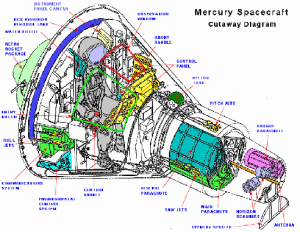 |
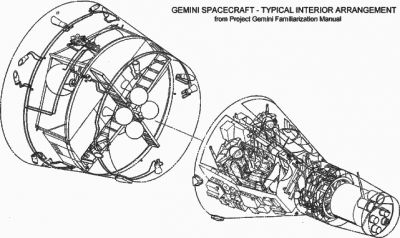
|
Following Gemini 9, there were only three manned Gemini missions left and the United States had thus far failed to come anywhere close to mastering either docking procedures or EVAs, both of which would be absolutely essential for the success of the proposed Apollo missions.
Gemini 10, with John Young and Michael Collins at the wheel, lifted off on July 18, 1966 and remained in orbit for just under three days. Young and Collins reportedly achieved the first successful, stable docking of a Gemini capsule with an Agena target. Collins also performed a largely unsuccessful EVA, though not as disastrous as Cernan’s on the previous flight.
Gemini 11, piloted by Charles Conrad and Richard Gordon, took to the skies on September 12, 1966 and, like Gemini 10, remained in orbit for just under three days. And like Gemini 10, the mission included a docking maneuver with an Agena target and a less than fully successful space-walk (by Gordon).
The final Gemini mission, Gemini 12, put Jim Lovell and Buzz Aldrin into low-Earth orbit for just under four days. Aldrin completed the first fully successful space-walk and the two pilots once again practiced docking with an Agena target. NASA had come a long way since shooting Alan Shepard out of a cannon in May of 1961, but the Moon still seemed like a far-off goal. The progression from Mercury to Gemini – from a single-occupancy capsule to a somewhat more sophisticated, double-occupancy capsule, requiring a somewhat larger launch vehicle – was a natural one. NASA’s next step, however, was going to be more of a quantum leap.
The Saturn V rocket bore little resemblance to any previous launch vehicles. As Apollo flight director Gene Kranz observed, “It was a new spacecraft. It was something that we had to learn from the ground up – that we had to learn from scratch.” It was a massive, and massively complex, spacecraft. The Saturn V was so much larger than its predecessors that all previous manned launch vehicles – the six Mercury and ten Gemini vehicles – could fit inside a single Saturn V casing.
A fully assembled, launch-ready Saturn V stood 363 feet tall and weighed in at roughly 6,000,000 pounds, 90% of which was fuel weight. Depending upon who is telling the story, it contained either 6,000,000 or 9,000,000 parts. There were three disposable launch stages, atop which sat the lunar, service and command modules, which was then capped with a launch escape system that was jettisoned shortly after lift-off.
The 138-foot tall first stage featured five massive F-1 rocket engines, each of which consumed three tons of fuel per second. They were fed by a 331,000-gallon tank of liquid oxygen and a 203,000-gallon tank of refined kerosene, all of which was consumed in just two-and-a-half minutes, generating some 7,500,000 pounds of thrust (160,000,000 horsepower).
After that first stage fell away, at an altitude of approximately thirty-five miles, the 82-foot long second stage, powered by five J-2 rocket engines, took over. The J-2s burned a combination of liquid oxygen and liquid hydrogen, propelling the ship to an altitude of 115 miles. After the second stage dropped away, the 61-foot long third stage, powered by a single J-2 engine, took over, putting the spacecraft into low-Earth orbit.
As Time-Life noted, the third stage “will not be jettisoned at this time; instead, three hours later it will be restarted to fire the Apollo toward the moon. At 10,350 miles from Earth, the command module, powered by its service module, will separate from the third stage, make a half-circle turn back toward the third stage, as the lunar module shroud of the third stage opens. The command module will dock with the lunar module, which is to ferry the astronauts between the command module and the moon, then back it free of the third stage. After completing another half-circle turn, the two modules, nose to nose, will head toward the moon.”
Sounds easy enough. I can see why they were able to nail it every single time, unlike the problems they had with those troublesome Agena craft. Time-Life also fills us in on the details of the “probe and drogue” docking mechanism: “The probe, a 10-inch cylinder extending from the nose of the command module, must be inserted into a cone-shaped receptacle, the drogue of the LM … As the probe finds its mark, automatic spring latches lock the two together. The whole probe-and-drogue assembly will be removed, clearing the tunnel through which [the astronauts] will enter the LM. Inside the command module, [the command module pilot] flips a switch that frees the LM.”
Pictured below are the command module’s docking probe, the LEM’s drogue (with the LEM allegedly in Earth orbit on the alleged Apollo 9 mission, in yet another spectacular shot from NASA’s collection), and a close up of how the mechanism was supposed to work. Curiously left unexplained was how, with the probe-and-drogue assembly having been removed, the LEM was able to dock with the command module the second time, upon its return from the lunar surface.
I am sure though that the pud-pullers over at the BAUT forum will be able to explain it. Maybe they can also explain why it is that the space shuttle never went to the Moon. I was thinking about that the other day as I was reading another heaping pile of ‘debunker’ blather about how, once you’re into low-Earth orbit, 90% of the work of getting to the Moon is already done.
The ‘debunkers,’ you see, claim that comparing the distance astronauts travel into space today (200 miles) with the distance they traveled back in the magical 1960s (234,000 miles) is entirely unfair because it is, as any fool knows, during that first 200 miles that all the heavy lifting is done. Once you’re in low-Earth orbit, it is a fairly easy matter to briefly fire the engines and ‘slingshot’ out of orbit and set a course for the Moon. And getting back is just as easy – just ‘slingshot’ around the Moon and cruise on back to Earth. It hardly even requires any fuel. It’s just a matter of, you know, falling through the void of space.
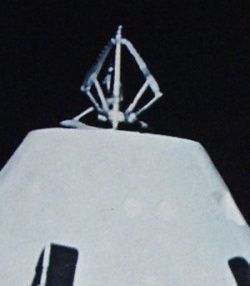 |
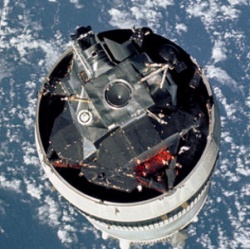 |
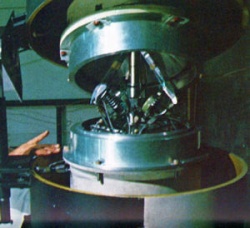
|
If that is the case, however, then how come none of the space shuttles, during the more than a quarter-century that the program has been in operation, has ever done a fly-by of the Moon? The Apollo 13 crew allegedly made the flight in a lunar module composed of Popsicle sticks and Scotch tape, and yet the obviously vastly more sophisticated space shuttle can’t make it there and back? Really?!
Why couldn’t it, on any one of its missions, have just used the old ‘slingshot’ approach to go to the Moon and back? And please, let’s not trot out the old “there was no reason to do that as there was nothing to gain” excuse, because that is clearly a complete load of horseshit. The space shuttle is far better shielded than the Apollo craft were, it carries plenty of fuel and plenty of provisions to last for the duration of the trip. Indeed, today’s astronauts should be able to travel to the Moon and back in relative comfort.
So why has it never been done? Apollo 8 did it all the back in 1968, which I started to talk about at the top of this post, before getting hopelessly sidetracked. More on that next time.
Part XI
30 December 2009
“To see the Earth as it truly is, small and blue and beautiful in that eternal silence where it floats, is to see ourselves as riders on the Earth together, brothers on that bright loveliness in the eternal cold – brothers who know now they are truly brothers.”
Archibald MacLeish, Skull & Bonesman (and uncle of Bruce Dern, for you LC fans), reflecting on the alleged flight of Apollo 8
Lookout Mountain Studio & Laurel Canyon
In the first of this series of posts, I mentioned that the Apollo story was connected to the Laurel Canyon story by way of a facility known as Lookout Mountain Laboratory, the intelligence community’s top-secret, state-of-the-art film studio nestled high in the Hollywood Hills. As it turns out, there is another interesting connection as well: during the span of precisely one month, during the infamous summer of 1969, the Laurel Canyon and Apollo stories reached a simultaneous climax, of sorts.
On July 16, 1969, Apollo 11, the flight that would allegedly land men on the Moon for the first time, took flight. Five days later, on July 21, Neil Armstrong and Buzz Aldrin allegedly first set foot on lunar soil. Three days later, the trio of Apollo astronauts triumphantly returned home to a hero’s welcome. Exactly one week later, the first letter from the so-called Zodiac killer was received by authorities. Eight days after that, on the night of August 8, 1969, Sharon Tate and four others were slaughtered in Roman Polanski’s Benedict Canyon home. The next night, Rosemary and Leno LaBianca were carved up in their Los Feliz home. All of these killings would later be attributed to canyon regular Charlie Manson and his Family. Less than a week after the killings, some of Laurel Canyon’s premier bands took the stage at Woodstock to celebrate the other side of the canyon scene.
It was a time of supreme weirdness, with extreme and very high-profile violence weaving its way through the flower-power scenes in both Los Angeles and San Francisco, while 234,000 miles away, squeaky-clean astronauts who bore little resemblance to members of the Woodstock generation allegedly beamed back live footage from the Moon.
Anyway, I think when we left off we were discussing the highly improbable flight of Apollo 8, the very first manned launch of a Saturn V, which took flight, as I previously mentioned, on the winter solstice of 1968. The mighty Apollo spacecraft, which had failed on its last unmanned outing, purportedly flew all the way to the Moon, did ten quick laps around Earth’s nearest neighbor, and then flew back home, with every one of its 9,000,000 parts performing flawlessly.
Thanks for that was due in part, according to the official Apollo legend, to a band of surfers in Seal Beach. North American Aviation, you see, had a bit of a problem with keeping the liquefied hydrogen and oxygen in the Saturn V’s second-stage from boiling in the Florida sun. The proposed solution was to insulate the fuel tanks with honeycomb insulation, but NASA’s engineers had trouble keeping the insulation from popping back off. The solution to that problem was to hire local surfers, who, according to Moon Machines, brought with them a “special skill set.”
NASA claimed, by the way, to shoot for 99.9% accuracy in the manufacture of its Apollo spacecraft, which shouldn’t have been a problem for a workforce composed of Nazi rocket scientists, bra seamstresses and surfers. Even if that lofty goal had been attained, however, that would still have left 9,000 defective parts per launch vehicle (6,000 if the figure of 6,000,000 parts is correct).
The first alleged live broadcast from the Moon came during prime time hours on Christmas Eve, though I’m sure that was just a chance occurrence. The three astronauts allegedly riding aboard Apollo 8 (Frank Borman, William Anders, and the ever-popular Jim Lovell), in what was billed as a purely spontaneous gesture, took turns reading aloud ten verses from the book of Genesis, which they followed up with: “Good night, good luck, a Merry Christmas and God bless all of you – all of you on the good Earth.” Obviously the Gideon people had thoughtfully left one of their bibles in the capsule sometime before launch.
The impeccable timing of the ‘historic’ Apollo 8 broadcast, reportedly heard by one of every four people on the planet, would set a standard that would be adhered to by all subsequent Apollo flights. The very first Moonwalk by Neil and Buzz was broadcast (‘live’ of course) at 9:00 PM Eastern time, as though it were a Monday Night Football game. Prime time Moonwalks became a staple of the Apollo program, to such an extent that it was not at all uncommon for the networks to be deluged with complaints when a popular weekly sitcom was preempted for yet another fake ‘live’ Moonwalk.
After the second fake Moon landing, NASA began adding exciting new elements to the Apollo missions to combat public apathy. Apollo 13, of course, added the element of danger. Apollo 14 brought us the Moon in Technicolor, with the first color video broadcasts. Apollo 15 kept us entertained with the addition of a Moon buggy. And Apollo 17 featured the first, and only, spectacular night launch of a Saturn V rocket.
Apollo 8 was quickly followed by Apollo 9, which was originally scheduled to lift-off on February 28, 1969, just two short months after the crew of Apollo 8 had splashed down. Luckily, the water in Southern California is a little cold during the winter months and the waves aren’t so good, so the surfers down in Seal Beach were probably able to put in lots of overtime to meet the demanding production schedule.
Apollo 9 was the first Saturn V flight to allegedly have a lunar module stowed away onboard. The mission allegedly featured the first docking maneuvers with, and the very first flight of, a lunar module, albeit in low-Earth orbit rather than in lunar orbit. Apollo 9 was also allegedly the first flight whose crew donned the newly-designed Apollo/Playtex spacesuits.
All things considered, Apollo 9’s ten-day flight in low-Earth orbit was largely a letdown after the previous crew had allegedly flown all the way to the Moon and back (and done so, like true cowboys, without the new magic suits). There was one very odd thing though, never mentioned in the official histories of the space program, that happened during the flight of Apollo 9.
While lounging in the command module, unencumbered by spacesuits, gloves and helmets, and with the luxury of being able to hold their NASA-issue cameras in their hands, the crew (James McDivitt, David Scott, and Rusty Schweickart) took photos of each other that are unfocused, poorly composed, and not particularly well exposed – which is, of course, exactly the results that one would expect from amateur photographers using cameras that lacked viewfinders.
However, after those very same astronauts donned their suits, gloves and helmets, and then ventured out for a spacewalk, making it rather difficult for them to stabilize themselves (and therefore their cameras), something truly wondrous and magical happened: the crew of Apollo 9 suddenly gained the ability to shoot absolutely stunning compositions that look like they were professionally produced in a studio. Though it’s hard to pick a favorite, the one featuring the Earth’s reflection perfectly framed in one of the actor’s helmet visors is pretty impressive.
 |
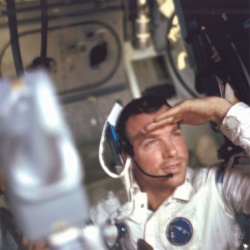
|
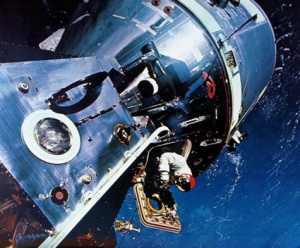 |
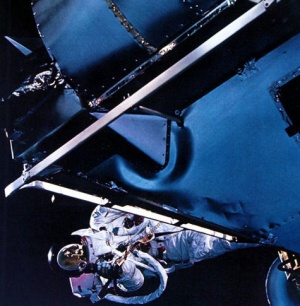
|
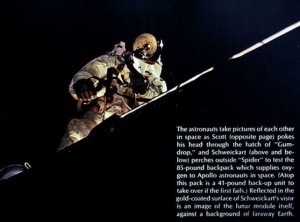 |
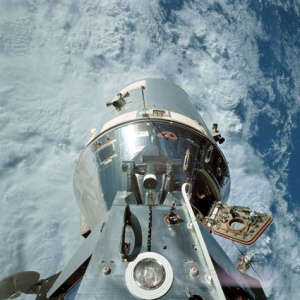
|
All of the astronauts on future Apollo missions, of course, proved themselves to be exceptional photographers as well, but only when operating under the most difficult of conditions. Neil Armstrong, the very first photojournalist to allegedly work on the Moon, that most foreign of environments, set the bar exceedingly high for all who were to follow. HJP Arnold, considered to be one of the world’s foremost authorities on space photography before his death in June 2006, once said of the film magazine allegedly shot by Armstrong:
“That sequence of images on the lunar surface, taken mainly by Armstrong of course with that one camera ... That film probably I would say has never, ever been bettered, whether on the Moon or subsequently. Almost every one of those relatively small number of images taken by Armstrong appear to be splendidly composed. You remember the classic face-on picture of Aldrin with his visor reflecting the entire landing scene – the lunar module, the flag, the TV camera, and Armstrong taking the picture, uh, reflected in the visor? It’s a marvelous picture!”
Despite all the acclaim he has received for his exploits as an astronaut, Neil Armstrong clearly has been unjustly denied recognition of his astounding abilities as a photographer. Some may argue that he clearly was not playing in the same league as, say, an Ansel Adams, but I beg to differ. Adams created some awe-inspiring work, to be sure, but could he have done so while wearing a spacesuit, gloves and helmet, and with his camera mounted to his chest, and while acclimating himself to an environment that featured no air, greatly reduced gravity, and extreme heat and cold?
I think not.
Speaking of staged photos, by the way, take a look at the one allegedly shot on the Moon by the last men to set foot there, the crew of Apollo 17 (Gene Cernan, Ronald Evans, and Jack Schmitt). It reminds me of something I’ve seen before, possibly some type of a symbol, but I can’t quite place it. (For more fun with Apollo images, drop by Jack White’s site where you will find a more thorough analysis of photo irregularities than I have seen anywhere else.)
Just two months after the return of Apollo 9, NASA sent Apollo 10 off to the Moon, with Tom Stafford, John Young and Gene Cernan onboard. The space agency obviously wanted to get the fake preliminary flights out of the way as quickly as possible so as to get on to the main event. The launch pace would slow considerably once the fake landings began with the next flight, Apollo 11, which blasted off just seven weeks after the return of Apollo 10.
Apollo 10, the third manned launch of a Saturn V, once again allegedly went to the Moon, this time with a lunar module mounted to the nose of the command module. The Apollo 10 mission allegedly included everything that later missions would experience short of actually landing on the lunar surface. Once allegedly in lunar orbit, the lunar module was deployed and flown down fairly close to the surface, before returning to and successfully docking with the command and service modules.
Having endured the perilous initial launch, and then the quarter-million-mile flight to the Moon, followed by the successful deployment and flight of the LEM, and having gotten to within pissing distance of being the first men to create those historic first footprints on the Moon, it would naturally have been tempting to ignore mission control and set down for a quick stroll into history. To prevent this, according to the official mythology, NASA diabolically short-fueled the LEM for the Apollo 10 mission.
There was, of course, no possibility that some unforeseen circumstances might have necessitated the use of that additional fuel, or necessitated a landing on the Moon, which would have been a bit of a PR nightmare for the agency. Walter Cronkite would have had to break the news to the American people:
“The crew of Apollo 10 unexpectedly became the first men to set foot on the Moon just moments ago, and we have been promised live footage momentarily. Unfortunately, their spacecraft was deliberately short-fueled so they will not be able to make the return flight to dock with the mothership and both astronauts will soon die. This should make for some riveting TV though, so stay tuned.”
The Moonbuggy contracts and Lunokhod
The last of the major Apollo contracts to be awarded was for the ever-popular lunar rovers, aka Moon buggies. The initial idea for a lunar vehicle is generally credited to Walt Disney’s favorite Nazi, Wernher von Braun, who envisioned a mobile, pressurized lab weighing some four tons, capable of carrying enough provisions to keep two astronauts alive for up to two weeks. The concept, dubbed MoLab, would have required the launch of a separate Saturn V rocket, so the idea was dropped as being too expensive (although NASA seems to have had a virtually inexhaustible supply of Saturn Vs; when the Apollo program was scrubbed, NASA already had all the hardware built for flights 18, 19 and 20 – and had the crews trained as well.)
NASA supposedly gave up entirely on the idea of placing a vehicle on the Moon, but General Motors’ Defense Research Laboratories purportedly soldiered on, putting the company’s own money into research and development of the vehicle. As the story goes, NASA told the team at GM that if they could somehow come up with a way of fitting an operational vehicle into an impossibly small lunar module equipment bay, the agency might consider incorporating the vehicle into future Apollo missions.
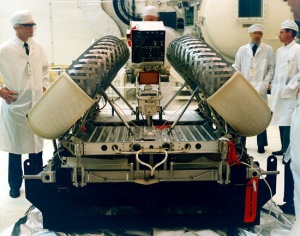 |
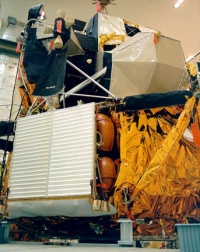
|
Speaking of the lunar modules, by the way, I happened to stumble across the photo below of the LEM’s mighty descent engine, which, as can be clearly seen, would have hardly taken up any room at all in the spacious spacecraft’s descent stage. Its fuel tanks wouldn’t have required much space either, so there should have been plenty of room left to stow a folding dune buggy in a curiously empty equipment bay.
To the is a NASA-approved image of the rover folded up and ready to pack into its assigned equipment bay, along with a photo of the folded rover allegedly stowed away on a LEM that has clearly seen better days. And here is a brief video clip of the deployment of the folded rover being demonstrated, presumably at the manufacturing plant.
As can be clearly seen, particularly in the video clip, the rover, as initially deployed, was far from complete. It seems to be missing such things as a floor pan, and seats, and cameras, and antennae, and battery packs, and various other components – which raises a few questions, such as where were all the other rover parts stowed? How many empty equipment bays were available to accommodate all the various rover components? And how long exactly did it take the astronauts, given the limitations imposed by their suits and gloves, to deploy and fully assemble a Moon buggy?
GM’s crafty R&D team, led by project manager Sam Romano and chief engineer Ferenc Pavlics, supposedly came up with the innovative folding rover concept in less than a month, and, in July of 1969, as Armstrong and Aldrin were allegedly taking man’s first steps on the Moon, GM was awarded the contract to design and build the rovers. GM quickly teamed with Boeing and got to work, with two significant challenges to overcome – the rover must fit into the assigned bay, and the total weight was to be kept to a maximum of 400 pounds. Also, the team had to move from concept drawings to mission-ready rover in just 17 months.
As with all other aspects of the Apollo program, those lofty goals proved surprisingly easy to achieve. By early 1971, GM and Boeing had already delivered their first mission-ready rover to NASA for final testing and approval. On July 31, 1971, just two years after the contract had been awarded, what remains to this day the only manned vehicle to allegedly land on an extraterrestrial body began kicking up Moon dust.
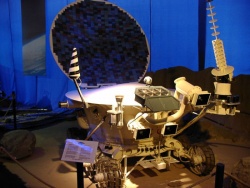 |
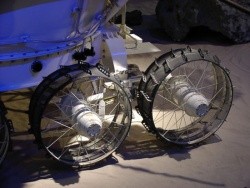
|
The finished product looked not unlike an Earth-based dune buggy, albeit with the unique ability to neatly fold away. The vehicle featured simultaneous front and rear steering and steel-mesh tires mounted on wheels that were each driven by their own separate motors. Power was supposedly provided by an array of batteries mounted on the front end of the rover.
Since no one really knew what kind of a vehicle would be required to drive on the Moon, early conceptual rovers ran the gamut from vehicles with massively oversized wheels to those propelled by tank-like tracks to Archimedean screws that would be able to burrow through the lunar dust like mechanical moles. Luckily, through extensive research and development, the Apollo team was able to deduce exactly which design components would allow the rovers to operate with maximum efficiency on the lunar terrain.
Or so the story goes. In reality, the rover team obviously had no time to do much at all in the way of research, development and testing. The Soviets, on the other hand, took the development of their Moon vehicle very seriously – seriously enough to spend an entire decade researching, developing and relentlessly fine-tuning every aspect of their robotic rover.
Dubbed the Lunokhod (the English translation of which is “Michael Jackson” … err, wait a minute, make that “Moonwalker”), the Soviet rover was an engineering marvel that was outfitted with an array of both still and television cameras as well as a wide assortment of testing equipment, including an X-ray spectrometer, an X-ray telescope, soil testing instruments, an astrophotometer, a laser retroreflector, a fluorescence spectrometer, and a magnetometer.
Lunokhod II, deployed in January of 1973, some thirty-seven years ago, to this day holds the record for having traversed further on an extraterrestrial body (about 23 miles) than any other robotic rover – considerably further than America’s two Mars Pathfinder vehicles combined.
So serious were the Soviets about testing their rover that, in the summer of 1968, they built a secret Lunodrom (Moondrome) in the remote village of Shkolnoye. Spanning some two acres, the Moondrome featured craters up to 50 feet in diameter and fake lunar rocks of all shapes and sizes. It would have been, needless to say, an excellent place to create fake Moon photos and television footage – though conventional wisdom, of course, holds that Soviet scientists and American scientists didn’t play well together in those days.
It’s hard though not to conclude that NASA basically appropriated the lunar rover research done by the Soviets as their own. According to a French documentary (Tank on the Moon), the Soviets did indeed spend many long years researching all the various means of locomotion that NASA claimed to study as well. And after doing so, Russian engineers (led by Alexander Kemurdjian, who NASA later consulted with on its Pathfinder project) came up with many of the same key design elements that would be utilized on NASA’s lunar rovers, such as the mesh tires and the independently powered wheels.
The Lunokhod vehicles had eight wheels, each with its own independent motor, suspension and brake. The rovers were ‘driven’ by a five-man team here on planet Earth, using panoramic images beamed back in real-time to guide the robotic vehicles. The design team had developed a special lubricant that would perform in a vacuum and they had enclosed each wheel motor in a pressurized housing. The vehicle’s batteries recharged via a collection of solar cells on the inside of the craft’s lid, which was kept open during the lunar day. During the frigid lunar night, the rover hibernated, kept warm by an internal radioactive heat source.
Lunokhod I set down on the Moon on November 17, 1970, just a few months before NASA took possession of the first mission-ready lunar rover. When that first rover allegedly arrived on the Moon eight months later, in July of 1971, Lunokhod I was still traversing the lunar landscape.
Part XII
23 February 2010
“As launch windows open and close, the next missions move forward. Two test flights of the lunar landing vehicle, and then the proposed landing on the Moon. And plans are in the making now which include fly-bys of other planets; visits to what Dr. Bunche calls neighbors.”
From Debrief: Apollo 8, a NASA promotional film circa 1968
Latest NASA space buzz
Just a few weeks ago, NASA Administrator Charlie Bolden boldly unveiled the agency’s new vision: “Imagine trips to Mars that take weeks instead of nearly a year, people fanning out across the inner solar system, exploring the moon, asteroids and Mars nearly simultaneously in a steady stream of firsts.” (“Launching a Broader Vision for NASA,” Los Angeles Times, February 2, 2010)
Yeah, and then imagine visiting a distant moon populated by ten-foot-tall blue people, which is slightly more plausible than NASA’s grandiose dreams.
Bolden’s ambitious proclamation was intended to put a positive spin on NASA’s acknowledgment that the Constellation Program, which President George W. Jetson had promised was going to put us back on the Moon by 2020, was being canceled. I’m sure we would have made it though were it not for the fact that President Blackbush doesn’t seem to want to fund the effort. Sure, he increased the agency’s budget for 2011, but he didn’t, you know, increase it enough. So the Constellation Program, which taxpayers have already reportedly shelled out at least $9,000,000,000 for, and which will reportedly cost another $2,500,000,000 to cancel, has been tossed on the scrap heap.
According to Bolden, things weren’t really going all that well anyway:
“Currently, [Bolden] said, the 5-year-old Constellation program is burning through billions of dollars and falling further behind schedule. The program couldn’t get American astronauts back to the moon until at least 2028 … ‘So as much as we would not like it to be the case … the truth is that we were not on a path to get back to the moon’s surface,’ Bolden said.”
Well, were we at least on a path to put together a better simulation of landing on the Moon?
Taking into account that the Constellation Program was begun in 2005, and that the Apollo program allegedly landed men on the Moon in a mere eight years, it would appear that it wouldn’t actually take twice as long to get back to the Moon with today’s technology, as previously advertised, but would actually take at least three times as long! If, that is, we were able to man-up and follow through with the plan, which obviously isn’t going to happen.
But be assured that that’s only because we don’t have the money. Otherwise, we totally would have made it back to the Moon. Possibly in less than twenty years. By which time all the technology that we know and love today will be as obsolete as pagers and Betamax video recorders, and trips to the Moon will still be something that we only talk about – sometimes nostalgically, as we fondly recall the fabled glory days from a decade few will remember, and sometimes with an eye to the future, a oft-promised future that never seems to arrive.
In May of 1966, after spending five years working on the Apollo project, we were just a-year-and-a-half away from the launch of the first Saturn V. In 2010, after spending five years working on the Constellation project, NASA has nothing to present to us but a hefty bill – which just goes to show that lack of technological sophistication and space-flight experience can apparently be easily overcome with a little determination … and a couple rolls of duct tape.
I was thinking, by the way, that if the idea of an Apollo reenactment were properly pitched to the right ‘reality television’ producers, we could probably make it back to the Moon in just a year or so. There was quite a bit of Apollo hardware that was left over after the sudden demise of the program, much of which is now in various aerospace museums – and aerospace museums tend to be run by aerospace geeks who would like nothing more than to see the U.S. triumphantly return to the Moon. It shouldn’t be that hard then to convince them to donate that hardware for it to be put to use for the purpose it was originally intended to serve.
We’re going to need to assemble all our donated hardware, of course, and for that we can turn to the guys at Monster Garage, who should be able to slap it together for us in a couple of afternoons. There will undoubtedly be some missing and/or non-operational parts, but that shouldn’t slow things down much; we can just give the guys over at American Pickers a call and they’ll scour America’s backroads to find the parts we need, or reasonable facsimiles. Once our reconstituted Saturn V rocketship is launch-ready, we’ll need to select a crew, and the most obvious choice, needless to say, would be Bear Grylls and his cameramen, with the Moonwalk footage broadcast as a special edition of Man vs Moon.
Unlike girlie-men like Neil Armstrong and Buzz Aldrin, Bear would undoubtedly show us a few tricks that the Apollo gang never thought of – like fashioning a shelter out of Moon rocks, foraging for the food and water that others failed to find, building a roaring fire despite the lack of both air and combustible materials, and finding several new and creative uses for the urine bags that his predecessors tossed aside as space trash. He could also probably design and build his own lunar rover from parts salvaged from artifacts of the Soviet Luna program. And he could probably do it all without the need for a spacesuit.
More on spacesuits and the coming space travel bonanza
Speaking of spacesuits, just a week before NASA shit-canned the Constellation Program, the agency announced that it had awarded a contract to Oceaneering International and the David Clark Company to design and build a brand-new, state-of-the-art spacesuit for use on future manned missions to the Moon and beyond (“NASA’s Next Space Suit,” Technology Review, January 25, 2010).
“If NASA returns to the moon in 2020 as planned, astronauts will step out in a brand-new space suit. It will give them new mobility and flexibility on the lunar surface while still protecting them from its harsh environment … The space agency has awarded a $500 million, 6.5-year contract for the design and development of the Constellation space suit.” Astronauts performing EVAs these days currently use something known as the Extravehicular Mobility Unit: “It has a hard upper torso, layers of material to protect astronauts from micrometeoroids and radiation, a temperature-regulation system, and its own life support and communication system. The EMU weighs over 300 pounds and has limited leg mobility – astronauts feet are normally locked in place on foot restraints while performing extravehicular tasks, and during Apollo missions, which used a different EMU suit, astronauts were forced to develop a bunny hop to traverse the lunar surface.”
I could, of course, point out once again the absurdity of it taking about four times as long to develop a spacesuit now than it did back in the hi-tech 1960s, but I’m pretty sure I’ve already beat that particular horse damn near to death and then rubbed salt in the wounds. I could also point out that the Apollo suits somehow managed to perform all the duties of the current EMUs while weighing about 40% less, but that’s also already taken a pretty severe beating.
So instead, I’ll focus on the contention that the Apollo astronauts were “forced to develop a bunny hop to traverse the lunar surface,” which, as an alert reader pointed out, flies in the face of numerous past claims in which it was maintained that the ‘bunny hop’ was found to be the most effective means of locomoting in a reduced gravity environment, not that it was something forced upon the astronauts by the limitations of the spacesuits. If I remember correctly, one of the Mythbusters propagandists claimed that he had verified that it was the most efficient means of moving in reduced gravity, and he was, by his own admission, wearing a costume and not a pressurized spacesuit when he conducted his experiment.
Someone, it would appear, is doing a little lying here. I am, needless to say, as shocked as all of you.
“When we went to the moon the first time, we were just trying to get there. Now astronauts need to be able to explore the surface, harvest resources, and do science,’ says Daniel Barry, vice president and director of research and development at David Clark Company, and head of the Constellation space suits project.”
So the Apollo missions, it turns out, were just about getting there. And the reason, I guess, why we allegedly flew men to the Moon eight times (including the alleged fly-bys by Apollo 8 and Apollo 13) was to, uhmm, prove that getting there the first time was no fluke. Sure, we were told that the boys were sent there to “do science” and that they took along a bunch of scientific testing equipment – and even, on the last flight, an actual scientist – but that apparently wasn’t really the case. And the lunar rovers allegedly flown to the Moon were not brought along to enable the astronauts to “explore the surface” and conduct additional science projects.
This time, however, we’re going to do it right … in another 20+ years, that is … if we fast-track it.
What “resources,” by the way, are we planning to “harvest”? We’ve already allegedly brought back numerous samples of Moon rocks, which appears to be about the only resource readily available, other than the water NASA now claims can be found there. How much does it suck, by the way, for NASA to have to cancel the Constellation Program right after the agency had reported allegedly discovering loads of water on the Moon?
One ‘debunker’ claim that has been made fairly frequently over the years, it should be noted, is that NASA’s alleged Moon rocks contain no traces of water, proving that they are not of Earthly origin and could only have come from the surface of a waterless sphere like the Moon … which isn’t, NASA now claims, waterless. I have no doubt though that those same ‘debunkers’ will be able to come up with some convoluted, hackneyed explanation for the apparent discrepancy.
Pictured below is the evolution of the American spacesuit. From left to right in the top row are the Mercury suit (1961), the Gemini suit (1965), and the pre-Playtex Apollo suit (1968); in the lower row are the famous Apollo magic suit (1969), the first space shuttle suit (1981), and the new suit being produced for the now-defunct Constellation Program. Below that, believe it or not, is an early prototype Apollo suit. While it may appear to be a still from some 1950s sci-fi flick, or a computer generated artist’s conception, it is, in fact, an actual suit being tested in the Mojave Desert in the mid-1960s. It is probably safe to assume that it didn’t pass the test.
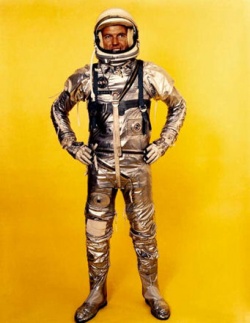 |
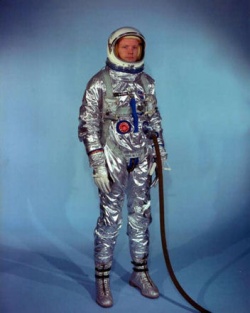 |
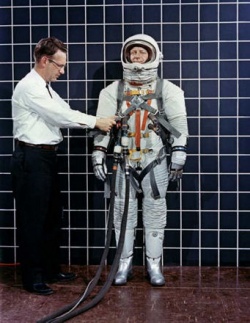
|
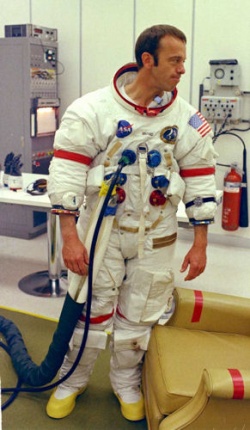 |
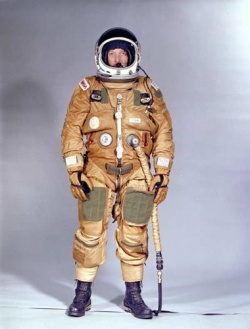 |
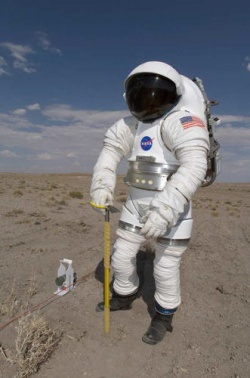
|
Another thing Bear Grylls would undoubtedly do is bring us back some of those dazzling lunar starscapes that the Apollo guys neglected to capture. Presented below, by the way, is one of NASA’s former [antwrp.gsfc.nasa.gov/apod/ap070621.html astronomy pics of the day]. It carried with it the following explanation: “If you could turn off the atmosphere’s ability to scatter overwhelming sunlight, today’s daytime sky might look something like this.” Below that is a shot from deep space, illustrating that stars in outer space maybe aren’t really as camera-shy as some would like us to believe.
According to Bolden, NASA had “focused so much of our effort and funding on just getting to the moon, we were neglecting investments … required to go beyond.” So while we don’t have the money required to get back to the Moon, you see, we do have the money to bypass the Moon and fly our guys to more distant locales, like Mars. No target date has been set, but I’m guessing that if we focus our attention on these bolder objectives, we’ll probably succeed by, like, 2050. Or maybe 2060. Or 2069, on the 100th anniversary of the first alleged Moon landing.
As will be recalled, we set our sights a little higher in the 1960s. When Kennedy delivered his famous declaration back in May of 1961 that we were going to the Moon, he gave the aerospace community less than a decade to make it happen. Engineers across the country, who were well aware of the fact that the nation hadn’t even taken its first baby-steps yet, were understandably dismayed.
The first Apollo contract was awarded just two months later, in July of 1961, for the sophisticated navigation system that would allegedly guide the spacecraft to the Moon. In an unusual move, NASA opted not to solicit bids for the guidance system; instead, the contract was handed directly to MIT, generating “immediate controversy,” as noted by Moon Machines. As one of the show’s talking-heads noted, “There was actually a budding industry out there that had developed guidance systems and people from industry were quite upset. They felt that they should have been given the chance to bid on the contract – and a university is not ordinarily what the government contracts out to build hardware for operational systems.”
There was, alas, nothing ordinary about the Apollo project.
General Draper and Die Frau im Mond
The man NASA turned to first, long before awarding any of the other Apollo contracts, was one Charles Draper, who ran MIT’s instrumentation lab, which would later carry Draper’s name. Draper was generally described as an eccentric, charismatic, colorful gent whose background was in physics and, curiously, psychology. He is widely considered to be the father of the inertial guidance system.
Perhaps significantly, Bill Kaysing, the first Apollo skeptic to gain prominence, has claimed that it was MIT (in conjunction with DARPA) that provided NASA with the blueprint for how to plausibly simulate manned trips to the Moon. If true, then it of course makes perfect sense that NASA would have turned directly and immediately to MIT, and would have done so without taking any outside bids. Until MIT completed their work and provided the space agency with an outline of the project, it would seem, NASA wouldn’t have known what other contracts to award.
The fact that the project landed on the desk of Charles Draper is perhaps significant, given that the name ‘Draper’ is a rather notorious one in twentieth century American history – and one that is closely tied to the name ‘Bush.’ It is a name that appears more than once on the membership list of everyone’s favorite secret society, Skull & Bones (Herbert Draper Gallaudet [1898], Arthur Draper [1937], William Draper III [1950]). It is a name that was prominently featured in the American eugenics movement, with General William Draper, Jr. serving as founder and chairman of the Population Crisis Committee and vice-chairman of the Birth Control League (as Planned Parenthood was originally known). General Draper, a close friend of the Bush family, also helped finance the 1932 International Eugenics Conference. Many years later, during the Apollo era, Draper advised LBJ on population reduction strategies.
The Draper family was also, not too shockingly, involved in the financing and maintenance of the Nazi regime. General Draper joined Dillon Read in 1927 and for many years was tasked with personally handling the account of Nazi industrialist/financier Fritz Thyssen. At the close of WWII, Draper was appointed Chief of the Economic Division of the Joint Allied Control Council for Germany – he was, in other words, the man who was supposed to oversee the economic de-Nazification of Germany. Just months later, in October 1945, Draper reported that the German economy had magically been de-Nazified. Needless to say, nothing could have been further from the truth.
One final note about General Draper (whose son, Bonesman William Draper III, served as the chief of fundraising for George Bush’s 1980 presidential campaign): he was a member of the Society of American Magicians. In other words, William Draper, Jr. considered himself to be something of an expert in the art of illusion. Perhaps the same could be said of Charles Draper of MIT.
According to Moon Machines, Draper and his team got to work on the Apollo guidance system in the spring of 1962. Given that Moon Machines also contends that the contract was awarded to MIT in early summer of 1961, the question that is naturally begged is: why, with the clock ticking and with an absurdly short timeframe to pull the Apollo project together, would the MIT team have waited almost a year to get started? Or did they, in fact, spend that first year working on their real assignment – mapping out the key elements of the simulation?
If so, then they apparently spent a fair amount of time viewing an obscure German silent film by the name of Die Frau im Mond (The Woman in the Moon), as noted in the painfully long documentary, What Happened on the Moon? The German feature film, released by filmmaker Fritz Lang in 1929, provided the blueprint for the heavily ritualized launch procedures that were adopted for the Apollo program. As can be seen in the screen caps below, all of the elements were there: the unnecessary vertical construction of the spaceship in a specially built hangar; the grand opening of the massive hangar doors; the excruciatingly slow roll-out of the upright rocketship from the hangar to the launch pad; the raucous crowds watching the spectacle live; the now ubiquitous countdown; even the shedding of two stages of the ship. In other words, the only elements of the performance that the public ever actually witnessed were all lifted directly from a forty-year-old silent film.
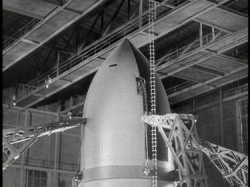 |
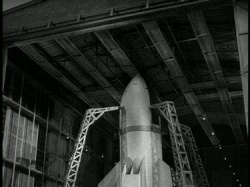 |
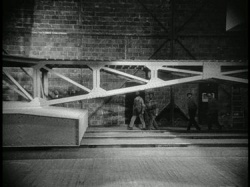
|
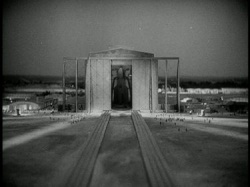 |
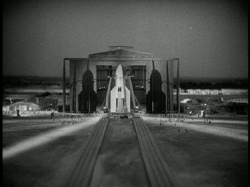 |

|
Fritz Lang’s technical adviser on the film was Herman Oberth, considered to be one of the three founding fathers of rocketry. Assisting Oberth on the film project, according to the previously quoted Time-Life book To the Moon, was one of his brightest students, nineteen-year-old Wernher von Braun. A decade-and-a-half later, both Oberth and von Braun would be scooped up through the Paperclip project and brought to America to work on, among other things, the Apollo program, whose choreography just happened to very closely match that of the fake Moon launch Oberth and von Braun had crafted forty years earlier.
Die Frau im Mond, by the way, was not the only Fritz Lang film that proved to be rather prophetic. He followed it up in 1931 with M, the tale of a sadistic, pedophilic serial killer guided by voices in his head. I wonder how he came up with that plotline?
Before moving on, I should probably point out here yet another brazen lie the ‘debunkers’ like to tell – the one that holds that von Braun was only a Nazi because he had little choice in the matter, what with living and working in Germany during the days of the Third Reich and all. That’s a nice little fable, to be sure, but it is contradicted in a big way by at least one known photograph in which von Braun can be seen adorned in the elite Nazi regalia of the Black Order of the SS. As anyone who has studied the Nazi hierarchy is well aware, Himmler’s elite order had a ‘no weekend Nazis need apply’ policy.
Anyway, returning to MIT, the starting point for engineers was to develop a gyroscope-based guidance system. The problem though was that gyros could not be produced to MIT’s exacting standards, resulting in gyro after gyro being rejected. Another problem was that translating data from the gyros into flight instructions would require, as Moon Machines noted, a “modern digital computer,” and putting such a beast in a spaceship “was an entirely new challenge.”
“Computers in the early 1960s,” you see, “were huge. The idea of squeezing such a monster into a spacecraft seemed preposterous.” But that wasn’t really going to be a problem since, as we have already seen, clearing seemingly insurmountable obstacles was something that the aerospace community was uniquely skilled at in the 1960s. The engineers working on the onboard computer utilized an entirely new technology known as the silicon chip. The technology was so new though that no one knew what it could actually do. And as with the gyros, it proved to be nearly impossible to produce chips of acceptable quality.
At the time, ‘software’ was a virtually unknown concept. As Moon Machines duly reported, “With nobody clear on exactly what the computer should do, the software engineers were free to write almost anything they liked.” One of those flight software developers, Alex Kosmala, made the following remarkable admission: “There were no specs. We made it up. Uhmm … and it’s always [been] amazing to me – why was I allowed to program something that hadn’t even been specified [but] that would be critical in assuring the success of the whole Apollo Program? I couldn’t believe it, but that’s the way it was. We made it up as we went along!”
I’m going to take a wild guess here and say that NASA probably wasn’t unduly concerned since the functioning of the software would only have mattered if the agency was planning to actually send guys to the Moon.
The most complicated aspect of the Apollo missions was the landing of the lunar modules, which made the software program controlling that part of the mission the most difficult to design. Amazingly though, that aspect of the software design was not assigned until after most of the other programs were 2/3 complete – and it was assigned to a twenty-two-year-old gent named Don Isles who had just recently started his very first job. According to Moon Machines, “the program without which it would be impossible to land on the Moon … had been written almost as an afterthought by a junior engineer.”
It is rumored that MIT first tried to pawn the job off on a kid who flipped burgers at the local McDonalds, but he apparently had prior commitments.
By mid-1966, Draper’s dream of controlling the entire mission via an onboard computer had been dropped in favor of an Earth-based control system with the Draper system along as back-up. MIT allegedly produced a computer the size of a small fridge, which both the command module and the lunar module were outfitted with. Despite the overwhelming obstacles faced by the MIT team, and the seemingly lackadaisical approach taken with the project, the Apollo guidance system, as would be expected, performed nearly flawlessly on every outing.
One final note here on Die Frau im Mond before wrapping up this installment: the gatekeepers over at the BAUT forum appear to be in on the joke. Why else would the site's logo contain not an image of NASA's lunar module sitting on the surface of the Moon, but rather a rocketship that looks suspiciously like the spaceship from Lang's film?
Part XIII
13 July 2010
“It’s a journey we can’t repeat with today’s technology, but in 1969, a group of astronauts risked everything to walk on the Moon.”
When We Left Earth, Discovery Channel, 2010
A little Mickey-taking
Let’s start this final (for now at least, though I reserve the right to revisit the issue should any uproariously funny new info become available) Apollo installment off with a quintet of extremely rare, previously-unreleased Apollo mission photos. Top, we get a good view of the sophisticated gyroscopic navigation system; next a shot of Neil Armstrong about to step out of the capsule and take those historic first steps on the Moon; and then an eerily familiar shot of a camera set up on a fake lunar surface in front of a fake lunar backdrop. In the bottom two images, we learn that an explosion in the ship’s oxygen tank has seriously threatened the mission of Apollo 13.
All of course are, yet more screen-caps lifted from Die Frau im Mond, that remarkably prescient silent film that featured the work of technical consultants who would later work on the Apollo missions – the same missions that “we can’t repeat with today’s technology,” though I’m assuming that we could probably put together much better simulations.
The good news to report here is that, after giving it a lot of thought, I believe that I may have finally figured out why it is that we can’t put together a ‘repeat’ performance: the problem, in a nutshell, is that America now has a serious obesity problem. As has been widely reported by our ever-vigilant media, the clear majority of Americans today are overweight, many of them grossly so, oftentimes even ‘morbidly obese.’ That definitely wasn’t the case in the 1960s.
America’s first spacemen, the Mercury 7 astronauts, weighed an average of just 164 pounds each. They were, nevertheless, considered full-grown men. The average three-man Apollo crew, therefore, probably weighed in at just under 500 pounds. Nowadays, that same three-man crew would probably weigh in at closer to 800 pounds. In addition, they would need to take roughly twice the volume of food and water rations that were needed in the ‘60s, and much larger fecal collection bags.
It is doubtful, in other words, that even the mighty Saturn V could handle the additional load requirements brought on by America’s rampant gluttony.
Speaking of fecal collection bags, by the way, Buzz and Neil purportedly left a few of those behind at the fabled Tranquility Base. I mention that bit of trivia only because those bags now are – and, as hard as it may be to believe, this is absolutely true – well on their way to being declared national historic landmarks! The state of California, ever the trendsetter, got the ball rolling in January by declaring those excrement bags to be state ‘historical resources.’ Four more states are expected to follow suit by year’s end.
Due to international treaties declaring that no country can lay claim to real estate on the Moon, you see, Tranquility Base itself cannot be declared a historic landmark. So California’s Historical Resources Commission, in its infinite wisdom, decided to declare that all the artifacts allegedly left behind are now “historical resources.” This is said to be a first step towards the site being declared a national landmark, and, ultimately, a UN World Heritage Site. The list of protected artifacts includes, specifically, human excrement bags. Seriously. (“Apollo 11 Excrement Claimed as Historic by California,” Technorati.com, January 29, 2010)
The concern, it is claimed, is that future lunar explorers, either from other nations or on privately funded missions, will run roughshod over the historic site, looting the valuable artifacts. The message California wants to send to such potential hooligans is that bringing home a souvenir sack of astronaut dung will be treated just as harshly as, say, snapping off a piece of the Great Barrier Reef. So if someone reading this should have the good fortune to be the first space tourist to visit Tranquility Base, please do the right thing and cordon off the area and maybe post a few signs informing people of the status of the artifacts. And as tempting as it may be, please refrain from bringing home a bag of astronaut shit as a souvenir.
As the state of California realizes, that astronaut shit was left there so that it could be enjoyed by everyone. And while it would undoubtedly look good on your fireplace mantle, fecal matter is best viewed in its natural habitat, just as Buzz and Neil left it. If you feel that you just can’t live without owning your very own sack of Buzz turds, I’m fairly sure that he would be willing to put one up for auction on E-Bay, given that he seems eager to whore himself out in every other conceivable way.
I’m also pretty sure, by the way, that this is the first time that a movement has been underway to bestow historical landmark status upon a site that existed only in our minds and on our TV screens. Should our next goal be to have Mayberry declared a UN World Heritage Site?
Scrap Constellation
In other news, Aldrin is in full agreement with NASA’s plan to scrap the Constellation Program and focus on low-Earth orbit flights, with an eye to sending men to Mars at some unspecified time in the future. According to Buzz (who couldn’t see stars from the Moon, which may be why he didn’t have much luck dancing with them), “getting long-range space flight right requires getting near-Earth orbit perfect … Just as deep sea exploration began with practice in our littoral waters, a successful Mars mission begins with near-Earth orbit testing. To get to the final stage, we must perfect all that we’ll need for the journey.” (“Trading the Moon for Mars,” New York Times, February 25, 2010)
The first question that comes to my mind, obviously, is: when did Aldrin become such a fucking pussy? I mean, we obviously didn’t have low-Earth orbit anywhere near “perfect” in 1969, but that didn’t stop him from allegedly blasting off to the Moon, which I would think would qualify as a “long-range space flight.” And exactly how much “near-Earth orbit testing” will be required to “perfect all that [they’ll] need for the journey”? Back in the good ol’ Apollo days, if I recall correctly, we didn’t need to send so much as a single manned Saturn V into low-Earth orbit before allegedly sending one all the way to the Moon!
Buzz’s old sidekick, as it turns out, begs to differ. According to Space.com, Armstrong “blasted NASA’s new plans for future space exploration ... The United States is risking losing its role as a leader in space exploration with its new plan, Armstrong said, adding that he was concerned with the looming gap in American human spaceflight.” Fellow Apollo astronauts Jim Lovell and Eugene Cernan are also unhappy with the change of direction. Speaking before a Senate subcommittee, Cernan had this to say: “We (Armstrong, Lovell and myself) have come to the unanimous conclusion that this budget proposal presents no challenges, has no focus, and in fact is a blueprint for a mission to nowhere.” (“Neil Armstrong: Obama’s New Space Plan ‘Poorly Advised,’” May 12, 2010)
Cernan and his fellow Apollo astronauts, needless to say, know a little more than the rest of us do about taking a “mission to nowhere.”
UFOs Aliens and fecal matter
And now, with that out of the way, let’s turn our attention to UFOs and aliens (the saucer-flying kind, not the currently popular jumping-the-border-fence variety), which figure rather prominently in some Apollo ‘conspiracy theories.’ One such theory holds that we did indeed make it to the Moon in the 1960s – only to encounter either active alien colonies or artifacts of past alien colonies. As the story goes, we were either scared off or warned off and have therefore never returned. These theories generally hold that the early Apollo missions succeeded but that the later ones had to be faked – because we were, you know, scared to go back and piss off the aliens.
We can only hope, by the way, that the Moon’s resident aliens have little interest in human fecal matter and have therefore left Buzz’s and Neil’s “historical resources” untouched. Of course, most readers are probably aware of the fact that many aliens have an intense fascination with anal probes, so it seems quite likely that other things associated with the anus would be of interest to them as well.
The other predominant alien theory (which often appears hand-in-hand with the first) seems to be that we did indeed make it to the Moon – but not with the ridiculous hardware of the Apollo program. That was all for show, you see, to cover up the real technology that was used, which invariably is said to be technology that was retro-engineered from the recovered alien spacecraft that Mulder and Scully keep hidden out at Area 51.
Both theories, in other words, posit that we did indeed send men to the Moon, though the home audience was lied to about the details of the missions – specifically, how we got there and/or what we found there.
Some of these theories go so far as to say that there are artifacts of alien colonies on Mars as well, and/or that Mars has already been secretly colonized by us Earthlings. One of President Eisenhower’s granddaughters, for example, has been making the rounds lately claiming that she was targeted for some sort of ongoing Mars colonization project involving all kinds of exotic technology that is in the hands of various secret societies. Or something like that. The details aren’t really important.
Many of the folks who tell such tales also like to claim that it was NASA itself that seeded into the conspiracy literature the notion that we never made it to the Moon. Better for the skeptics in the crowd to buy into that scenario, so the story goes, than to figure out the ‘truth’ – that our Moon has been taken over by hostile aliens (or whatever other equally dubious alien theory it is that is being promoted).
To anyone with a working brain, of course, it should be perfectly obvious that it is actually the opposite that is true – that it is in fact the alien theories that pose the least threat to the status quo, for two rather obvious reasons: first, the alien theories generally hold that we did actually send men to the Moon, so they pose no direct challenge to the core lie of the Apollo Program; additionally, these theories contain deliberately outlandish elements that are designed to marginalize ‘conspiracy theories’ and drive most sane people away not only from Apollo theories, but from the entire field of conspiracy literature.
Anyone who has spent time in the conspiracy trenches should recognize a very obvious pattern, and one which is certainly not unique to Apollo. A substantial body of solid research on what really happened on September 11, 2001, for example, has been tainted by the deliberate introduction of such inanities as ‘pod’ planes, holograms and particle beam weapons. Compelling evidence of the existence of elite international pedophile rings, on the other hand, has been marginalized by blending in stories of shape-shifting alien/human hybrids. And so it goes.
While we’re on the subject of aliens, I’m sure that it was just a coincidence that Erich von Daniken’s Chariots of the Gods was released just months before the first alleged Apollo Moon landing and then relentlessly promoted into runaway bestseller status (Chariots and its sequels have reportedly sold in excess of 60 million copies). The book, which purported to present evidence of alien visitations in days of yore, firmly planted two ideas in the minds of many readers: long-range space travel was not only possible, but had already occurred; and aliens were all around us, keeping an eye on the planet.
Interestingly enough, some of America’s illustrious astronauts have themselves seeded the literature with alien tales. None of them, to my knowledge, has ever endorsed the notion of alien colonies on the Moon, but they have certainly added fuel to that fire by dropping allusions to UFO sightings. Our old friend Buzz Aldrin, most notoriously, has claimed that Apollo 11 was tailed all the way to the Moon by a UFO!
Why do you suppose it is, by the way, that the ‘debunker’ crowd seems to have little to say about the UFO tales told by America’s astronauts? After all, these very same ‘debunkers’ damn near go into cardiac arrest whenever a ‘conspiracy theorist’ such as myself either implicitly or explicitly calls into question the integrity and honesty of America’s virile astronauts. But if we are supposed to accept as truth everything that they have to say about their alleged lunar missions, then doesn’t that mean that we necessarily need to embrace their claims about UFOs? Those stories are, after all, part of the package. If the ‘debunkers’ are so sure that our astronauts can be trusted to tell us the truth, the whole truth and nothing but the truth, then why do the ‘debunker’ sites not trumpet the existence of the UFOs that were allegedly witnessed by their knights-in-magic-spacesuits?
Speaking of the ‘debunkers,’ it appears that the most prolific of them, Jay Windley (who posts under the nom de poofter Jay Utah – and undoubtedly under various other pseudonyms as well, thus creating the appearance of ‘peer’ acceptance of his pompous posturing), has provided an answer to one of the other enduring mysteries of the Apollo Program. According to a particularly grandiose claim made on a discussion board by Windtunnel (he apparently doesn’t like being referred to as Windbag), he “personally can produce drawings and analysis of the LM (lunar module) structural, pressure, and thermal designs from memory.”
So it seems that NASA did not, in fact, lose and/or destroy the original plans and specs for the lunar modules; the agency instead decided to store that invaluable data in Windley’s spacious head.
Let’s back up now to 1962, to review a bastard stepchild of the U.S. space program known as Operation Fishbowl, which was without a doubt one of the most ill-conceived operations ever undertaken by the brain-trust in Washington. In a nutshell, Fishbowl was a series of rocket launches aimed at detonating nuclear weapons at high altitudes. Why? Washington was rather coy about that, but I’m sure that they had perfectly valid reasons for conducting high-altitude nuke tests.
A number of the rockets powering those flights failed, one quite spectacularly and devastatingly. Four of the launches succeeded in reaching altitude and detonating, but those ‘successes’ came at a price, as we shall see. Most of the warheads were mounted on Thor rockets, similar to the one pictured below. All were launched from Johnston Island in the Pacific … because we’ve always found bucolic islands in the Pacific to be really good places to do nuke testing.
The first warhead, codenamed Bluegill, was launched on June 2, 1962, but the radar tracking system failed and, with no way to verify the rocket’s trajectory, it had to be destroyed in flight. The second warhead, Starfish, took flight on June 19, 1962, but the rocket failed after burning for just under a minute and the craft once again had to be destroyed in flight. Missile debris, some of it radioactive, rained down on the island and the surrounding waters. A couple guys were dispatched with brooms and dustpans and the project was quickly resumed.
The next launch, on 9 July 1962, was the first to ‘succeed.’ It was also, according to some theorists, the one that was supposed to accomplish a key goal of the program: blasting a hole through the van Allen radiation belts to hopefully allow for the safe passage of the Apollo spacecraft. Starfish Prime, a 1.4 megaton nuclear warhead, detonated at an altitude of about 250 miles. If theorists are correct about the prime objective, the test failed miserably. Instead of punching a hole through the belts, the blast actually created an additional, man-made radiation belt! It also damaged as many as nine U.S. and Soviet satellites, six of which failed within months of the test. And it caused electrical damage in nearby Hawaii.
The next attempted launch – which was apparently undertaken because, as should be obvious, the program was going so well – failed on the launch pad and the Thor rocket exploded, causing extensive radioactive contamination of the area as well as the destruction of the launch pad. The spectacular failure of Bluegill Prime, on July 25, 1962, necessitated a brief break.
The launches resumed on October 15, 1962, with a third attempt to launch the Bluegill warhead. That test, Bluegill Double Prime, failed when the rocket went into a serious tumble not long after taking flight. It was, once again, destroyed in flight. Next up was Checkmate, just four days later. Checkmate detonated at an altitude of about 91 miles, considerably lower than the previous ‘success,’ and with a smaller payload.
The next launch was the fourth attempt at Bluegill, dubbed Bluegill Triple Prime. Not many years later, of course, we would get much better at that whole rocket-launching thing (despite the fact that the Saturn V’s F-1 engines were notoriously unstable), eliminating the need for such flights as, for example, Apollo 12 Double Prime (“Goddamnit!! We lost another one?! How many more crews do we have back there? None?! Shit! Can somebody run down to the Home Depot and pick up a few guys and get them suited up?”)
Bluegill Triple Prime detonated on October 25, 1962, at an altitude of only about 30 miles. I think we can probably all agree that getting an unmanned rocket to an altitude of 30 miles in just four attempts, at the very same time that the manned Mercury missions were allegedly attaining low-Earth orbit on every launch, was quite a stunning achievement. In any event, the last of the Fishbowl launches was on November 1, 1962. Dubbed Kingfish, it detonated at about twice the altitude of the previous blast. And so ended a largely forgotten corollary of the U.S. space program.
Moving on, I happened to stumble upon a couple of fascinating articles on Space.com – and by “fascinating,” I mean that they unintentionally raise questions about the legitimacy of the Apollo missions, as so frequently happens whenever NASA types talk about going ‘back’ to the Moon.
In one of the articles, we find Michael Wargo, identified as the “chief lunar scientist for Exploration Systems at NASA Headquarters,” contemplating a return trip to the Moon: “’None of our spacesuits that we currently have would be appropriate for that extreme an environment,’ [says Wargo]. Any materials built for Earth-like temperatures won’t work on the moon. ‘They don’t bend anymore, they fracture, and they fracture brittle-y, and so everything gets extremely brittle at those temperatures.’” (“Water Discovery Fuels Hope to Colonize the Moon,” November 13, 2009)
And so we discover that there is yet another piece of 1960s technology that has now fallen into an all-consuming black hole: non-brittle materials from which to fashion spacesuits suitable for lunar exploration. Back in the day, it will be recalled, Playtex’s bra seamstresses knew a thing or two about stitching together a non-brittle spacesuit.
In the same article, Jack Burns, of the Center for Astrophysics and Space Astronomy at the University of Colorado, Boulder, and director of the Lunar University Network for Astrophysics Research, claimed that, “We only went to the moon six times and we didn’t even go to the most interesting places on the moon. There’s so much more to discover about the moon just from a scientific perspective, what it can tell us about the formation of the Earth.”
So ... what’s that story again that the ‘debunkers’ like to tell about there being no compelling reason to go ‘back’ to the vast wasteland that is the Moon? Who am I supposed to believe here – the guy with all the fancy academic titles, or the guys whose primary area of expertise seems to be mastering the art of self flagellation?
The other article from Space.com details yet more of the lost technology of the 1960s: “Though engineers are well on their way to preparing us for life on the moon, some major issues have yet to be resolved. ‘Something that we’ll have to consider is radiation,’ Zacny (with Honeybee Robotics, a NASA contractor) said. ‘We can close ourselves in habitats, but radiation protection requires a lot of shielding. We cannot solve this problem yet. Radiation can kill us.’ Moon dwellers will also have to contend with the ubiquitous dust on the surface of the moon, which gets into everything and can wear down joints and connectors and prevent sealing off doors. It also poses a health risk to people, as it can cause breathing difficulties and is difficult to filter out of habitats.” (“How to Build Lunar Homes From Moon Dirt,” September 3, 2008)
The radiation problem has already been covered, both here and elsewhere, so let’s focus instead once again on the dust problem. As previously discussed, NASA nowadays acknowledges that dealing with lunar dust will require the development of sophisticated new technology. No explanation has been provided, of course, for why the Apollo astronauts didn’t have any problems with the dust despite allegedly venturing out on multiple EVAs during their alleged missions.
During the alleged Apollo 17 mission, for example, our fearless astronauts supposedly took the Moon buggy out on three separate occasions, returning each time, by their own accounts, covered from head to toe in Moon dust, which they necessarily would have brought back into the lunar module with them, and then ultimately transferred to the command module when the supposed docking later took place. Why then is there no mention in the Apollo literature of any health problems arising from this, or of any problems with any of the delicate instrumentation, or of any problems with any of the door seals? If it is “difficult to filter out of habitats” even with the technology we possess today, then how were we able to do it 40+ years ago?
The ‘debunker’ crowd, despite loudly proclaiming that they have thoroughly debunked every ‘conspiracy’ claim that has ever been made, has had nothing to say on this issue. I wonder why that is?
No seriously, I really do wonder why that is. It would be understandable if there were some requirement that their ‘debunkings’ have some actual merit, but their body of ‘work’ clearly demonstrates that they are not bound by any such restrictions. So the silence is a bit puzzling.
Before signing off, there is one final point that needs to be addressed here – one that has been on my mind since first undertaking this series. It is generally claimed, as previously noted, that getting to the Moon from low-Earth orbit is a relatively straightforward procedure: you simply accelerate enough to ‘slingshot’ out of low-Earth orbit, thus escaping Earth’s gravitational pull, and then just sort of freefall to the Moon, firing the engines every now and then to make minor course corrections.
That all sounds just fine in theory … until you take a step back and realize that the Moon itself is a satellite of the Earth, held in place by – you guessed it! – Earth’s gravitational attraction. Isn’t that, after all, what keeps it from drifting randomly about the solar system, whoring itself out to any planet that would have it? So I guess the obvious question that is begged here is: when exactly is it, while traveling from the Earth to the Moon, that one leaves Earth’s orbit?
The answer, quite obviously, is, uhmm, never. Earth’s gravitational pull would obviously get progressively weaker the farther out one ventured, but common sense dictates that it wouldn’t just abruptly end once you got beyond low-Earth orbit. Indeed, an article that appeared in various newspapers not long ago noted that the satellites that enable GPS devices to work orbit the Earth at an altitude of roughly 12,000 miles, about 11,800 miles beyond low-Earth orbit. And yet they are, miraculously enough, still held in place by Earth’s gravity and there have been no reported cases of one of them suddenly freefalling to the Moon.
There would come a time during a journey to the Moon when that body’s own gravitational attraction would be stronger than that of Earth, but given the relative masses of the two bodies, that time wouldn’t come until the tail end of the trip. You could conceivably freefall most of the way back, but you would first, of course, have to actually get there.
I guess what I am trying to say here is that I’m not really buying into the claim that you wouldn’t need much fuel to get to the Moon after reaching low-Earth orbit. Logic would seem to dictate that the path to the Moon would not be the largely linear one we have been sold on, but rather a series of steadily increasing circles (probably ellipses, actually), requiring the expenditure of considerable amounts of fuel.
Perhaps that is the reason why the Space Shuttle has never done a lunar fly-by, or left low-Earth orbit for any other reason. Of course, there are also the problems posed by space radiation, and extreme temperatures, and micrometeorites, and reentry, and ...
Part XIV
12 May 2011
Post-script
As I noted in the last Apollo post, “whenever NASA types talk about going ‘back’ to the Moon,” they invariably seem to “unintentionally raise questions about the legitimacy of the Apollo missions.” And sure enough, the boys over at Lockheed Martin (one of NASA’s longtime partners-in-crime) certainly didn’t let me down in that regard with this latest proposal.
Before proceeding, I should probably first clarify here that the proposed missions are not so ambitious as to involve actually landing on the Moon. No, these proposed missions involve merely flying to the Moon’s far side and then sort of hanging out in Lunar orbit for a couple of weeks. In other words, all of the most technologically demanding aspects of the alleged Apollo missions – like actually landing on the Moon, surviving on the Moon, lifting off from the Moon, and docking while in Lunar orbit – have been eliminated.
Even these far less ambitious missions, of course, won’t actually happen – but let’s play along while Space.com’s “Space Insider Columnist,” Leonard David, fills us in on what we have to look forward to (“Mission Proposed to Send Astronauts to the Moon’s Far Side,” November 23, 2010):
“While NASA has officially given up its plans to send humans back to the surface of the moon anytime soon, a contractor is proposing a mission to send a crew to a stationary spot in orbit over the far side of Earth's neighbor. Lockheed Martin has begun pitching an L2-Farside Mission using its Orion spacecraft under development … The Earth-moon L2 Lagrange point is where the combined gravity of the Earth and the moon allows a spacecraft to hover over one spot and be synchronized with the moon in its orbit around the Earth. From a halo orbit around that L2 point, a crew would control robots on the lunar surface. Teleoperated science tasks include snagging rock specimens for return to Earth from the moon's South Pole-Aitken basin – one of the largest, deepest, and oldest craters in the solar system – as well as deploy a radio telescope array on the farside.”
Everybody got all of that? Sounds pretty easy, doesn’t it? After all, the bar has been set substantially lower than it was in the glorious 1960s, when we easily mastered such things as landing men on the Moon, walking on the Moon, driving dune buggies on the Moon, and playing golf on the Moon. Nevertheless, there are some potential problems – just as there are, as is usually the case, some aspects of these proposed missions that directly contradict the entrenched, though slightly insane, belief that we sent men to the Moon back in the days when telephones were heavy enough to be used as lethal weapons.
Let’s begin with one of the stated benefits of these proposed missions, as listed in a Lockheed Martin ‘white paper’ and laid out by Daniel Bates of the UK’s Daily Mail (“Astronauts to be Sent to the Far Side of the Moon for First Time in 40 Years in Pre-Mars Mission,” November 25, 2010):
“Both [NASA and Lockheed Martin] would also have the chance to address the problem of a higher re-entry speed which is accumulated on trips further away from the Earth.”
There they go again, pretending as though we’ve never done this before! Already we have heard from NASA types about how we haven’t yet solved the radiation problem, and how we haven’t yet developed spacesuit materials capable of withstanding the temperature extremes on the Moon, and how we haven’t yet solved the problem of how to deal with all that Lunar dust … and now we find that we apparently also haven’t yet worked out how to deal with the fact that spacecraft returning from the Moon would have to survive much higher re-entry speeds than spacecraft returning from low-Earth orbit! And I’m guessing that we might also have a problem with controlling the all-important reentry angle.
At this point, I really am beginning to wonder if there is any of that classic 1960s space technology that hasn’t been lost? Perhaps NASA needs to hire a crack team of archeologists to dig through their warehouses.
Another problem arises from the proposed duration and timeline of the missions. According to Space.com, “Each flight would prove out the Orion capsule’s life support systems for one-month duration missions.” Later in the same article, we find that on each mission, our fearless astronauts “would orbit the L2 point for about two weeks.” It would appear then that Lockheed and NASA are allowing a full two weeks to travel to and from the Moon – which would be all well and good were it not for the obvious fact that it is roughly twice the time that it took for the mighty Apollo craft to allegedly get to the Moon and back!
The 1960s was, as some will surely recall, the era of ‘muscle cars,’ so perhaps it was the era of ‘muscle spaceships’ as well. But since we have now apparently sacrificed raw power in favor of fuel economy, I guess today’s spaceships just don’t burn rubber like the spacecraft of the wild and wooly ‘60s – though there is, I suppose, an alternative explanation: the last forty years of space research has taught us that it would actually take twice as long to get to the Moon as was believed back when we faked the Apollo flights.
According to Josh Hopkins of Lockheed Martin, in order to achieve the not-so-lofty goal of sending men out to orbit the Moon, the company’s Human Spaceflight Advanced Programs division has “come up with a sequence of missions that [they]’ve named ‘Stepping Stones,’ which begins with flights in low Earth orbit and incrementally builds.” Lockheed views the first Orion missions as “feasible by 2016 to 2018.”
Do I really need to belabor the point that, back in the days when mankind was transitioning from the use of stone tools, we didn’t need any ‘stepping stones’ to get to the Moon – the very first manned launch of an Apollo craft allegedly flew its crew all the way there and back without a hitch! And do I also need to once again point out that, despite setting our sights much lower, and despite having vastly improved technology to work with, and despite having an additional fifty years of spaceflight experience, it will still take just as long to get men near the Moon as it did in the 1960s to actually walk on the Moon?
Returning now to the alleged benefits of running these missions, we find that Lockheed’s ‘white paper’ also talks about being able to
“measure astronauts’ radiation dose from cosmic rays and solar flares to verify that Orion provides sufficient protection, as it is designed to do. Currently the medical effects of deep space radiation are not well understood, so a one-month mission would improve our understanding without exposing astronauts to excessive risk.”
So despite the fact that some forty-three years have now passed since we first allegedly sent men into deep space, we still don’t really know anything about the effects of deep space radiation … but we are pretty sure, apparently, that a thirty-day dosage is a good, safe place to start! And just to be on the safe side, we could always pull Buzz and Neil out of retirement to pilot the first flight. They can’t have too many years left in them anyway.
In all seriousness, NASA initially considered for the Apollo missions, according to “To The Moon” (a Time-Life Book), “men doomed by fatal disease.” Also considered were “midget[s], to cut the payload weight.” They said it, not me. I would have used a more politically correct term. Imagine though, if NASA had followed through on that idea, what kind of records could have been set in the Midget Toss?
One final curious aspect of these latest proposed missions that we need to delve into was explained by Space.com:
“The robotic lander and rover would be launched first on a slow but efficient trajectory to the moon, to ensure that the rover is on its way before risking the crew launch.”
Say what?! Are you kidding me? What kind of girly-men are these new breed of astronauts? Stepping stones? Supplemental launches before “risking the crew”? Can’t we just find some real men like John Glenn and Alan Shepard to pilot the Orion craft? And what is this nonsense about a “slow but efficient trajectory to the moon”? “Efficient” in what way? Last time I checked, the ‘debunkers’ were still claiming that getting to the Moon was pretty much a matter of just free-falling your way there. What could be more efficient than that?
Oh wait ... I remember now. As I pointed out in the last Apollo post, getting to the Moon does not actually involve free-falling. It involves battling the Earth’s gravity by flying in ever-increasing ellipses. And burning lots and lots of fuel. And Lockheed’s oblique reference to a “slow but efficient trajectory” is, in fact, a confirmation of that. And so, by the way, is this artist’s conception of the proposed Orion missions, which shows the spacecraft outside of low-Earth orbit and yet clearly still burning its engines.
Following the launch of the lander and rover (both of which, it will be recalled, stored easily aboard the Apollo flights), “three astronauts would be launched in an Orion spacecraft. If NASA has built a heavy lift launch vehicle by then, it would be capable of launching the crew directly to the moon. If that mega-booster is a no-show, smaller rockets can be used instead, but a more complex arrangement would be required. First, Orion would be launched to low-Earth orbit on a rocket such as a Delta 4 Heavy. Then, a modified Centaur upper stage would launch on a separate rocket. Orion would dock to the Centaur stage in orbit, and the Centaur would boost Orion toward the moon.
To briefly recap then, we now know that getting three men near the Moon in modern times is considerably more difficult than landing three men on the Moon was in ancient times. It now requires taking a number of baby-steps before taking the big plunge. And it requires the launch of three separate high-tech spacecraft. And it will take the astronauts a full week to get there, as there are now speed limits in deep space that are strictly enforced and the U.S. can not afford to have another moving violation on its record. The equipment, of course, will take even longer to get there, because it’s on a slower and more efficient course. And we may have some problems to work out in regards to deep space radiation and reentry speed.
And even after all of that, needles to say, we won’t be actually landing men on the Moon. That would probably require an additional ten years of baby-steps and the launch of at least five spacecraft. And since we’ll be checking out the far side on these proposed missions, we still won’t be able to verify all those Apollo artifacts supposedly littering the Moon. Which is really kind of a moot point, because we won’t actually be going at all.
Speaking of the far side of the Moon, by the way, the Daily Mail noted that the “surface was first photographed by Luna 3, a Soviet probe, in 1959 then the Apollo 8 mission followed in 1968 but there has been scant exploration of it since.” Translation: there has been no exploration of the far side since 1959, and it would be nice if the Daily Mail would throw in a comma now and then.
But enough about that. Let’s move on to a different topic. Remember how I argued that if it were possible to send crews to the Moon, private enterprise would have a strong financial incentive to have done so to exploit any available resources? And remember how the ‘debunkers,’ not surprisingly, claimed that there was nothing much on the Moon to see or do, especially since the strip club was shut down over some zoning dispute, so there was not really any compelling reason to go back? Well, it turns out – and this is quite shocking – that the ‘debunkers’ may be lying once again. As the LA Times reported on April 8, 2011 (W.J. Hennigan “MoonEx Aims to Scour Moon for Rare Materials”):
“A team of prominent Silicon Valley entrepreneurs are shooting for the moon with a new private venture aimed at scouring the lunar surface for precious metals and rare metallic elements. The private company Moon Express Inc., or MoonEx, is building robotic rovers alongside scientists at NASA’s Ames Research Center northwest of San Jose. MoonEx’s machines are designed to look for materials that are scarce on Earth but found in everything from a Toyota Prius car battery to guidance systems on cruise missiles. While there is no guarantee the moon is flush with these materials, MoonEx officials think it may be a ‘gold mine’ of so-called rare earth elements.”
The company won’t, naturally enough, be sending any human cargo to the Moon, because that isn’t really possible, but the point here is that there are in fact compelling reasons for ‘return’ flights to the Moon, for both financial and scientific gain, so there is no validity at all to the argument that no one has been back for some forty years simply because there is no reason to go back.
Let’s briefly return now to Operation Fishbowl, which was also discussed in the last Apollo offering. Unbeknownst to me until very recently, NPR decided to dredge up the nearly fifty-year-old high-altitude nuke tests less than two weeks before I did (Robert Krulwich “A Very Scary Light Show: Exploding H-Bombs In Space,” July 1, 2010). And the facts they brought to the table were rather compelling.
“If you are wondering why anybody would deliberately detonate an H-bomb in space, the answer comes from a conversation we had with science historian James Fleming of Colby College.” According to Fleming, who has been busily reading through James Van Allen’s papers while working on a biography, “a good entry point to the story is May 8, 1958, when James Van Allen, the space scientist, stands in front of the National Academy in Washington, D.C., and announces that they’ve just discovered something new about the planet.”
What Van Allen’s team had discovered, of course, was that Earth is ringed by belts of high-energy particles, now known as the Van Allen radiation belts. And what Fleming’s recent research revealed, incredibly enough, is that the “day after the press conference, [Van Allen] agreed with the military to get involved with a project to set off atomic bombs in the magnetosphere to see if they could disrupt it.”
Let’s pause here for a moment to reflect on the almost unfathomable level of megalomania at play here: immediately upon learning of the existence of the radiation belts, the military/intelligence complex decided, without even giving it much thought, that it would be a great idea to attack said belts with atomic weapons! And the ‘scientist’ who had made the discovery immediately agreed that that was a swell idea! As Fleming noted, “this is the first occasion I’ve ever discovered where someone discovered something and immediately decided to blow it up.”
Never mind that the belts are there to shield the planet from incoming space radiation, and that their existence is one of the primary reasons that biological lifeforms can thrive on this sphere … let’s just see if we can blow a big fucking hole in them! It apparently never occurred to the geniuses in Washington that if you blow a hole in the belts to, say, allow for the safe passage of spacecraft, you would also presumably allow for the unsafe passage of massive amounts of incoming, and very lethal, radiation.
This, dear readers, says a lot about the true nature of the men who rule behind the curtain. What hubris is required to put at risk every living creature on this planet, and do so without even giving it a second thought, for the dubious purpose of facilitating space missions that were never going to actually take place? And bear in mind, by the way, that these ‘tests’ took place during the tenure of a nearly mythical figure known as John Fitzgerald Kennedy. For those then who are inclined to believe that the sitting President actually calls the shots, I would suggest taking a little time to contemplate why it is that the man who many consider to have been a knight-in-shining-armor was the man who gave the thumbs-up to the most recklessly arrogant nuclear weapons tests ever conceived?
The first such tests were conducted in 1958, almost immediately after the discovery of the radiation bands. But those tests used just lowly ol’ atom bombs, and according to NPR, “Atom bombs had little effect on the magnetosphere.” Which is why in 1962, the powers-that-be decided to up the ante by using hydrogen bombs … really, really big hydrogen bombs. How big? Starfish Prime, the most ‘successful’ of the ‘tests,’ was tipped with a warhead 100 times as powerful as the bomb that leveled Hiroshima!
As detailed by NPR, “The plan was to send rockets hundreds of miles up, higher than the Earth’s atmosphere, and then detonate nuclear weapons to see: a) If a bomb’s radiation would make it harder to see what was up there (like incoming Russian missiles!); b) If an explosion would do any damage to objects nearby; c) If the Van Allen belts would move a blast down the bands to an earthly target (Moscow! for example); and – most peculiar – d) if a man-made explosion might ‘alter’ the natural shape of the belts. The scientific basis for these proposals is not clear.”
Objective “a” roughly translates to: “we had to do it to protect ourselves from those crazy Russkies!” Those with atypically long memories may recall that before the collapse of the international Communist threat neatly coincided with the rise of the international Terrorist threat, that was pretty much the all-purpose excuse for all manner of heinous activities undertaken by the Western powers. The main problem here though is that Starfish Prime was detonated at an altitude of 250 miles, roughly 50 miles beyond low-Earth orbit, and I’m reasonably certain that Soviet ICBMs weren’t designed to fly at anywhere near that altitude.
Moving on to “b,” I feel fairly confident in saying that even back in 1962, at the tender age of two, I could have provided an answer to that question, and that answer would have been: “Yes, detonating a very large hydrogen bomb will cause extensive collateral damage. Duh!”
Proceeding to “c,” I’m afraid I’m going to have to respectfully disagree with NPR on its decision to label “d” as the most peculiar. Attempting to take out Moscow in a nuclear holocaust redirected through the Van Allen belts has to rank pretty high up on the peculiarity scale. And what would be the point? Plausible deniability? “Looky what just happened to Moscow! It’s as if God himself struck a blow against the Evil Empire! I damn sure know we didn’t do it!”
As for “d,” altering the natural shape of the belts appears to have been the primary goal. Because as we all know, man can always improve upon the natural order of things. And it was immediately apparent, right from the time of their discovery, that the shape of the belts was entirely wrong for this planet. Sure, they would have been fine for, say, Mars or Venus – or even Pluto, before it was rudely kicked out of the Fraternity of Planets – but they were clearly unfit to circle this planet. So we had to try to fix them.
Luckily, we failed.
